#i have no idea how ice / alpine climbing works
Explore tagged Tumblr posts
Text
yay hunter climbing
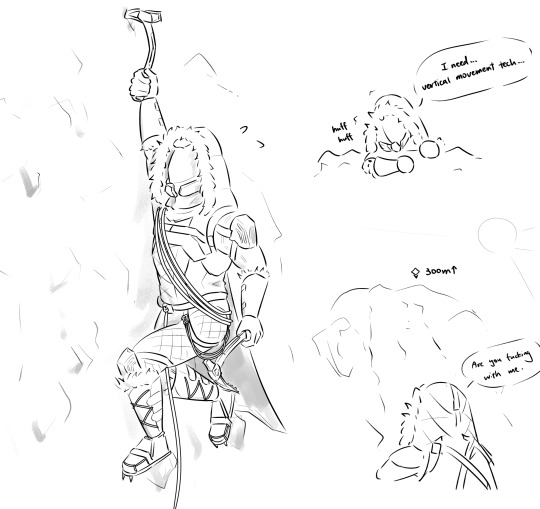
#i have no idea how ice / alpine climbing works#i've never even seen snow irl before#i just wanna draw my hunter do something different#anyway i like this set a bit too much#i have zero resistence to fluffy clothes#destiny 2#destiny hunter#destiny 2 art#my art
79 notes
·
View notes
Text
Chasing Baker
My Nana was my greatest adversary.

In an otherwise charmed life, Nana was an immovable force and the only legitimate challenger to my willpower. Not without the warmth one would expect from a grandmother, Nana could be sharp - like a sun-warmed pane of glass. Lesser hearts might have bent to me when I requested accommodation - but not Nana. Nana set a firm bedtime, insisted on efficient tooth brushing, and rather than negotiate with hair tangles, made short work of them in single, swift wrenches when brushing your hair. No nonsense. When you stayed with her - in one of two twin beds in a room made precisely for grandchildren - you often found yourself in bed with the lights out, with no real memory of having gotten there, swept away in the tide of your sheets. Nana was uncompromising, and no arena was more suited to our mutual stubbornness as the dinner table.
I grew up a notoriously picky eater. After a weekend at my Uncle Jerry's, my mom received a hardcover copy of "The Strong-Willed Child" from him as a gift. He had spanked me for not eating chicken nuggets. As evident by its title, the book was meant to coach my mother on parenting strategies for mitigating my innate obstinance. This would not be the only copy of the book my mother received. Though, I think she could have written one by the time I turned 4. I simply refused to eat the things I didn't like, and that was a long list.
A relative once applauded - clapped his hands together in joy- upon learning that I had graduated from having the crusts cut off my bread to full-blown sandwich eating. The peanut butter and honey sandwich was my signature dish and an absolute staple. I'd like to say I've grown out of it - and I've certainly grown having tried llama steak in Peru, lamb heart at the table of a Lebanese family, and Greenland shark in an Icelandic cafe - but it took me a long time to let go of my habits and permit myself to try, and it took some coaxing. My preferences ran deep.
My diet from ages six through eleven included Eggo waffles, peanut butter and honey sandwiches, an assortment of cereals, a handful of specific fruits and vegetables, and the occasional steak when mom thought my iron was low. My mom - on the advice of a pediatrician who told her that if she force-fed me, I'd develop an eating disorder - catered to this preference. Nana did not. They must have been seeing different pediatricians.
Nana took the clear your plate approach - The approach driven by reward and consequence. Finish your plate, cookies delivered. Fail to try, become hungry and hungrier still as dessert passes you by. I took to swallowing food whole, and my mom took to sending me with granola bars on visitations. She'd line the interior of my suitcase like we were smuggling drugs. I'll admit it was an unusual form of contraband, but the measure seemed necessary in a divorced child's duplicitous world. What my mom saw as nourishment, my Dad might see as undermined parenting strategy even under the best of circumstances - which they often weren't. I was hungry, so decided it best to keep things a secret and wrappers out of the trash.
Despite Nana's apparent best efforts, I avoided the eating disorder. Thanks to my mom, I avoided most foods until my early 20s. I don't know who was right. What I know for certain is that I was loved.
When I sat down with Nana after my trip to Mt. Baker, she clutched her heart as she said. "Ally - to think about you as this little girl - and that you would only eat peanut butter and honey sandwiches - to think of you climbing mountains…" she shakes her head, "… well I just can't believe it."
I started to laugh and asked her, "Want to know the best part?"
She nodded, smile in her eyes, full of that sunny warmth - playful and kaleidoscopic.
"I ate peanut butter and honey sandwiches up and down the side of that mountain, Nana," I told her, laughing, and then we laughed together. Growing up is fun, I thought, especially in moments like this.
Laughing with your grandmother is a gift you receive in exchange for time, and it is a beautiful gift indeed. Here is a woman who bathed you, clothed you, fed you - and by the time you're old enough to understand the magnitude of the life she held before all that, she is often gone. I'm lucky to have this time. Nana is 90 years old now, and my mother's mother passed at 74. I never got to have the conversations I wanted to have with my grandmother, who died. To ask her questions like, 'Who were you?' 'What lifetimes made up the love you gave so effortlessly away?'
There is something about mountain climbing that makes you consider those kinds of questions in real-time. There is something about mountain climbing that makes you feel as if you are in the process of 'becoming.' So when, at the parking lot of Grandy Creek Grocery, I met my fellow climbers and our guides - there was a feeling of anticipation and nervousness about who I'd be sharing that story with. Dropping me off, my mom described it like the first day of kindergarten. The first person I met was Sharon.
I had been worried about Sharon. Weeks before, on the pre-trip Zoom call, she stood out from the digital crowd as the most visibly senior person there. Sharon did not look old - she looked undoubtedly the oldest. I think this is an important distinction - particularly to Sharon. I remember thinking - "I hope she is not on my trip because I'm worried she will show me down." A very judgmental thought and the universe saw to its reckoning. Sharon surprised the hell out of me.
She paced the parking lot, and I jumped out of my rig to greet her. We quickly began commiserating. Baker would be her first mountain. I had Mount St. Helens under my belt, but it's not much in the way of experience. We talked about our training plan, recounting long drives to taller places. Sharon was from Wisconsin, and she had to drive 45 minutes to get to peaks at 3,000 - the same as me in Eastern Washington. We had a lot in common. Where I ran, she had been hiking with weight and jogging. Sharon wasn't afraid of hard work. On our drive to the trailhead, I learned that she had just lost 75 pounds last year. I learned later that when Sharon signed up for this climb, she hadn't told anyone in her family she was doing it. She was 62 years old and had never once traveled alone. What on earth possessed her to climb a mountain? I'd be afraid of that question, too.
Sharon eventually fessed up to her family and made the trip official. That's how we found ourselves on the side of a mountain together. I'm embarrassed to have been so fundamentally wrong - but my confession is not without meaning, and I learned an important lesson. Never underestimate a Sharon.
When Melissa, our guide, described Mt. Baker for the first time, she called it by its indigenous name, Komo Kulshan. She then gave us its epithet - "The Great White Watcher." Having now met Kulshan face to face, I can tell you that's precisely how he feels. The summit looms as you navigate through the trees. Stoic in the face of the wilderness that surrounds him. Ice cold, he waits. In the Lummi language, he's called 'white sentinel.' He is persistent, vigilant, and watching.
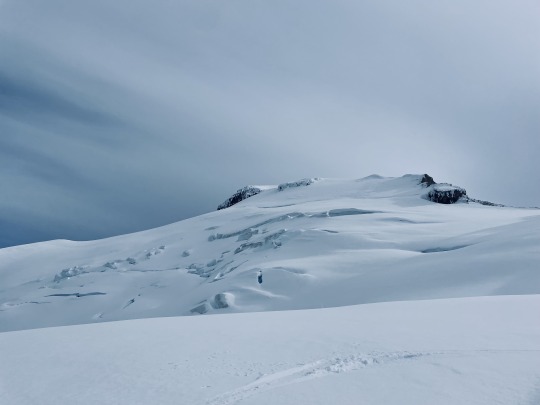
I focused my nervous energy on preparing to meet this mountain by learning what I could about him. I learned that Mt. Baker is 10,781 feet tall, an active volcano, and the second most glaciated mountain in the continental united states (Rainier's got it beat, and you don't count Alaska). It's a formidable mountain, known - as nearly all alpine environments are - for its quickly changing conditions and the perils of its geology. This all, somehow, frightened me less than the thought of meeting Melissa Arnot-Reid. Her legend loomed not in the Cascades - where only a single peak resides above the threshold of 14,000 feet by which the Rockies measure their formidable "fourteeners." Melissa's legend loomed as large as Everest, on who's summit she has been six times - the only American woman to summit without the use of supplemental oxygen and survive. 29,032 feet. Melissa was someone I wanted to learn from, and I was scared shitless of her by reputation.
Suffering a bit of social awkwardness around celebrities, I prepared to meet Melissa by seeking to learn nothing about her at all. The antithesis of my mountain strategy - I told myself our experience would be what it was when we met on the mountain. My job was to learn - to ask my questions courageously - and be vulnerable and bold in seeking truth. I spent a fair bit of time wondering if she might be an ass hole, too. The age-old adage, "don't meet your heroes," drifted in and out of my mind.
In the last 15 minutes of our drive to Grandy's, my mom started reading Melissa's Wikipedia page aloud to me as I navigated the road, undoing months of my concerted preparation. I let her continue, greedy for information. "It says she trains by depriving herself of things - that she'll go without food and water."
"Probably a good idea if you're ever going to be stuck on the side of a mountain without it," I told her. I braced myself for a response. In the past few months, my mother had a growing sensitivity around topics that might suggest I could die on the side of a mountain. Admitting, so blatantly, that mountain climbing was a dangerous sport left me vulnerable to excessive mothering accompanied by exclamations of "Don't you dare!" Instead, my mom sort of nodded and continued, "I'm surprised her baby came out healthy."
My brow furrowed. I hated my mother for saying it. I had avoided a lecture from the mother of the mountaineer but failed to account for the mother of the daughter aged-almost-thirty. My uterus is a topic of conversation around my mother's table. Apparently, so was Melissas. Not wanting to discuss either, I let my mother's comment go unchecked as she continued to list accomplishments. "This article says she's focused on business, not emotions. That she is an incredible problem-solver." Now her reports felt more like cheating - it felt like an unfair advantage to meet someone armed with publicly available information about them. When you Google "Allyson Tanzer," you won't find much about my disposition under pressure. I told my mom it was time to focus and turned up the music.
When we parked, and I went to introduce myself to Melissa, three things happened. As I introduced myself, she first quickly let me know that she would not be giving out hugs due to the pandemic. Then, taking my hand in a firm grip, Melissa detailed that she and our other guide, Adrienne, had critical guide business to discuss and would be with us in a moment. She reported being thrilled to be meeting us as she quickly dropped my hand. Within thirty seconds, I was apologizing profusely and backing my way into the grocery. What can I say - first time formally climbing mountains, and I wasn't sure of the protocol. I fiddled with a bag of Cheetohs and continued to hope that she wasn't just an ass hole.
I went to the bathroom for something to do and remembered what my mother said. Task-oriented. I figured Melissa probably didn't hate me, after all. Despite my earlier misgivings, I was grateful to know a bit about her character, regardless of how 'honestly' that information was obtained. Thanks, Mom.
Our climb began. We left Grandy's in a caravan and parked near 3000' at the winter routes trailhead. On the first day, you ascend to 6000' and establish camp. You carry about 40 pounds, walking 1 mile and about 1000 vertical feet per hour, stopping for 15-minute breaks in those intervals. Conditions are warm, which means you're doing something the mountaineers call "post-holing" - ramming deep holes (as if for a fence post) into the ground as you step through snow that's washed out underneath. It's slow-going and rigorous. An hour and a half in, Melissa reports that we're standing in the location where she usually takes the first break. Unseasonably warm weather with a heavy snow accumulation has made for an exciting start.
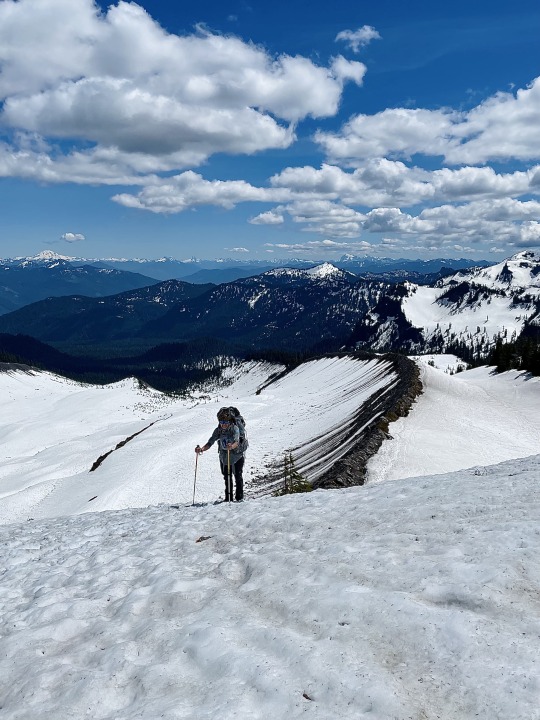
You walk along a canyon ridge formed by a retreating glacier. You realize that time here is not measured in the same cadence that it's known to you. Mountains measure time in millennium, not decades. The formations of rock are carved by years, not minutes. The ground holds a history you can't conceive of - an ancient history of rock and ice. You are constantly struck by feeling small both physically and in your very chronology. I spent the first day happily in awe.
At camp, you maintain - guides (and playfully designated junior guides), boil snow, establish a base, dig a toilet. You assess whether or not you need to poop in a bag and carry it down the mountain with you as you try - for the first time - a rehydrated meal claiming to be chili Mac and cheese. Melissa teaches us how to walk on rope over a glacier. I try to mimic her knots. She redefines your concept of efficiency - breathlessly describing a packing order that accounts for calorie intake, warmth requirements and weight distribution - Every contingency considered. When I win the Ice Ax Rodeo by landing my thrown ax in a particular configuration - all is right in the world. Melissa is a drill sergeant giving instruction. She outlines the next minute - next five minutes - next hour - next day.
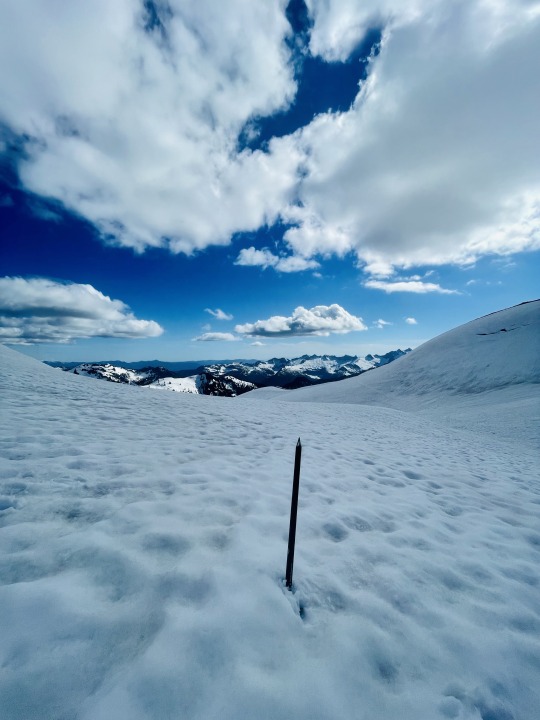
Her matter-of-fact nature reminds me of something. When I gave my parents a ride in an airplane for the first time with me as the pilot in command, I provided them near the same briefing as we were parked on the ramp. It ended dramatically with, "And if anything should happen, you have to exit the aircraft first in the following fashion." At which point I launched myself from the plane. I wanted them to be prepared to fight their instincts to protect me. I’m the only pilot on board - and my job is to protect my passengers, no exceptions. They both described a sense of foreboding and peace at the demonstration. It’s precisely how I felt when Melissa explained how she would be rescuing herself from a crevasse. “If you fall, I get you out. If I fall, I get myself out, but I need your help as an anchor to do so.” She took the approach of coaching us in only what we needed for the next challenge. We would learn crevasse rescue on a need to know basis. At Grandy’s, she told us to expect 48 hours of endurance. At camp, we’re at hour 9. She painted a picture of the following day.
"We'll begin between 11, and 2 am. Expect switchbacks up the glacier, a series of flats, and gains over the next hour. In 3.5 miles, we'll gain an additional 2000 feet - meandering a path through the glacier's crevasses, and it will gradually become steeper over time. About 1.5 miles to the summit, we'll hit the Easton glacier culminating in the Roman Wall. Then, because God has a sense of humor, you have a long flat walk to the summit after the steepest portion. All said it will take us between 5-7 hours to the top."
Frankly, it was just about as simple as that.
My eyes opened at 11:50 pm to the sound of movement outside the tent. Melissa had coached us here, too. "You may not be sleeping," she told us as we readied for 'lights out.' Days from the summer solstice, the sun burned brightly above us at 7 pm. "Remember that you don't need sleep; you need rest. That's what you're getting here at camp. You're horizontal; your feet are out of your boots. Close your eyes, and know you're getting what you need." Felt like a lie, but sure enough, with two hours of sleep, I couldn't describe myself as tired.
I did, however, feel cold. Chilly night temperatures had crept into our tent, and dressing for the day was arduous. I knew to keep my clothes in my sleeping bag. It was a trick I learned from a friend made trekking in the Andes for dressing in the cold. I knew to shorten my trekking poles while climbing, thanks to my guide on that same trek. I'd be leaving my trekking poles behind today, though. Ice axes only. We divide into rope teams. The race begins, but there's no starting pistol - only wind.
Fifteen minutes into our climb and we're struggling to find the rhythm. I'm still shaking the bleariness of the cold. The rope between climbers takes on an interesting dynamic. While it connects you to your fellow climber, it also isolates you from them. You have to maintain a certain distance away from one another while maintaining the same pace. It's a dance with crampons on in glacial ice - a delicate dance indeed - and it's where climbing feels like a team sport. You're all in it together.
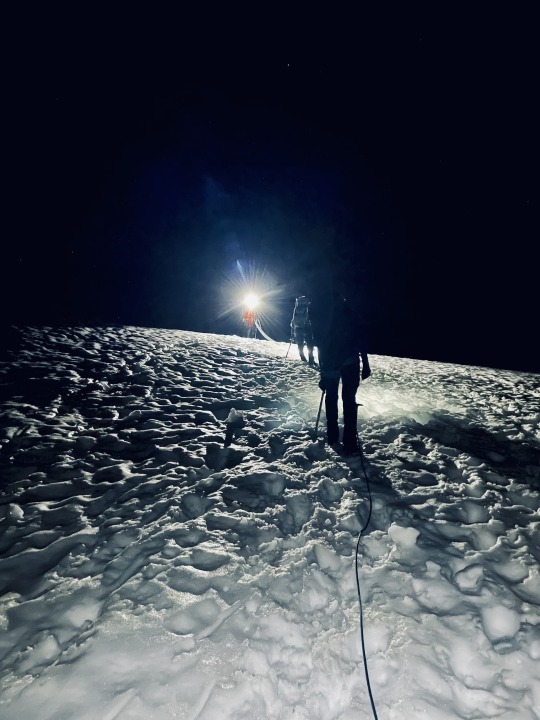
Voices rang out in sequence like a game of telephone - one of our team would need to climb down. We said short goodbyes and waited as Adrienne (guide) descended with climber to camp. We were lucky - we hadn’t been climbing long which meant Adrienne could climb down and back to rejoin her rope. Guide redundancy is a safety net when groups of climbers work together.
Darkness continued. We continued. As you persist, darkness seems to persist along with you. In the first hour, it grows heavy. Your world begins and ends at the light of your headlamp, and that's where you find it—your rhythm. Crampons crunching, breath steady, and the gentle swish of your layers create a sort of timpani, a medley of percussion sounds. Clink, brush, crunch, and clink, brush, crunch, as ax bites ice, the movement of your clothes, and the toe of your boot kicks crampon into snow propelling you forward. There isn't much to think about in this grinding meditation. You're grounded in tugs from ahead or behind you as you march, slowly up. You can count steps, miles, feet of elevation - whatever keeps you moving. Whatever keeps you going up.
Moments before sunrise, we would lose another on our team. I listened to Melissa coach her. "What we're headed to is going to be harder than what we've just done. If how you are feeling is taking away from your ability to focus on your next step - I can only tell you that it's not going to get easier from here." That's when I saw the decision on her face. Another round of goodbyes - this one a bit more somber. She had worked so hard.

The decision to descend is a difficult one, but it’s one of the most important you can make. There are steep consequences to being in over your head in a place so remote. The summit is a siren, beware. Melissa - aware of the remaining teams intention to summit - advised us to plug our ears as she told the descending climber the Sherpa belief that a mountain won't let you summit for the first time if it likes you. Mountains bring you back. Further, she coached, the decision to go down can lift an entire team's chance of success if you feel you're a liability. Recognizing yourself and your limitations truthfully is a mountain in itself. That's the summit this person made in her decision to descend.
Like a good Agatha Christie novel, our list of characters dwindled. We added layers and continued - five of the original eight. Melissa was right, again. After we lost the second climber, our ascent became a proper climb. From that point forward, if anyone decided to turn around - we would all have to. There was only one remaining guide, and she had to protect all her climbers, no exceptions - me in the cockpit all over again.
She didn't show it, but 62-year-old Sharon was genuinely frightened. She had realized the same thing I did. If she didn't make it - no one would. Sharon kept climbing. Remember when I was worried she would slow me down?
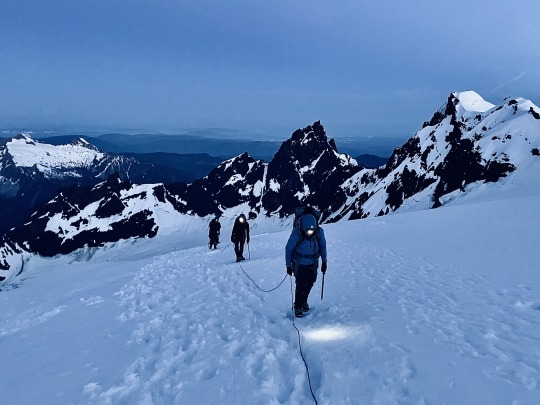
When the sun starts to rise, everything begins to feel possible again. I don't mean to say that things were hopeless, just that with the sun comes energy and a sense of renewal. Color returns to the landscape, and you can begin to be able to measure your progress concretely. The mountain casts a shadow across the earth, stretching miles. You can't believe that you are contained within that shadow, on the face of such a giant who stands so impossibly tall. Melissa stood there, and I took her picture.
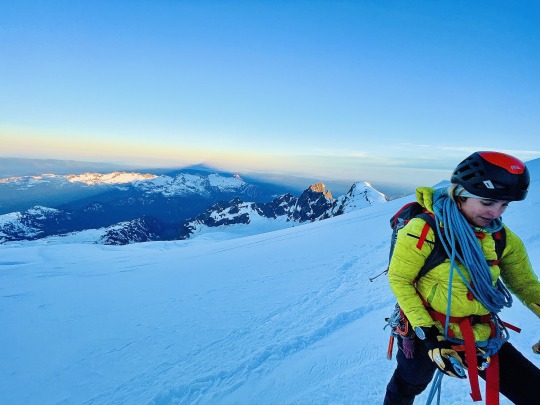
She had turned out to be not an ass hole at all. Where I sought to be her student, she aspired to teach - at once brilliant and kind. Her stride - her sport - a work of art. The precise art of what she calls slow, uphill walking. Her shadow and the shadow of the mountain impressed upon me the power of legends.
As the Roman Wall came into view - I knew we had it. We short rope in and make one last push. If Mt. Baker is a joke from God, the ending of the Roman Wall is its punchline.
Atop the incline awaits a long, easy walk to a haystack peak some few hundred yards in the distance. I was bubbling with emotion as my heart rate settled and the view became clear. There wasn't much difference between where we stood and where we were going. We dropped our packs, unroped, and ran up the summit. I was in tears.
Melissa broke her no-hugs-in-the-pandemic rule and celebrated us each in turn. I snapped countless photos and spent each frozen moment smiling. I pulled Melissa and Sharon in close. I had felt something on my heart and only needed a moment's bravery to share it.
I started awkwardly.
"I'd like to say something to you and Sharon," I muttered, barely audible over the wind, as I tugged on Melissa's sleeve. I grabbed Sharon's arm and pulled her in too. I don't remember the exact thing I said or the exact way in which I said it. I remember pausing to make sure I got it right and wondering for a long time if I managed to do so.
I told them that I had come to the mountain expecting to be impressed by one person. Melissa promised an impressive education - on which she delivered. She is of that rare quality - the kind who’s presence improves you. I came to Baker with that expectation, I confessed, I expected Melissa. I paused before telling Sharon, her gloved hand in mine, “You?” I laughed nervously. “I wasn’t expecting. A 62-year-old woman….” I nodded back to Melissa, “And you, the mother of a 3-year-old…” I didn’t want to get this wrong. “You are two people who our society labels and confines. Yet, here you are - on top of a mountain. I have to tell you….” I was choked up in earnest here and struggled to continue.
"It matters.” I said. “What you do matters. It matters to have an example of what is possible. Both of you have provided that example to me and women like me. Thank you." I sobbed. "I am so grateful for it and grateful for you." Melissa smothered me in her jacket as she embraced me, once again, in a hug. Pandemic be damned. My tears froze. While I expected a "There's no crying in mountaineering" a la Tom Hanks in A League of Their Own (it was a climb of mostly women, after all) the admonishment never came.
Sharon grabbed hold of me next and we shared the alpine view. Before I knew it, we were the last two on the summit. The wind howled a steady cheer. Celebrations concluded, it was time to leave. I stayed for just a moment longer, watching Sharon as she left. They don't make anything more beautiful than a mountain, and it's a view worth savoring. I descended, joyfully, to my team.
I didn't bury Jake up there. In Ashes to Ashes, I told the story of taking my old farm dog's remains to the top of my first volcano. He's not so much a good luck charm as he is an omen of protection. I don't need luck as much as I need safety, and he serves his duty well. Jake stayed with me through our descent to camp. I needed a little protection coming down off the Roman Wall, I thought. I wanted him close until we were off the glacier. He lays now at the foot of my tent—a very good place for a very good dog.

There's a natural mindfulness to climbing. I often find myself living in the present step - not thinking about the route that lies below. You forget in moments that the trip up is accompanied by an equally long and perilous journey down. From the summit, your journey is far from over. Yet, time flies by even as you stop to admire the steam vents. The rainbow that surrounds the sun refracts joy and color the same.

You reach camp, celebrate, pack up. Miles and thousands of feet remain even from there. That's when you realize it's ending and when I realized I didn't want it to end.
We spent the next few miles getting to know each other in earnest, savoring time and mountain views, chatting in the way of long-form hikers - about the nature of things and through storytelling. Melissa regaled us with vulnerable truths and comedic parables. We laughed. I kept sipping at the wells of knowledge around me, drinking in the moments. Laughter distracted from hunger, from wet feet, and from the dull and dim realization that all good things must come to an end. We made our way to the bottom of the mountain. Just like that - we say goodbye.
Sharon drove me back to Grandy's. We chitter like school girls - adrenaline and nostalgia collide in our post-climb delirium. We talk about the future. I realize that we are good friends. I am humbled by just how wrong a person can be to believe something about someone for no good reason.
Mom picks me up, and with her embrace my adventure is over. I’ve come full circle - safe and sound, parked in the lot of Grandy Creek Grocery.
Melissa found us there and knocked on our window.
"Your daughter is really special. The MOST special,” my hero and friend told my mom. Mom beamed with a special pride reserved exclusively for mothers of strong-willed daughters. I had been misreading things - the adventure had only just begun.
There are eight years between Melissa and I. I’m not sure I’ll be chasing Everest in that time, but I know I won’t be finished. I’ve got thirty-three years to catch Sharon at 62. In the mountain blink of sixty-one years, I’ll be as old as my Nana and I hope at least half as wise. Good thing there are so many years - for there is so much left to climb.
#mountaineering#mountains#travel#adventure#adventurephotography#traveling#travelblogpost#mountainclimbing#mt baker
2 notes
·
View notes
Text
Unexpected.
Summary: You decided to cook a last-minute Christmas dinner for yourself when something unexpected happens on your way back home.
Characters: Bucky Barnes x Reader, Alpine.
Warnings: Some angst (blink and you’ll miss), just general FLUFF.
A/N: It’s been so long since I wrote any Bucky x Reader stories, so I hope you enjoy it! As usual, English is not my first language so be kind with the grammar mistakes. I would also love to know your thoughts on it!
Read it on AO3.

Snow covers the streets of Shelbyville as you try hard not to slip and fall.
Christmas isn't your favorite holiday, but seeing your neighbors decorating their homes, baking cookies and buying Christmas presents was making your heartache.
After the death of your parents and a terrible fight with your only aunt, you decided to start over away from everything you used to know. You were a single child and nothing was holding you back anymore. And what better place to start over than Shelbyville, Indiana?
The town was like any other small town in the country, but something about the place and the people made you want to stay and, five months later, you still don’t regret your decision.
The only decision you’re regretting at the moment is leaving your house in one of the coldest days of the year for a last-minute Christmas dinner shopping for yourself.
The supermarket was so crowded and people were so rude that you considered if hell would be like that when you died. But, hey, at least you got everything you need for a nice Christmas dinner for one! You knew that there was too much food for just one person and that it would last you at least until the New Year's Eve, but looking on the bright side, you wouldn’t have to go back to that place for a while.
And you bought some of the things that you loved and that reminded you of Christmas with your parents: chocolate, supplies to bake one of your mother’s favorite pies, a small turkey that would last you for a week, wine and even some cans of cat food for the white cat that liked to visit you sometimes.
You had no idea who she belongs to or where she lived, you just knew it was a female. One day, a few weeks after you moved in she was just sitting there on your couch, staring at you with curious, bright eyes. Her white fur was clean and she looked well-fed, so you assumed she had an owner, but she liked to visit you and slowly, you started to like her and wait for her visits.
And that was the funny thing about the cat - you’ve decided to call her Mimi - she was only visiting you and would appear at the most random times. She would usually show up at night, mostly the cold nights, and sleep a bit with you. By the time you wake up, she would be gone.
You wonder if she would show up tonight to expend Christmas Eve with you as you slowly walk back home, trying hard not to fall as you step onto the sidewalk when you see him.
His once black clothes are white from the snow, so you assume he must have fallen and you have no idea how he’s not freezing to death with the weather. His hair is also covered in snow and he’s making exasperated sings for something on the roof.
Bucky Barnes.
Everyone knew who he was, of course. Former Captain America sidekick and war hero, former Winter Soldier, former Avenger. He lived in his childhood home now, right across the street from you and mostly kept to himself.
You had heard rumors when you moved in, about him being your new neighbor, but had no idea what to expect. Maybe daily fights with bad guys? Random former Avengers stopping by? Was he friends with Thor? But none of that ever happened and your curiosity started to peak.
“Hey”, you call, surprising yourself, “Is everything okay?”
Bucky looks around at you, surprised.
“Oh… Hey”, he says slowly and looks back at the roof, “It’s nothing… Just Alpine playing a little Christmas game”.
He points to a white thing on the roof and you gasp.
“Mimi?! What the hell is she doing up there?”
“Mimi?”, Bucky repeats with a surprised tone.
“Yeah…” you feel yourself getting flustered with the way he looks at you, “she, hm, she visits me sometimes…”
“So that’s where you’re going?” Bucky asks the cat, now sitting at the roof, watching the conversation between the two of you with interest.
“I didn’t know she was yours”, you explain with a shrug. “She comes by sometimes and sleeps in my bed”.
Bucky laughs and your heart beats a little faster.
“I’m sorry, she disappears sometimes but I never really wondered where she could be”.
“It’s okay! I adore her, she’s adorable!”
There’s an awkward silence and you look at Mimi - Alpine - sitting on the roof. How is she not freezing too?
“How did she end up there?”, you ask not wanting the conversation to end.
Bucky sighs.
“I have no idea. I heard her meowing and tried to get her back down, but she just keeps going up and looking at me with that judgmental look of hers”.
You smile.
“Ah, the judgmental look. She usually gives me that look when I leave my bedroom window closed”.
“Yeah, sounds like Alpine”, he laughs.
You stare at each other, then at Alpine again. The cat meows and moves swiftly a little higher.
Slowly, you cross the street and approaches Bucky. He gives you a curious look.
“I’m guessing you tried to climb up there and bring her back?”
“Yeah…”, he indicates his snow-covered clothes, “but, obviously it didn’t work”.
“Okay… Maybe she’ll come down if I ask?” you question and turn in the direction of the house, moving your hands and calling Alpine.
You’re completely aware of Bucky looking at you as you make weird gestures and cat noises to try and bring the cat down, but don’t stop. Alpine lays in the snow-covered rooftop and stares at the both of you.
“I think she’s enjoying our humiliation”, you sigh.
“Guess she was bored and wanted to play with us a little”, Bucky replied and when you look at him, he quickly looks back at his cat.
“Okay… I have a stupid idea, but maybe it will work?” you shrug and walk back to the shopping bags on the sidewalk across the street.
Bucky watches with brows furrowed as you look around and pick a can of cat food.
“I don’t think she’s hungry…” he starts as you walk back.
“Hey! Alpine!” you exclaim and raises the can of food around in the air.
The cats raise her head and meow with curiosity.
“C'mon Alpine, stop playing games with our hearts and come down”, you continue to move the can around and the cat walks down the roof, and jumps back to the ground.
Bucky laughs incredulously and you smile, watching as the cat walks around his legs and stops in front of you, as if waiting for you to give her the food.
“Do you have any cats?”, Bucky asks, picking up Alpine and holding her in his arms.
“Nope”, you reply shily, “bought this for her. Christmas dinner”.
“Thank you. That’s really kind of you”.
Alpine moves around in his arms and jumps on your shoulder, making you both laugh.
“Would you like to share her custody for the holiday?”, Bucky suggests as his bright blue eyes look from you to his cat, trying to lay on your shoulder like you were the best of friends.
“Um… I mean” you mumble, scratching the cat’s head, “if it doesn’t bother you…”
“I think Alpine already made her choice”, his voice is light and the shadows of a smile played around his lips.
“That’s very nice of you, thank you”.
You both fall into a comfortable silence as you play with the cat on your shoulders.
“And, what about you? Do you have any plans for Christmas?” you ask, remembering the ridiculous amount of food you bought an hour ago.
“No… I don’t really like Christmas anymore. To be honest, I was planning to stay in, eat pizza and watch horror movies to avoid the general mood”.
You laugh, surprised.
“Been there, done that. I’m not a big fan of Christmas either. I was planning on binge-watching Lucifer to avoid the mood too”.
“Sounds like a good plan”.
“Yeah… But Christmas food is my favorite, so I decided to cook dinner last minute”, you stared at him, feeling yourself getting warm with the way he’s looking at you. “Would you like to come over?”
The way his cheeks turn pink with the invitation makes your heart beat faster.
“I can’t… I don’t mean to intrude!”
“You’re not intruding at all! I bought so much food that will probably last until the New Year, so there’s more than enough for both of us”, you give him a small smile, “Besides the holidays can be depressing enough without some good food or company and…”, you shrug, “Nobody should be alone for Christmas”.
You stared at each other as you wait for his reply. You can almost see the engines in his brain, considering the invitation.
As if on cue, Alpine jumps from your shoulder, crosses the street and sits next to your shopping bags making you both laugh.
“You are unbelievable”, Bucky sighs at the cat.
“So… Would you like to come in?”, you ask and Bucky smiles. You really love the way he smiles.
“Yeah, sure doll. Thank you”.
You cross the street together, careful not to slip on the ice and he picks up your shopping bags. Alpine follows and is the first to walk in when you open the door, so familiarized with your home that it’s almost like her own.
You watch as she jumps on the couch and lay down in one of your pillows, hoping that maybe, Bucky will feel just as comfortable with you too.
#bucky barnes#bucky barnes x reader#bucky barnes x you#winter soldier#alpine#reader insert#captain america fanfic#ficmas#kinda#just cuteness#fluff#christmas fic#christmas#textos#my writing
71 notes
·
View notes
Text
Arafef: kisses in the snow
The chilly December wind blew through the alpine forest, as giant footsteps crunched through the snow. The 156 foot tall redblood smiled gently as she cradled her seadweller matesprite Feferi in her palm.
Feferi: Aradia im glubbing FR-EEZING!!!! Why did you want to go on a date in the middle of now)(ere 38T!
Aradia: don’t you think it's gorgeous out here? the ice covered trees, the snow in your hair?
Feferi: It’s absolutely beautiful glub, but my fins are turning into icicles!!!
Aradia: hmmm... do you think some kisses would warm you up 0u0 ?
Feferi: Yes, I t)(ink that would do just the trick! 38D
Aradia slowly moved her palm up to her face, careful not to jostle her tiny lover. With Aradia's palm flush with her lips, Feferi ran forward to embrace them, as Aradia's fingers cupped around her to protect her from falling. Feferi realized that Aradia's lips were unbelievably soft as she pressed her face and hands into them. It felt like falling into a warm, freshly made bed after a long day out in the cold, and laying your head on an incredibly plush pillow. Aradia puckered her lips around Feferi's head for an even more intense kiss. Feferi's cheeks were flushed with fuchsia as she buried her face deeper between aradia's lips. As Feferi was savoring her kiss from Aradia, Aradia accidentally ended up savoring Feferi. She carelessly allowed her tongue to pass between her lips, unintentionally giving Feferi's face a small lick.
Feferi: )(e)(e, look out Aradia, you got my face all covered in saliva! 38P
Under normal kissing circumstances, getting some small tongue kisses might be expected, but things are very different when that tongue is roughly the size of a bus. Still, Feferi seemed to take it in stride, and the way she chuckled and smiled made aradia suspect that she enjoyed it. Despite this Aradia was careful to not let her tongue slip again, despite the fact that she really wanted to. As much as she didnt want to admit it to herself, Fef tasted absolutely delicious. We all know the typical 4 flavors foods come in- salty, sour, sweet, and bitter. But Feferi was best described by a flavor often forgotten, umami- the flavor of mushrooms, tomatoes, and seafood. Umami detecting tastebuds cover a larger section of the tongue than all other flavors combined, making umami one of the most powerful flavors as a result. With Aradia introduced to Feferi's delicious umami flavor she couldn't help but crave another taste of her small matesprite. Her mouth flooded with saliva as her mind flooded with thoughts of getting another lick. However, Aradia feared indulging her cravings could frighten her girlfriend. She held herself back, though her cheeks still flushed as deep red as her feelings for Feferi. After Feferi enjoyed her giant kiss a bit longer she pulled back, sat down on Aradia's massive palm, and gave her a big smile. Aradia smiled back, and the two silently communicated their love for each other as they gazed into each other's eyes. The red blooded giantess began strolling through the snow once again, leaving footprints the size of a small house behind her. Aradia gently cupped Feferi to her chest in a loving embrace. ~~~~~~~~~~~~~~~~~~~~~~~~~~~~~~~~~~~~~~~~~~~~~~~~~~~~~~~~~~~~~~~~~~~~~~~~~~~~~~~~~~~~~~~~~~~~~~~~~~~~~~~~~~~~~~~~~~~~~~~~~~~~~~~~~~~~~~~~~~~~~~~~ As Aradia strolled through the alpine landscape, she desperately tried to push the thought of how delectable Feferi was out of her head. Deep down, aradia was terrified of scaring her lover. Even though being god tier meant she could swallow Feferi and cough her up later without causing her any harm, Aradia knew she would never forgive herself if she frightened Feferi. When Aradia first met her other friends in person in SGRUB all those years ago, and they discovered the secret of her size, many of them became afraid of her, even if they tried not to show it. Aradia could recount by memory every night she stayed up crying after that, fearing that her friends thought that she was a monster. Until the fateful night on the meteor that feferi found her sobbing in her room. The sound of Aradia's cries had apparently traveled through the vents of the meteor and reached Feferi's ears. Feferi had consoled Aradia, showed her that she wasn't afraid of her, that she didn't think she was a monster! The friendship between Aradia and Feferi deepened over those three years on the meteor and blossomed into a matespriteship. When they finally arrived on Earth-c they promised each other they would spend the rest of their lives together, but Aradia often feared that she would make a careless mistake and Feferi would think she was a monster just like Aradia thought all the others did.
Aradia held Feferi a little closer to her chest as these thoughts passed through her head. ~~~~~~~~~~~~~~~~~~~~~~~~~~~~~~~~~~~~~~~~~~~~~~~~~~~~~~~~~~~~~~~~~~~~~~~~~~~~~~~~~~~~~~~~~~~~~~~~~~~~~~~~~~~~~~~~~~~~~~~~~~~~~~~~~~~~~~~~~~~~~~~~ After roughly 30 minutes of walking through the winter landscape Feferi called out to Aradia.
Feferi: Aradia, i'm cold again!! 38I
Aradia: how? I've been holding you to my chest for the past half hour!
Feferi: Ok, i'll admit, it's warm. But I want WARMER, glub!
Aradia: would some more kisses interest you?
Feferi: T)(at sounds nice...
Feferi: But I think i )(ave a better idea, glub!
Aradia Awaited Feferi's idea but only received a plethora of eyebrow wiggles. She stared at fef for a few minutes confused until fef opened her mouth and pointed in. The eyebrow wiggles intensified.
Aradia: uh.. wha..i..um
Feferi: Oh come on, don't bother playing coy, i know you liked it when you got a taste of me earlier, and )(onestly who could blame you? 38P
Aradia's heart was pounding out of her chest, and yet she really didn't know why. Feferi had just told her that WANTED to indulge her craving, but Aradia still felt scared and embarrassed.
Feferi: Aradia, I know already. You've been jittery and blus)(ing constantly since you got that lick! Also, giving you a better taste would double as a nice way to keep warm and cozy!
Aradia: i...i.. alright
Aradia: you caught me, you taste delicious and i've been craving another taste since when I gave you kisses earlier.
Aradia: i... was just really afraid of scaring you.
Feferi: Aradia! you don't have to worry about stuff like that! Were both god tier and you know i am afraid of glubing NOT)(ing!!!
Aradia: i know, .. i just get so nervous.
Feferi: Aradia, i will always trust you, there is no reason to be nervous!!
Aradia:.. thank you, that.. that means a lot to me.
Aradia: alright, are you sure about this?
Feferi: YEA)(!!!!
Aradia brought her palm up to her lips once again, and opened wide. Feferi stood before her lovers gargantuan maw, as fearless as ever. Aradia slowly outstretched her tongue, giving Feferi a massive lick in the process. As saliva coated fef's face she laughed and gave Aradia a gleeful smile.
Truth be told, fef was enjoying this just as much as Aradia. Earlier that day when Aradia had licked her on accident Fef had realized how soft and warm Aradia's tongue was, and wondered what it would be like inside her mouth. She was absolutely loving this.
Aradia lowered her tongue onto her palm to allow Feferi to climb on. The tiny seadweller stepped onto her lovers outstretched tongue and laid down on it, sinking into the warm grey muscle. Feferi gently massaged Aradia's tongue as she rested her head onto it.
Aradia was in heaven.
She gently pulled her tongue back into her mouth, curling it up a bit to cradle feferi.
For Feferi, if getting those kisses earlier was like falling into bed, being pulled into Aradia's mouth was like climbing under the deliciously cozy sheets. The tongue was so plush and warm, saliva soaked her entire body, and Aradia's throat slowly pulsed as her warm breath swept through her mouth. With feferi entirely inside her mouth, Aradia closed her teeth together with a click, sealing Fef in the darkness of the expansive maw. But Feferi's seadweller eyes allowed her to see perfectly in the dark.
Aradia began to gently slosh Feferi around inside her mouth, savoring her delicious umami flavor. Occasionally Fef would give her tongue a massage and it was one of the best feelings in the world.
Inside the mouth Feferi was extremely relaxed despite being slohed around and tasted. It was like a full body massage, working out all the tension within her muscles. After a while the sloshing stopped and Aradia opened her mouth, a gust of cold winter air mingled with her warm, steamy breath.
Aradia: are you ready to be swallowed?
Feferi: Go a)(ead!
Aradia clicked her mouth closed once again, and Feferi shuffled around and dangled her legs into Aradia's throat, her head brushing against the uvula. Aradia's tongue rose up like a massive wave, pushing fef deeper into the throat. Aradia gulped a few times until fef slipped fully into her throat and the muscles of her escoughgas began to pull her down. The giantess traced the bulge Fef made on the way down with her finger.
Inside Aradia’s esophagus, the seadweller received an even more intense massage as she descended deeper into Aradia's body. After a while she arrived at the sphincter which opened to drop her into the stomach.
To Fef, Aradia's stomach was like a massive aquarium. Due to the conjunction of her unique biology and being godteir, Aradia's stomach contained only warm water. Feferi swam around playfully, jumping in and out of the water like a dolphin before getting tired and drifting off to sleep in the back float position.
With Feferi safe inside her stomach Aradia sat down on a nearby rock ledge and patted her stomach. She could feel Feferi playfully swimming around inside her. Aradia closed her eyes and fell asleep, satiated with the knowledge that Feferi would always love and trust her.
#vorestuck#homestuckvore#safevore#softvore#willingvore#arafef#aradiamegido#feferiipiexes#homestuck#romnoms#aradia/feferi#MyArt
8 notes
·
View notes
Text
Trekking pole manufacturer/supplier
Millet mountaineering bag measured experience, a century-old outdoor brand
Today I will unpack this Millet PEUT INT 35+10 outdoor hiking bag.
Let’s talk about this outdoor brand! Millet was originally a canvas bag company. It sprouted in Lyon, France in 1921. Since the company moved to the foot of the Alps in 1928, it began to produce professional mountaineering backpacks in the 1930s. The two sons also inherited the family business and further cooperated with mountain guides to jointly develop higher-level and professional mountaineering backpacks.
Millet products are divided into six series, namely, Alpinism-Professional Mountaineering/Climbing, Climbing-Rock Climbing, Trekking Hiking-Hiking, Mountain lifestyle-Leisure Life, Ski-Skiing, TRAIL-Wild Running. And this backpack out of the box today is designed for year-round mountaineering. In addition to basic mountaineering settings, a lot of thoughtful designs for ice climbing or skiing are added to the details of the backpack. Let's take a look!
35+10 liters of flexible large capacity
I like this kind of backpack with elastic capacity the most, because storage is really hard work, especially in the mountains, it is inconvenient to pack, and some items that are light and need easy access (such as raincoats, down jackets, mobile food) sometimes I'm really too lazy to organize it. With flexible capacity, I just throw it all in.
The design of the bag is exquisitely equipped with a harness configuration at 35 liters and an additional 10 liters. With or without the 10 liters, the equipment can be compressed into a fixed shape. Although it seems to be a small design, it is not in use. It is very intimate and can feel the fineness.
In addition, there is another setting that has to be praised, see the picture below.
(The middle picture is taken from Millet's official website)
Because it is designed for year-round climbing and climbing, a rope storage system is specially installed inside the top bag, which solves the inconvenience of rope storage at one go; at the same time, even if there is no ice climbing requirement, this buckle can be used as The secondary compression, or the perfect fixation of any equipment that needs to be fastened here (the Hanchor CINDER 18L top bag is shown on the right above), really greatly improves the storage performance of this bag!
Straight bag type
I didn't pay special attention to the shape of the bag before. Anyway, it is normal to occasionally hook on branches and get stuck on the path. But when I came back to do my homework, I found out: this bag is too thin!
The above picture is not obvious, please see the official website product photo below.
Maybe it’s because of the women’s backpack. It is also narrower in the shape of the backpack to match the shoulder width. The advantage is that when drilling some narrow mountain roads, it is not easy to get stuck on nearby branches or affect activities. Recall that when I was drilling before, I would be hitting everything. This time it seemed to be really unimpeded.
Since the backpack is a bucket type, a double-end zipper is opened on the side of the backpack to improve the convenience of picking up items. You need to make a small hole where you want to take the equipment, and you are not afraid that it will all fall out once you open it. (Later after thinking about it, I found out that it was this way that I used a double-end zipper, so sweet~)
Comfortable carrying system and super breathable back panel
Let's talk about the most important carrying system.
Because my favorite bag is the adjustable back length Mystery Ranch, this bag without a back length adjustment system may make people a little uncomfortable, but in fact, as long as the weight is fixed in a labor-saving position on the body, the carrying is very comfortable of.
At the beginning, I adjusted the elasticity of the strap with the tightness that Mysterious Farm is used to. After more than an hour of departure, I started to have waist and back pain. Later, on the suggestion of a friend, I tightened the belt and pinched my waist (more than when I was carrying Mystery Farm. Tight), so that the waist belt can be locked and fixed to the hip joint, and it will be improved immediately, and there is no back pain at all during the whole trip, which is very powerful in the carrying system!
Although many people admire Mystery Farm’s excellent carrying and user-friendly adjustment system, the empty weight of the backpack is indeed quite heavy. The choice of backpack still depends on the different needs and physical conditions of each person. This time I use Millet to find fun. PEUT INT, it is indeed obvious that the weight on the body has been reduced a lot, and when the backpack is back on the body, it is not as difficult as before. It is a very comfortable carrying experience.
Chest buckle with elastic rope track and adjustable position.
Millet's secret weapon is super breathable back panel!
then! What I want to introduce is the breathable backboard that I feel very good this time.
As a Virgo with a lot of sweat and a bit of cleanliness, at first a large part of the mountain climbing is not able to adapt to the sweat, wet and sticky, and can not take a bath. Every time the backpack upper body will obviously feel a whole piece of sweat on the back, It's terrible. But this bag won't!
Millet's Ariaprène Back technology, I don’t know how to translate it. In short, it looks like it’s hollowed out a whole piece of foam in a special form, so that the back panel foam can take into account comfort and breathability at the same time. The triangle doesn't look much, but it's a peach blossom on the back! Before starting to use, I did a little homework on this backpack, and I noticed the ventilation system on the back. I didn’t think much about it at the beginning, but it was really super comfortable to use. It was sunny and sweaty for three days and two nights. , When I go home and smell the backboard, it is still fragrant (I just smelled it again, um, it is still fragrant), this ventilation system I give a super high evaluation!
Magic large space, large top pocket and storage space
Do you like to keep holding things when climbing a mountain?
Can you take a trekking pole for me, can you take a fur hat for me, in the side pocket, wait a moment, I want to wear a coat, I am hungry, I want to eat... That’s right, it’s that annoying, but I’m lazy to take off the backpack , It’s the kind that when you’re shopping on the street and want to take things, you will reach out to the back to dig out your backpack for a long time, and you will always want to take things. How can you get it in the main bag?
This top bag is basically a big space, super three-dimensional square compartment, no problem to put a bunch of things, if you want to, you should be able to put a total of nine uniform big pudding in three rows, plus a raincoat in it. My own storage habit is to put all the rainproof equipment in the top pocket, which is the most convenient to take, and is not afraid of getting the equipment wet. Also, because the shape of the compartment is almost a cuboid, the shape of the top pocket still won’t run after stuffing so many things. It will even make it look better.
Top pocket, top pocket inner layer, side pockets, large main pocket, thick storage deep pocket on the front side, and water bag hanging ring.
In addition to the top pocket, other storage spaces are also worth mentioning. Excluding the oversized top pocket, there is also a small zipper pocket on the inner layer of the top pocket, which can hold some smaller items; the front side is a thick and deep pocket for ice climbing to place crampons, which is very high and stiff enough. You can also put some small flat objects without crampons; the inside of the bag has a water bag fixing ring configuration, which is quite intimate.
Infinitely possible plug-in settings everywhere
Did you discover it? His external ring is invincible!
As a professional camel beast, one of the bad storage habits is to love plug-ins. Some hiking bags don’t pay much attention to the external system (after all, I’m not happy to see crazy external systems, haha). Although they can be placed in the main backpack of the backpack, they don’t need external ones. (Such as camping lights, stereos, slippers, hats) hanging outside is a kind of hardcore game, handsome~ Then there are really a bunch of loops on the outside of this backpack for me to hang out, satisfying my little vanity.
(Do you know why I can’t resist the modular system of Mystery Ranch 2 Day Assault)
Did you find that even the top pocket has four loops? Because of those four loops, Zhi Jiayang can put the tent on top of the top pocket
Not only the webbing loop, but also because of the needs of ice climbing, there are additional straps, ice axe straps (trekking poles can also be used) and storage compartments. Take a look at the picture below. If it really looks like the right one... . It's too hardcore! ! !
Use experience sharing
It’s almost here when I open the box. Overall, I’m very satisfied with the use. Although some of the features are spoiled by the love bag: adjustable back length, three-way full-opening zipper, and many internal interlayers, which make it uncomfortable at the beginning. However, after these two uses, I can get started slowly, and PEUT also has some comforts that the love bag cannot provide (such as breathability, light weight and large capacity), and the carrying system is indeed no less than the love bag. In fact, after weighing it down, the longer reloading trip should still choose to take PEUT up the mountain.
The most obvious experience of this experience is probably the intimateness of the backpack design. In many cases, I have made thoughtful ideas for the inconvenience and discomfort of mountaineering. It is worthy of a century-old mountaineering equipment brand. There are many ingenuity in product design and delicate attention. Accompany us through every mountain.
Because I have not experienced too many mountaineering bags, I have only used Decathlon, Mystery Ranch 2 Day Assault and this Millet PEUT INT 35+10, plus the positioning of each bag is different, so there are not many here. Make a comparison~ I like it and recommend it!
The above experience is all sincerely shared and recommended. Although the speech is a bit exaggerated, it is really good to memorize it.
1 note
·
View note
Text
SLOVENIA
Slovenia 5/12/19 – 5/19/19 Republika Slovenija. The country is about the size of New Jersey but ever since I first visited in 2006, it left a big impression on me and I have always wanted to return. And especially with a bicycle. After a trip to Norway didn’t pan out I had committed myself to the idea of another bicycle trip and after a short think, Slovenia was it. Quite a bit of flight itinerary option analysis later, I had a free flight via American Airlines miles to Venice. I had about a month to plan out the trip so wasn’t too stressed. Then work got crazy, then I ended up in LA for the week before the trip, and then all of a sudden I was leaving the next day and I still had a route to plan and accommodations to book. That all somehow comes together no matter how unprepared I am and it would this time as well. So a long flight to Madrid, a short flight to Venice, and a 2 hour train ride later I was at the border town of Gorizia, Italy where I had the day before booked a hotel for the start and end of the trip. The hotel room turned into a bike shop and I re-assembled the Rick Jones that night and would leave the travel case with the hotel for the week. The following morning I pedaled across the border to Nova Gorica in Slovenia and started on my clockwise loop around western Slovenia.

The first day was grey and a little wet, which would prove to be a theme for the trip, but the riding started out pretty good, riding over one Italian hill before unknowingly crossing the official border at some unmarked spot and onto a bunch of small Slovenian farm roads.

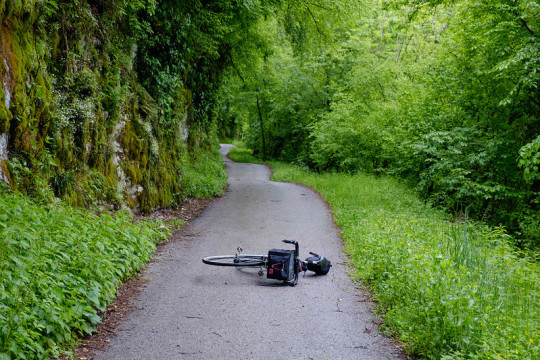
Just before the town of Plave I hit a ripper of a descent and satisfied myself with my brakes ability to stop me, and then the Soca River first came into view. I had been waiting to see this river for 13 years, and it did not disappoint with amazingly clear turquoise blue water.
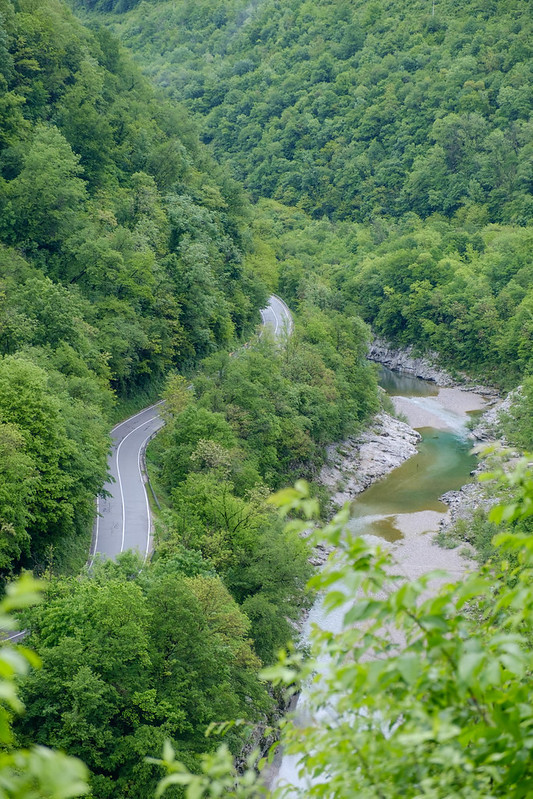
My route for the day would follow small roads along the Soca River valley, hitting small towns, and transitioning between perfect pavement, gravel, and jeep track. The weather shifted from threatening to very threatening but luckily never rained more than a spitting. But what the weather lacked in rain it made up for in gusting wind, and blowing the wrong direction. I stopped for a picnic of leftover pizza from the night before, and though I was exhausted from the travels and jetlag, and despite the wind, made it to the town of Bovec to check in to the friendly hostel I booked. A good meal of trout, in the somewhat humorous and cartoonish Bovec style, and a couple glasses of local wine and I was out like a light.
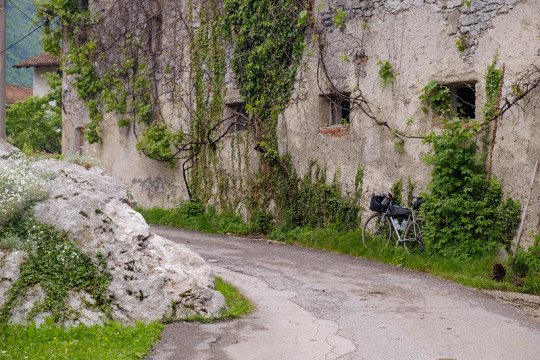
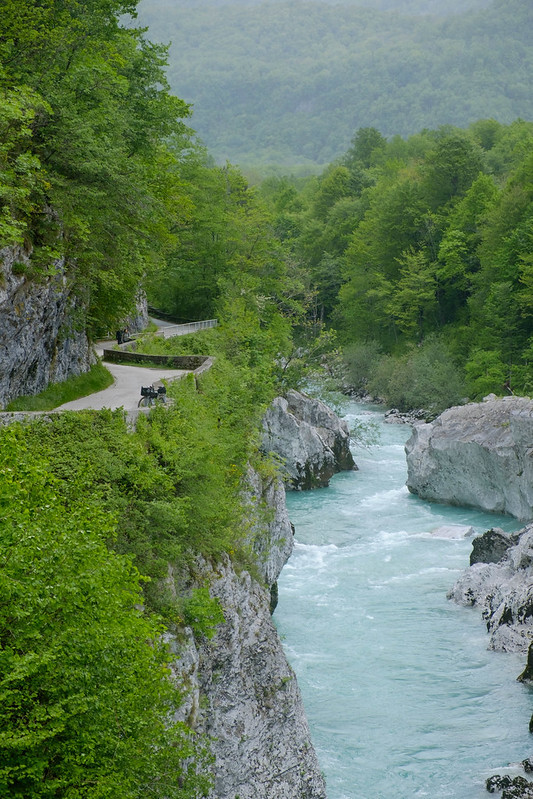
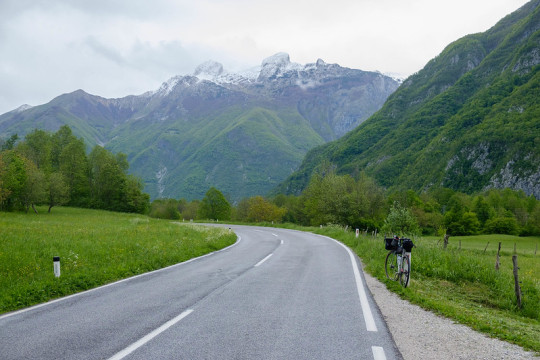
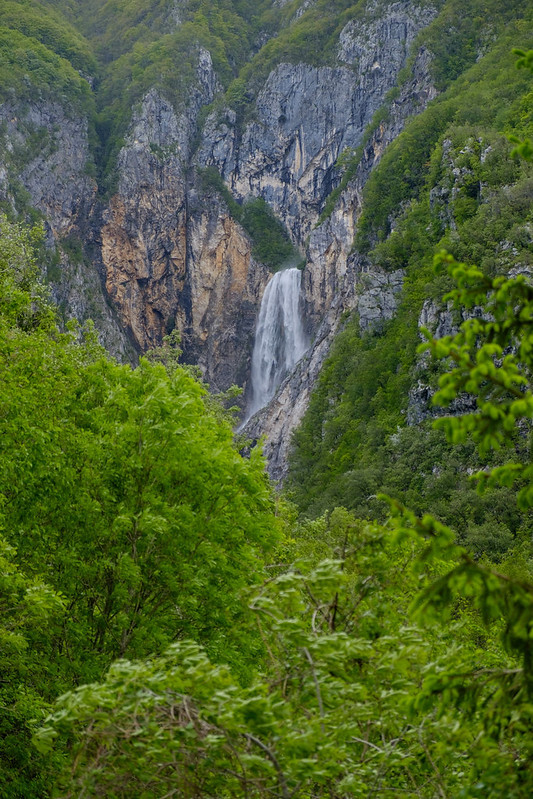
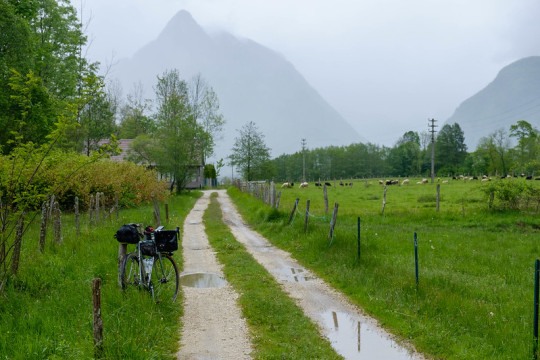
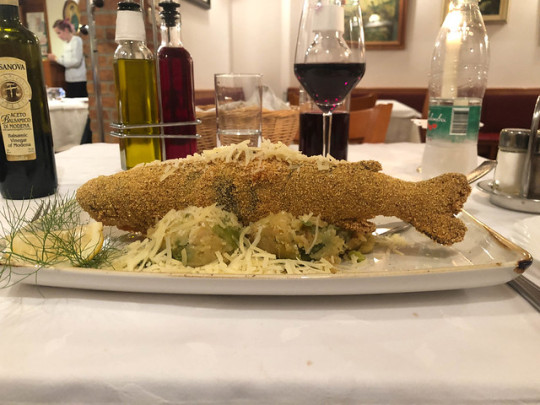
The next morning my body still wanted to wake up on NY time so I got a late start but when I got intel on the route I had planned I found out my intended one-way foray up to the Mangart Saddle was not going to be possible as the road was closed because of snow. I thought about trying it out anyway, but it is a one way road 30 miles out and back, with 5000’ of climbing, and I’d have to return right back to where I started in order to continue on the overall route. So it was not hard to decide to skip that part and I now had a short 20 mile day. This worked out swimmingly as these 20 miles were stunning and provided reason to stop and take photos almost every 50 feet. The wind was back and working against me and I cursed not following the general advice of doing this route in counter-clockwise direction. I took a wrong turn somewhere and then coming back for a ½ mile with the wind sent me sailing along at 30 mph without a pedal stroke. The Soca cut through a limestone gorge and my path followed more small roads and easy mountain bike trails, with a few river crossings over these lovely bridges.


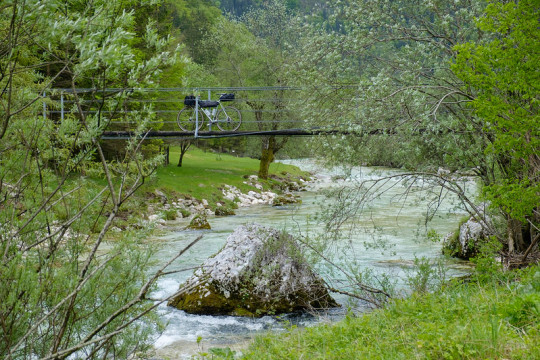
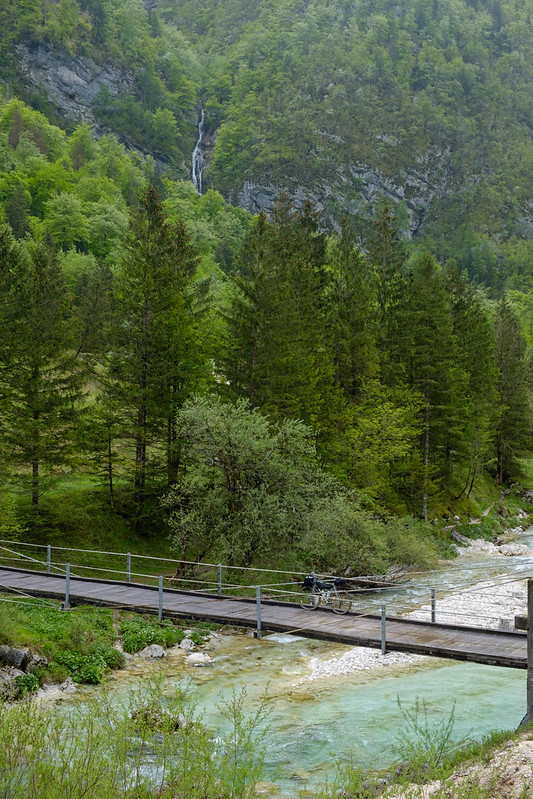
The mountains I had been pedaling towards started getting closer and closer and pretty soon I found myself at my destination of the Koča pri izviru Soče mountain hut.
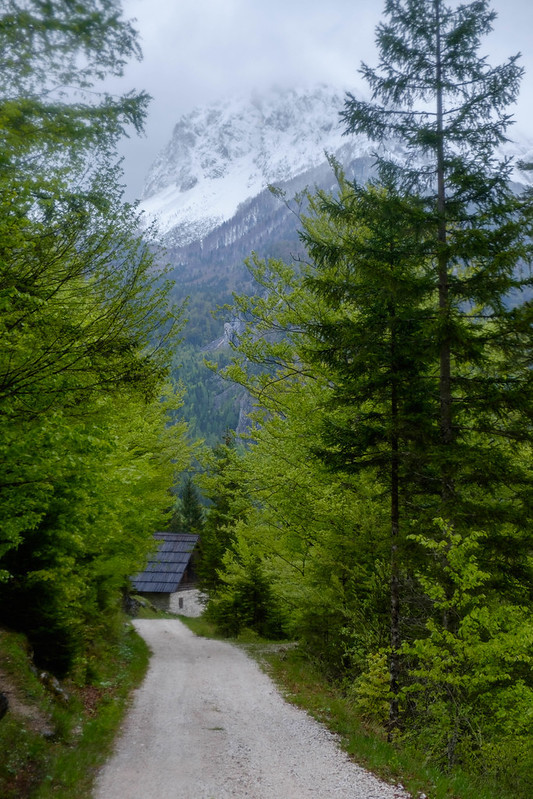
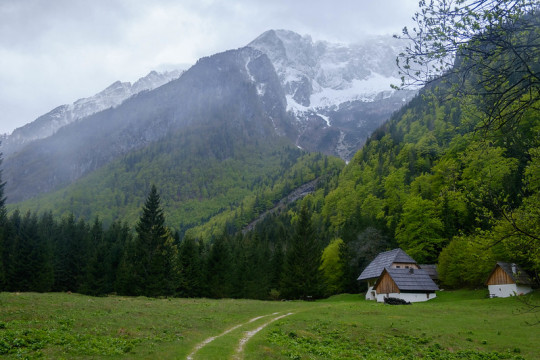

The hut is part of the Planinska Zveza Slovenije aka the Alpine Association of Slovenia and I had become a card carrying member the day before my trip, which meant I could sleep in the hut dormitory for a friendly 10 euro fee. It was early so I went on a rainy hike for the afternoon and I was glad I had packed my non-cycling shoes as the hike had me scaling some vertical faces before finding the source of the Soca river, a fissure in the mountain with a bottomless blue hole. The host of the hut fixed me up nicely with a wild mushroom stew, a delicious cottage cheese struklji, and a glass of wine. I climbed up the ladder into the loft dormitory and tucked in with my kindle for a good night of rest.
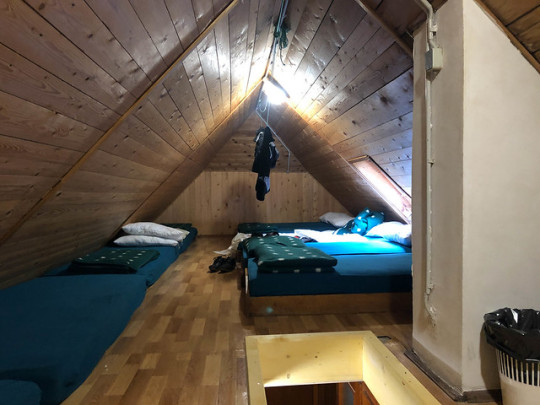
On the morning of Day 3 I breakfasted with my host again and discussed my cycling plans. She did not like my plan to continue up and over the Vrsic pass. The same snow that had closed the Mangart Saddle had apparently unofficially closed the road over Vrsic, unless your vehicle was equipped with snow chains. My bike was not. She called a hut-friend up on the mountain who confirmed her fears and told me I should not make an attempt. The detour was just not an option I would consider and I had been daydreaming about this pass for weeks so I thanked them both for their worry, but I’d be going up, and walking the bike if I needed to. As I stepped outside in the morning it was cold and grey again but I started pedaling and immediately climbing. Not 30 minutes later I was blessed with bright blue sunny skies that came out of nowhere and I knew I had made the right decision. The Vrsic Pass road is a military road built by Russian prisoners of war during World War I and has 50 numbered hairpin switchbacks, 26 going up on Trenta side and 24 (cobblestoned!) descending on the Kranska Gora side. The road was also absolutely stunning and a pleasure cycling up. The feeling was incredible. I looked behind me to see the valley from where I had just came, the sharp bends of the road getting smaller and smaller as I climbed higher and higher, and the surrounding mountains getting closer and closer and just could not believe this was reality.

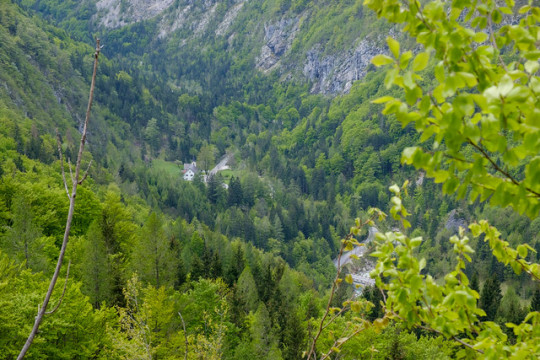
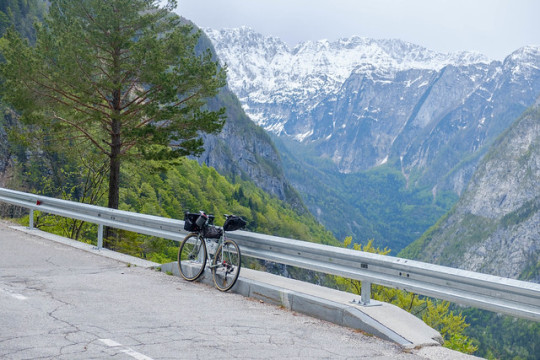

Somewhere around switchback 20 or so, I was nearly at the summit and the warnings came true. The temperature plummeted and the road surface was covered with a few inches of snow over a sheet of ice. I ran into an older Austrian couple I had spoken with the day before in their SUV as they were turning around because their vehicle couldn’t make it up the road. Despite the snow we shared this moment of excitement because of the beauty of the mountain peaks and the encouraging sunshine. They asked how it was cycling in the snow and I replied “it doesn’t matter. it’s beautiful” to which they replied in charming Austrian accents “IT IS SO BYOOTTEEEFULLLL”. I pedaled when I could and pushed the bike when I couldn’t and put on all my layers and both pairs of gloves and made my way across the 4 or 5 km of snow covered summit. A well placed hut provided a hot tea to warm myself back up before making the descent. The north side has cobblestones on each of the 24 hairpins which was not ideal for a bicycle moving way too fast, but maybe that extra caution kept me from flying off the road and off the mountain. In any case, the descent was over before I knew it and I paused at Lake Jasna to admire the morning’s accomplishment.

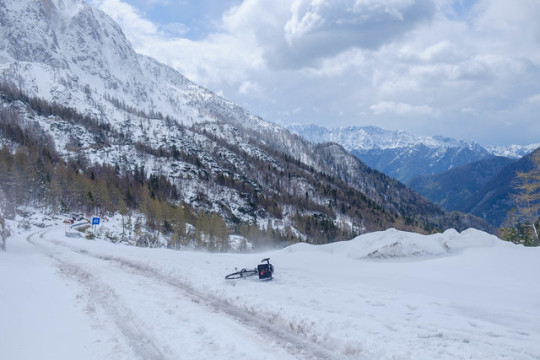
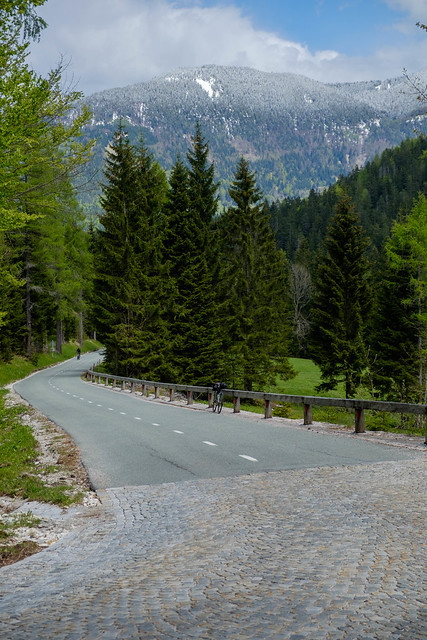
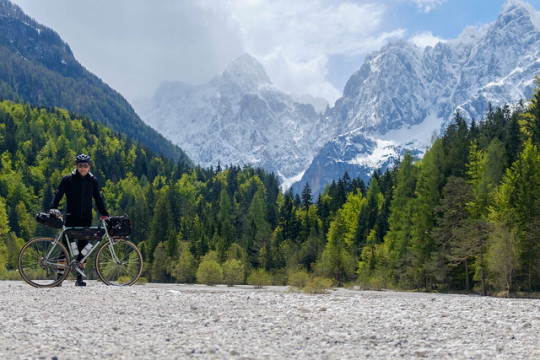
From here I would enjoy 25 miles of picture perfect solitary riding along a tiny perfectly paved road/path through the Triglavski National Park, all the way to Lake Bled.
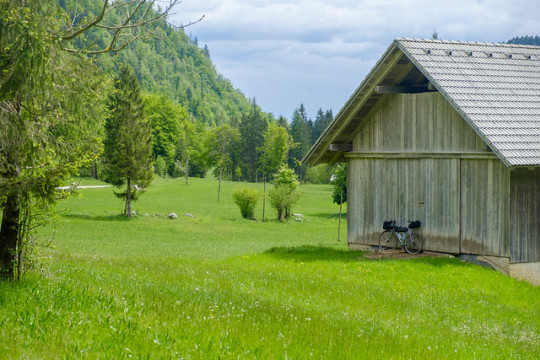
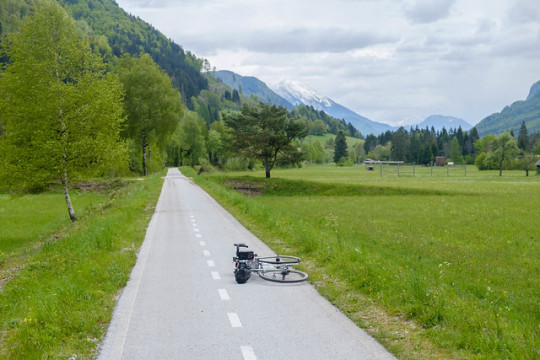
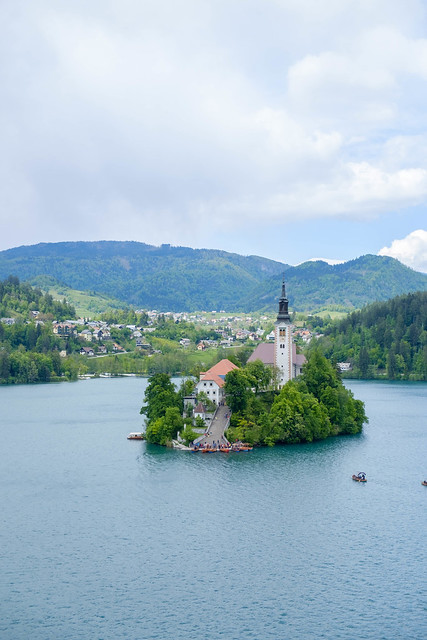

And somehow this cycling utopia of a road provided me with my only puncture of the trip.

A quick lunch in Bled and a lap around the lake and I continued on my way. After a few km I turned off the paved road and onto a mountain bike trail and started on the 2nd big climb for the day. A much smaller one at 580 m, but a much harder one thanks to the dirt and varying 8 – 15% grade.


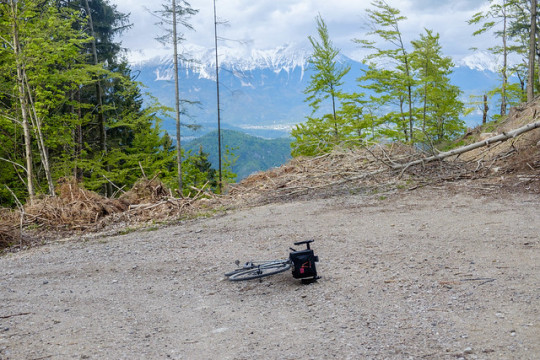
But the top would reward me well with this alpine meadow and a view the whole way down the other side of the mountain to Bohinjsko Jezero.
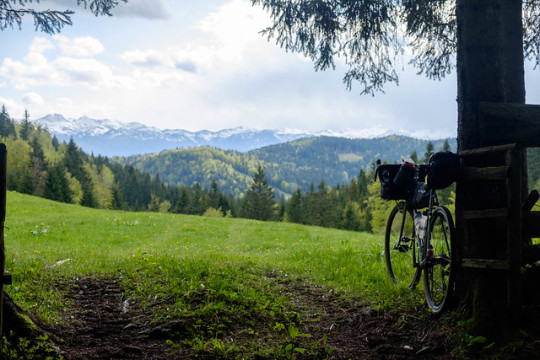
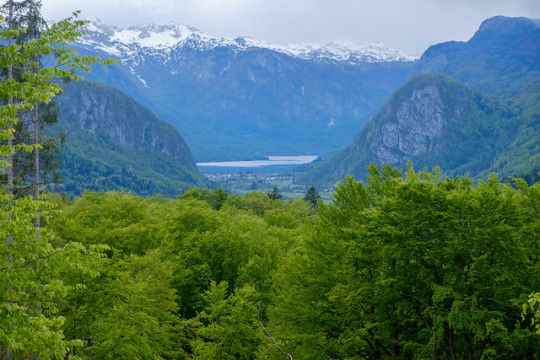
I was further rewarded with freshly paved and absolutely perfect tarmac which allowed me let the bike sing down the swoopy descent. There were a few shouts of excitement as I was having so much fun and my bike felt so good. A few minutes later I was down at the lake (Bohinjsko Jezero).
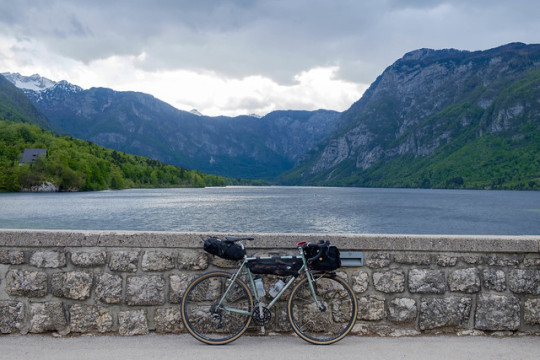
A quick pedal to look around town and then I had a 5 or 6 km ride back up into the woods to another Alpine Association hut where I planned to stay. I approached a closed looking hut but was happy to see there was a woman doing some work around the back. But unluckily she informed the hut was closed until the weekend. The day was too good to let this setback annoy me so I quickly turned around and another trip back down to town and I managed to find a lovely little hotel lodge to call home for the night with an excellent “Foksner” burger and great selection of Slovenian craft beers. I toasted to an unforgettable day on the bike and was drunk in one pint and asleep in two. The next morning I woke up high on the euphoria of such a good previous day. I didn’t have any epic alpine passes planned for the day but overall it was the biggest day of the trip I had planned. I looked out the window and saw a miserably grey sky and rain pouring down. I checked the forecast and it did not look good.
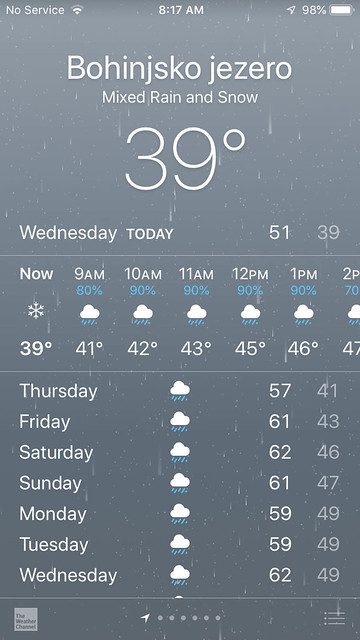
I reviewed my planned route and saw I had quite a bit of climbing and a lot of it was on mtb trails. This just did not sound fun in 40 degrees and rain all day so I decided to call an audible and re-routed myself to a more direct route on mostly pavement. This cut the day down to a more manageable 95 km. The rain never stopped aside from one hour of respite, and it was indeed cold, but I layered up, put some house music on my Bluetooth speaker on my handlebars, and got into a groove with my cadence and pedaled instinctively. It was great and miserable at the same time. The route would take me along some beautiful roads and some average ones, and eventually I reached my somewhat arbitrarily selected destination of Trojane.
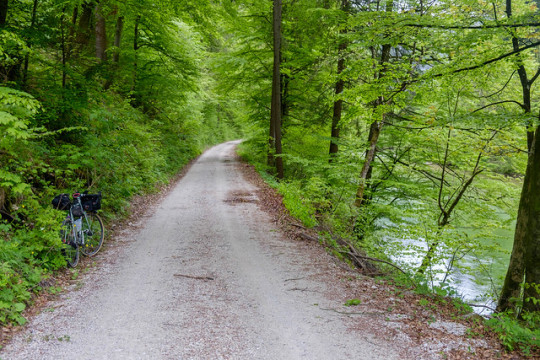

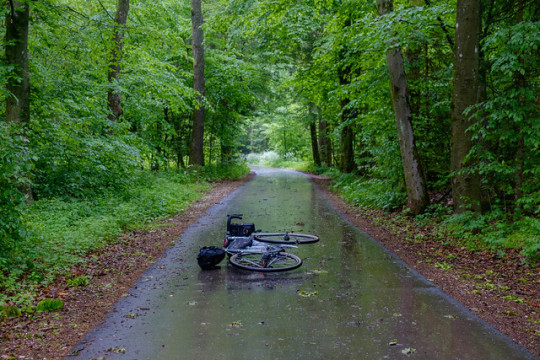
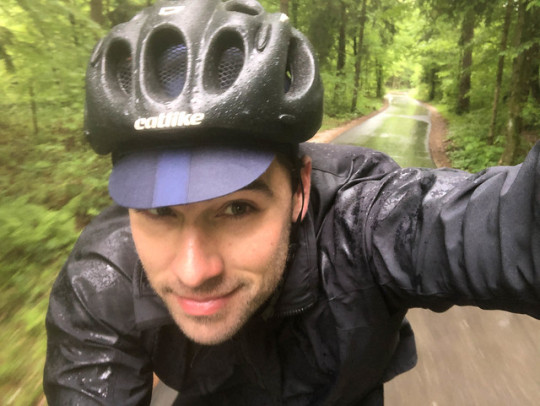
From Trojane I had picked out another Alpine hut for my accommodation. This was about 10 km outside of town and seemed doable from my review of the maps. My confidence was shaken though, by the previous day’s surprise closed hut. I continued out of town towards the woods and the hut. I got to the last remnants of a village before entering the woods and saw a woman outside and asked if she had any idea if it would be open or not. She didn’t speak a lick of English but grabbed her son who did and he knew the hut and was fairly confident it was only open on weekends so would be closed. I knew that would be a pretty terrible thing to trudge up to this hut only to come right back down, all in the cold pouring rain, at the end of a long day, and I also really liked the idea of a hot shower at that point (no showers at the Alpine huts) so I accepted defeat and headed back to Trojane for a hot tea and to figure out accommodation for the night. I met Melita in the Trojane café and we made friends and she was thrilled that I chose Slovenia for my cycling trip. We took a photo on her ancient digital camera. I took advantage of the wifi and successfully booked another cheap room at the wonderfully Soviet-esque meets mid-century modern Hotel Trojane. The hot shower made it worth every single euro (not that many!) and I cranked the heat and used my bike as a drying rack to try to dry off my thoroughly soaked clothing.
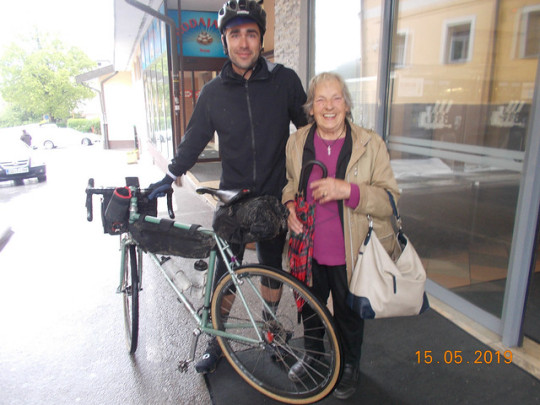
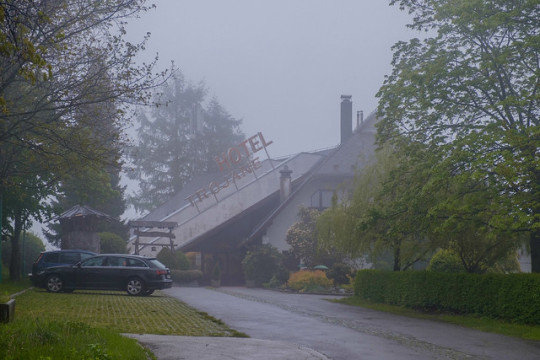
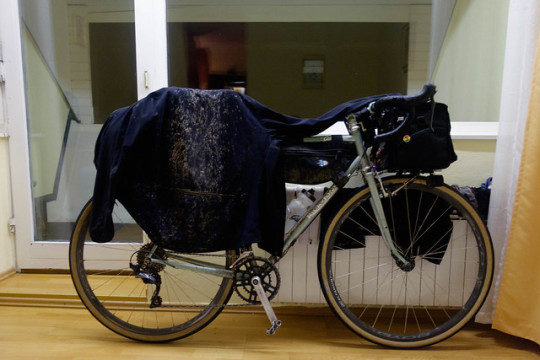
After an excellent night’s rest, I had an easy route planned from Trojane to Ljubljana for two day’s in the city. But I wanted more bikes so I planned a big epic murderous ride up to the Austrian border, across three mountain passes, and then back down to Ljubljana. Then I checked on road closure conditions and two of the passes were closed because of snow so I settled for something in the middle with one mountain pass. But before that I had to go see Hut Dom dr. Franca Goloba na Čemšeniški planini, which was supposed to be my destination the night before. I headed back out of town, passed the woman and son whom I had spoken to the day before, and then started to climb up into the woods. I soon realized I had very much made the right choice as the roads up to the hut went from

to

to
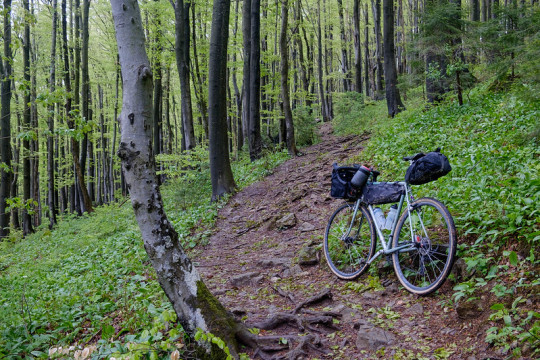
And they got stupid steep. But eventually, after a couple miles that felt like an a couple hundred, I came to the hut.
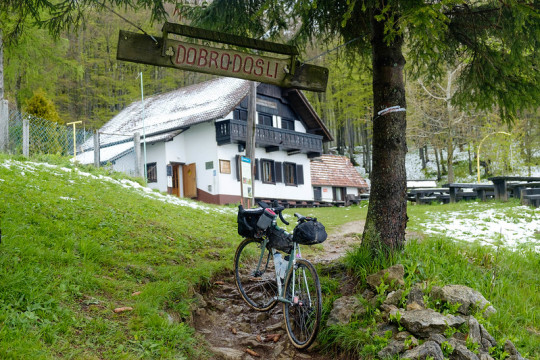
What an amazing place. The host was there doing some sprucing up and though she spoke no English I was at least able to confirm she was there the night before. I didn’t regret my decision but I sure was glad I still came to see the hut. The view off the mountain and across the valley below was breathtaking and the grounds of the hut were charming as possible. Picnic tables covered in snow with the sun shining and an incredible view meant I had to enjoy a morning beer.
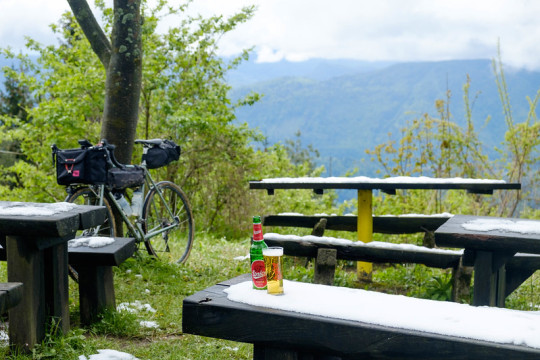

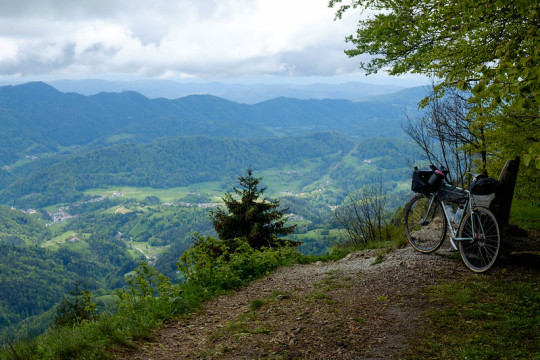
I enjoyed my beer and went back in the direction I had came but took another trail I thought might be more bike and less hike. It was not. But it eventually spit me out onto another dirt road which was a very fast way back down off the mountain.

I passed through Trojane one last time, grabbed a few snacks, and then quickly turned off the pavement and onto a forest road which was one of my favorite sections of the whole trip. I had the whole forest to myself and enjoyed beautiful and tranquil dirt roads in great shape as I climbed up and down the undulating hills. This heavenly dirt road brought me to another secondary paved road, a small mountain pass, and through a few small villages. I made a friend, enjoyed the rolling hills and perfect pavement, and soon found myself at the base of the Trobelkski Vrh climb. At 460 meters the climb was not insignificant but with grade hovering around 15% it was a worthy challenge, especially on my loaded bike. Luckily it rewarded my effort with another set of amazing views of my surroundings.
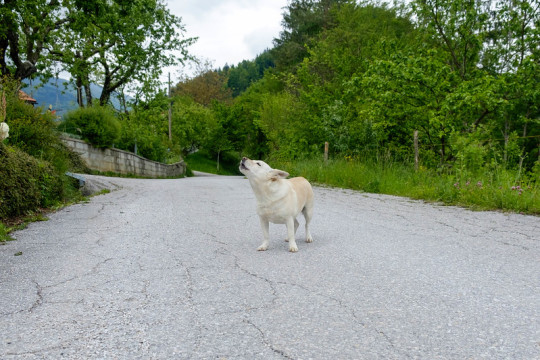
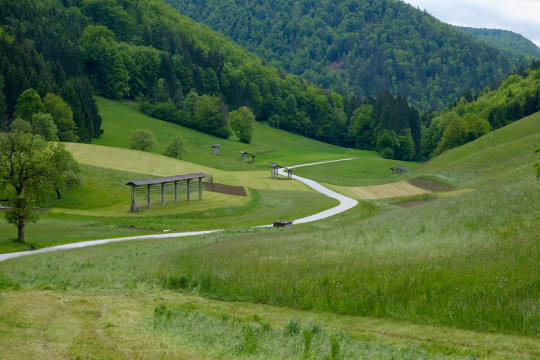


At the summit I turned onto a paved main road and had a thrilling 7 mile long descent back down to the Kamnik River. The asphalt was freshly laid and I raced a Subaru WRX down the hairpin turns. Towards the bottom there was a section of road work and the roadworkers were working on laying more of that sweet glass smooth asphalt. I yelled as I passed :chef kissing fingers: “IT’S BYOOTIFULLL” pointing the asphalt and they loved the appreciation and cheered me on with a round of ALLEZ ALLEZ ALLEZ. It was a great moment and made my already ear to ear smile stretch even bigger. I followed my route on into Ljubljana and easily found my hotel and settled in for two days of espresso, beer, and great food. Ljubljana is a lovely little European gem. The River Ljubljanica runs right through it with beautiful buildings and cafes running along it. The food is good, the beer is good and cheap and plentiful, the good espresso is really good, and everyone seems to be happy and friendly. It was a lovely little rest off the bike for two days.

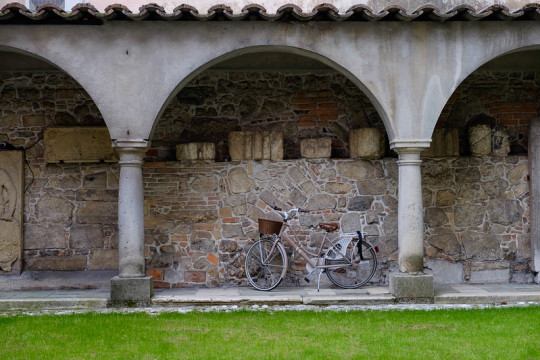
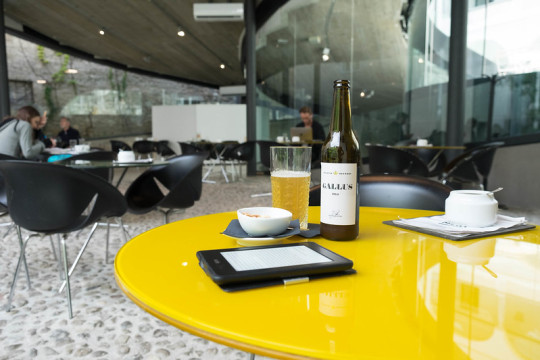
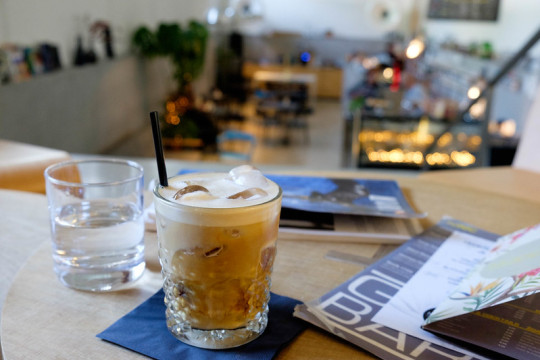
After two days of relaxing, eating, and drinking, it was time to get back on the bike. I called ahead this time to make sure the Alpine hut was open and promised the host I would be there by late afternoon. Then I loaded all my belongings back onto the Rick Jones and headed west out of the city.
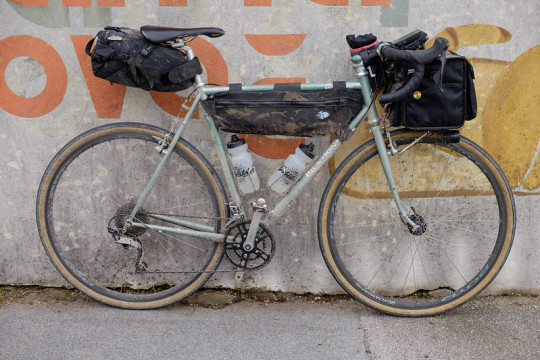
After 25 km of flat, boring riding I turned onto a dirt road and climbed a few hundred feet. Then another stretch of flat riding before I started up a really great 400 meter climb to the village of Podkraj. It started to rain along the way which put a bit of a damper on the long and fast descent, especially the -17% portion. I managed that ok but wished for disc brakes and cursed my luddite-ness. I entered into Slovenian wine country and cycled up and down and alongside numerous vineyards.

And then shortly after the village of Dolenje I was gingerly descending around a series of hairpin turns and all of a sudden I was on the pavement with a painful thud. I’m not sure what happened but my tire slipped out from under me as I was making my way around the curve, even though I was doing so really slowly. I crawled off the road and lay out in the grass moaning and groaning. I checked my bike and had to push the brake lever back into position and do my best to re-align the bent derailleur hanger. As I was laying there a car or two passed by, veeerryyyy very slowly and both checked to see that I was ok. A couple came cycling by on mountain bikes in the opposite direction as me and stopped to check on me and we chatted for a while. They were locals and told me everyone knows that road and especially that turn are dangerous and extremely slick.

Once I collected myself I had no choice but to continue on. From there I had 25 km to get to my hut. Luckily my bike worked well enough, even without perfect shifting. The rain started to come down hard with about 20 km to go so I gritted my teeth and pushed on, up into the woods again. The last 8 km or so were really gorgeous but there was no time for photos with the rain so I pressed ahead, anxious to make it to the hut and looking forward to a hot meal and a drink. Some time around 4 pm I got to the Hut Stjenkova koča na Trstelju and looked forward to drying off and going to sleep very early.

As I entered dripping wet I saw two men and a beautiful but terrifying German Shepherd. Then a third man bolted up from behind a table. He was the host, Bostjan, and I had just woken him up from his afternoon nap. “YOU! NEW YORK!?” he yelled out and I confirmed. He commanded I sit down and placed a beer in front of me straight away. From there it would turn into absolutely the most fun night of the trip. Bostjan, and his friends Dragan the casino craps dealer and Miha the former motocross champion of Yugoslavia and the beautiful blue-blooded lineage purebred German Shepherd called Siri welcomed me into their Saturday night party. The beer flowed non-stop, I fortified myself mid-way with a hearty stew, and then again with a late night pancetta party, Bostjan brought out home-made grappa from his fellow communist (“NO, SOCIALIST”) comrades, Dragan brought out his homegrown Slovenian mountain kishkish, we toasted to Tito’s portrait multiple times, and some time around 1 am we had drunken 20 L of Laško beer and the keg was kicked. I couldn’t have asked for a better last night in Slovenia. I will never forget those guys and the fun time we shared.
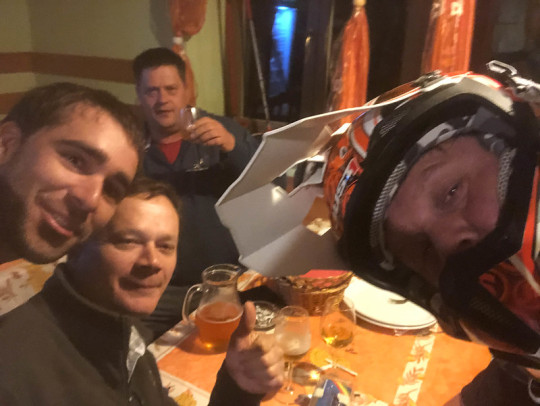
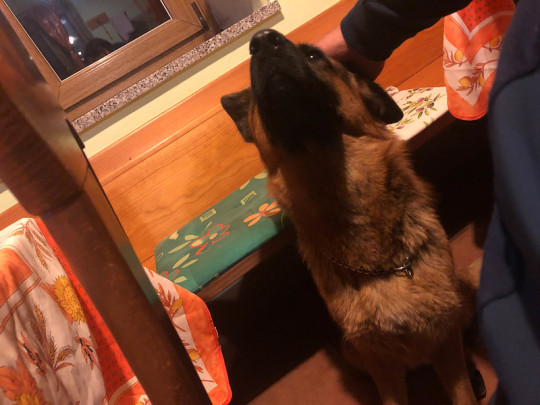
I woke up the next morning in a haze and hurting just as much from the crash the day before as from the drinking. Bostjan stumbled to the kitchen and prepared me a breakfast of scrambled eggs with beer, along with more pancetta and then I had a short last day to finish out the trip and return to Gorizia.
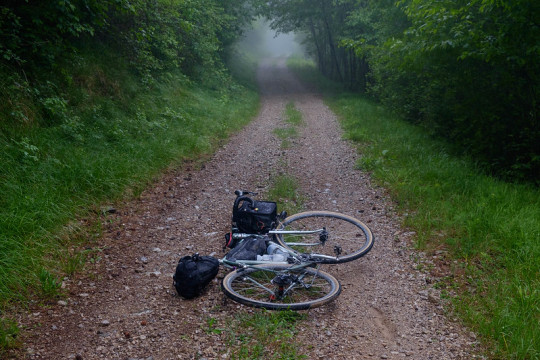
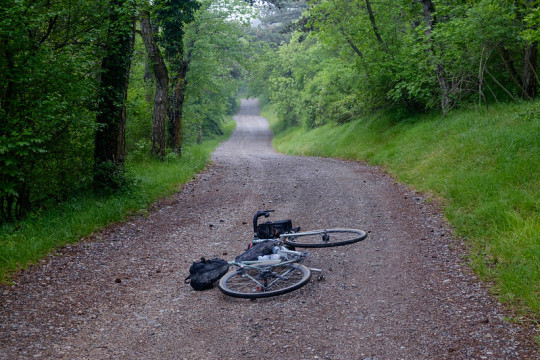
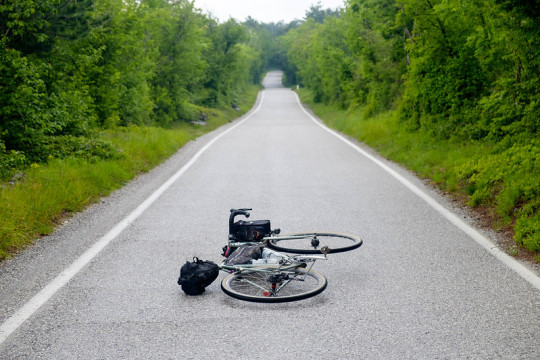
I was able to enjoy the mountain roads without so much rain this time and after a quick 50 km I was back in Italy and the whole town was closed since it was Sunday. I checked back into the hotel I had started the trip at, went through the tedious process of disassembling and packing my bike back into the s&s case, wandered aimlessly on foot until I eventually found something open ending up back at the same pizza place I had visited 7 days previous (very good pizza!), and got a night of rest before waking up early for the long travel journey of a train to Venezia, bus to the airport, 13 hour flight to Philadelphia, 6 hour layover which worked out perfectly for a happy hour reunion with friends, and then a one hour flight back to LaGuardia where I and thousands of other people would deal with the hell that is LaGuardia construction and transportation. At 2 am I walked back in the door of my Brooklyn apartment, dropped all my things at the front door, and collapsed into bed for a few quick hours of sleep before waking up for work and re-entrance into the real world.
Before I sign off, what sort of bike nerd would I be if I didn’t nerd out on my bike and gear selected for the trip. I wanted this to be a non-camping inn-to-inn or hut-to-hut in this case tour to keep the bike relatively lightweight and make the riding more fun. My Rick Jones has served me well for 7 years now and did not fail on this trip.
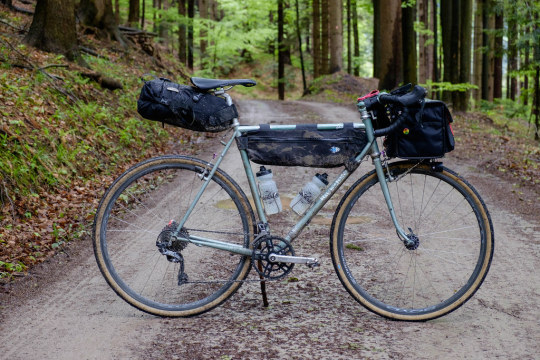
-Even with the front rando bag, frame bag, and saddle bag adding on about 15 or so lbs, the bike was spry and handles like a dream.
-Braking is, well…its as good as you can expect from cantilevers I suppose. Pretty decent when dry and alarmingly inadequate when wet, which happened to be most of the trip.
-I refreshed the drivetrain a couple months ago with new 11 speed Ultegra which proved as reliable as expected. I changed out the compact gearing for 46/30 sub-compact chainrings mounted onto my White Industries VBC cranks and really appreciated that choice at many times throughout the trip, both going up the alpine passes in the 30 tooth and cruising along on the flats and downhills in the 46.
-The way-too-complicated electrical system, yes electrical system, consists of the SonDelux dynamo hub powering an IQ-X front headlight, as well as a taillight, and a Sinewave Revolution usb charger. The setup got complicated when I had to make it demountable for packing into the S&S case with quick-disconnects all over the place. One ripped out as I was taking the bike apart, requiring a last minute solder and leaving me not all that confident in the system holding up to the travel and the trip. But it turned out to not be an issue and worked the entire time and survived the disassembly and trip home with no problems or re-soldering required.
-Tire selection was the do-it-all goldilocks of a tire Compass aka Rene Herse Bon Jon Pass 700c x 35 mm. Everything is tubeless compatible but I ran tubes due to the packing wheels tightly into a suitcase a little smaller than the wheels are round. Aside from that sudden crash which probably can’t be blamed on the tire, they were great and gave me the road and gravel performance I wanted, while still being able to handle some rough stuff when the route turned more towards mtb trail.
-Navigation was handled with my Hammerhead Karoo which is enormous but works very well and a great tool for touring and especially good when re-routing on the fly becomes necessary. Between my trip to Oaxaca in December and this trip to Slovenia, I have confidence in the Hammerhead to get me wherever I want to go.
-Bags consisted of a Swift Ozette rando bag out front, a Porcelain Rocket frame bag, and an Oveja Negra saddle bag. It looks like a generous amount of storage but it fills up pretty quickly and I needed all the space they provided for this trip. -Inside the bags I packed: (1) pair bibs + jersey + socks (rotated daily between the set I was wearing), an insulated Rapha gilet, a Search & State rain jacket, arm warmers, knee warmers, toe covers, a pair of full finger riding gloves, a pair of glove liners, and a merino wool neck gaiter. I was very glad to have every last piece of riding gear that I did as the temps and constant rain necessitated wearing everything on several occasions. I treated myself to the luxury of a pair of pants, a pair of shorts, a t-shirt, and a light wool sweater. Being able to change into dry normal clothes and the end of each long, wet day was a treat. And the most luxurious item packed was a pair of sneakers, which although they took up more than half the saddle bag they were also a god-send at the end of the day when I just wanted to take off the cycling shoes and for the couple of short hikes and the two days spent walking Ljubljana. Add in my Fuji XT1, a Kindle, a Bluetooth speaker, a headlamp, two water bottles, phone/wallet/passport, framepump, two tubes, tools, and a daily supply of snacks and that was the bike packed. I was happy with everything packed, and there was not a single item I regretted lugging around by bicycle for a few hundred km.
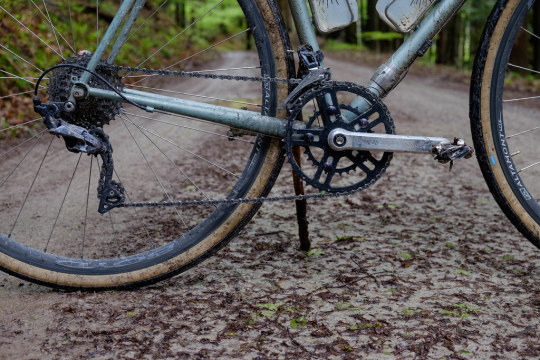


If anyone has actually read this far. Thank you for reading and now go visit Slovenia. Tell them I sent you and say hello. I am already scheming on a return trip next year with cycling and fly fishing combined.
Nasvidenje!
6 notes
·
View notes
Text
I have always been drawn to mountaineering. For whatever reason, it has always intrigued me and led me to want to climb something bigger than before. This is one of the reasons I chose to learn more about it, and research why it is that people are drawn to this form of extreme sport. Mountaineering tends to draw the most interesting and specific types of people. Many tend to be more ecologically minded, educated, open-minded and liberal leaning individuals. Perhaps those things are interchangeable, but in my experiences, these are the things of note that I have noticed about others with this passion. One difference, however, has been that I have seen very few women who are drawn to mountaineering as I am. This has led me to the idea of researching the question “Why do we climb?” and specifically, for me, why do women like me choose to climb? And how does gender play a role in their experience as climbers?
For women over the past one hundred and fifty years with this inclination, being a female in this field has not been the most welcoming. One of the pieces I read to help highlight this issue was the book entitled Savage Summit by Jennifer Jordan. This enlightening book tells the tale of the first five women who climbed K2, widely known to be one of the hardest and most dangerous peaks to summit. Jordan deftly details the ideas surrounding why these specific women chose to become climbers. Regarding the reactions of some men towards women who choose to climb, Jordan notes, “Many resented the intrusion of women into their very male pursuits, as if the presence of women somehow diluted the fun, the danger, and the escape of their adventures.” (Jordan 2) It has always seemed to me that alpinism was more of a “boys club” than other sports, but to see it written in ink that men feel that women are an intrusion upon their choice of sport gives me pause. Having researched about this topic for some time now, it is disheartening to see how much sexism is still rampant in most sectors but to find that it continues to be an issue in mountaineering is sad. Having learned so much about gender disparity over the past few semesters, I felt this was a very important issue for me to tackle regarding mountaineering. This disparity is not only generated from the Europeans and Americans on the expeditions, but also the locals in the surrounding Himalayan communities as well. As Jordan notes, “For women climbers, simply avoiding the hallowed ground evidently isn't good enough to mollify the Mountain Gods; local legend has it that the spirits don't want women anywhere near the sanctified summit for fear they will "pollute" its purity. Many devout believe this is why women have had so little success on Kangchenjunga.” (Jordan 169) This distaste for women is therefore rooted in a religious belief that the summit is pure. This explains some of the behavior exhibited by Sherpas that is seen in some of the other pieces I chose to read for this project. However, this outlook is baffling to me as Himalayan peak Mt. Everest is also known by locals as Chomolungma, Goddess Mother of the World. Perhaps the Goddess doesn’t want female company on the summit?
In the writings of Arlene Blum in her wonderfully descriptive and illuminating account of the all- female ascent of Annapurna entitled Annapurna: A Woman’s Place, she tackles the idea of gender disparity as well. I was eager to read what she had to say, since she is a well-respected mountaineer in her own right; but specifically as a female in the sport, she is one of the most legendary. Born in 1945, she was one of the pioneering women climbers at a time in history when women’s rights were becoming a part of the global discussion, so the fact that she was climbing at that time was definitely a turning point for mountaineering. She writes, “By 1972, when the idea for our all-woman expedition to Annapurna was originally conceived, no woman from any country had yet reached the summit of an 8,000-meter peak.” (Blum XXII) This is unsurprising at this point in time. Women were still struggling at this point in history to work their way out of the shadow of males in many different realms and clearly alpine climbing is like most other pastimes in this way. To choose to lead an expedition at this level is admirable especially since as Blum states in Annapurna: A Woman’s Place, “What are considered admirable traits in men–– assertiveness, independence, ambition, competitiveness,––are still often seen as undesirable in women. Yet most successful climbers, male or female, possess these characteristics.” (Blum 111) She is chose to create an expedition that actively broke with tradition on all these levels. These are definitely traits that are now considered more acceptable for women to embody, but at the time it was a very bold step forward. Even the Annapurna expedition slogan, “A woman’s place is on top,” was chosen in order to draw attention and create a discussion around gender.
However, it is refreshing to know that there was such a large movement at this point to back these women who were choosing to climb a notoriously difficult and unforgiving summit in order to make a step forward for the plight of females the world over. Annapurna I, more commonly referred to as Annapurna, is the largest in a massif (a grouping of a few summits in a small range that are all connected in some way) and rises 26,545 feet above sea level according to the Encyclopedia Britannica. This puts it at nearly 8091 meters, making this a perfect choice for women to climb in order to reach the milestone of 8000 meters. However, according to Blum, Annapurna is notorious for avalanche danger. “We had minimized the danger by climbing in the icefall only in the morning, when the ice was frozen solid, making sure we were safely down by the time the sun hit the cliffs in the late morning. I had been encouraged by this to attempt Annapurna despite the mountain's bad reputation for avalanches.” (Blum 115) Avalanche danger can be a very harrowing section of the study of mountaineering as I have come to realize. In my studies of various different climbing how-to books, large chapters have been dedicated to the understanding of what triggers avalanches, the conditions that exacerbates them, and avalanche search and rescue tips. The idea that this is not only just a thought at the back of the mind of these women, but an ongoing occurrence on this peak, is worrisome. However, it would seem that women are far more suited physiologically to climbing than men, and that may account for some of Blum’s lack of worry about climbing such a difficult peak.
The idea that women are less suited to climbing is definitely not rooted in scientific study, or at least not physiologically. Blum writes, “The average woman’s body is 25 percent fat, while an average man's is only 15 percent fat. This extra fat is an energy reserve that can help women to remain strong and healthy under the most severe conditions; it is said to give women a higher tolerance for cold, exposure, and starvation. [...] Women excel in athletic activities such as long-distance swimming in cold water, where their fat provides insulation and can also be mobilized for energy. It has been suggested that women may have superior ability to utilize fat for energy and consequently do relatively better at events that demand stamina more than sheer power.” (Blum 167) This definitely explains the success of the women who signed on to the expedition with Blum, but it also provides scientific data to oppose the thoughts of males in the sport at the time who felt women were not built for the challenge of climbing an 8,000 meter peak. This means that women who choose to climb have a sort of “edge” on the men with whom they are climbing as well, since their body physiology is conducive to being in cold weather and surviving, if not even thriving.
There are no specific tallies of how many men did not think women should be climbing, but there is anecdotal evidence to suggest that Sir Edmund Hillary, one half of the team that claimed the first ascent of Mount Everest, was against the idea of women climbing. A woman named Irene Beardsley was with her husband on an expedition that Hillary was leading, and as Blum notes, “Irene was eager to set a world altitude record for women. When Hillary became aware of this, he told Barry Bishop that he himself would be off the expedition if she set food above 19,000 feet. So Irene was restricted to helping Barry with his work below that altitude. "At that time no one thought this was an unusual way to treat a woman," she told me.” (Blum 60) The fact that this was not an unusual predicament for women to have to deal with is sad but clearly a part of our history, but to know that someone who held one of the highest honors in mountaineering was a part of the machine disenfranchising women is a sad insight into our society. So why fight against the status quo as a woman? Why do it? Why climb?
If we are looking at the general population of alpinists, studies have been done that interview climbers and assess the research as to the most common reasons behind climbing. In the study A Study Of Relationship Between Mountaineering Participation Motivation And Risk Perception, the general consensus was “The study also found that, mountaineers and their participation motives sake to challenge their skills and get self-confidence and a sense of accomplishment, and want to have the adventure experience, challenging nature, an exciting feeling, seek excitement and challenges, the development of new skills and want to experience the horror dangerous situations.” (Wen et al 3563) This fits in with many of the reasons why I climb. I climb in order to seek excitement and push my physical being beyond a point where I previously did not believe I would be able to take it. These are many of the same reasons listed but there must be more. There must be another reason why people find climbing so addictive, so imperative, and will risk their livelihoods in order to achieve it.
According to Spirit, Identity, and Self in Mountaineering by James Lester, many different factors drive people to climb, a sense of freedom being one of them. He refers back to a quote from the well-known climber Reinhold Messner, “Reinhold Messner (1992), the first person to climb Everest alone and without oxygen, gave voice to something similar to this: “The summit seemed so peaceful to me and the descent so unimportant, as if I meant nothing to myself; as if I had climbed out of a sea of loneliness into the safety of the universe” (p. 148).” (Lester 91) The mountains with nobody around is a very quiet, and admittedly, lonely place. Especially if you’re by yourself, and especially if you are not climbing a mountain climbed very frequently. I know I personally seek a freedom not available at sea level, a soaring of my spirit. Lester also notes that some people climb in order to have some form of contact with a higher power, “For me, the theme is signaled by words such as infinity, eternity (especially with a capital E), ecstasy, reverence, salvation, humility, and climbing accounts that speak of “a mysterious harmony,” “a presence and a peace,” a closeness to the “inner Being” of the universe, “a purpose larger than myself.” (Lester 96) I must admit that this appeals to me as well. I have read anecdotal accounts of others hearing and seeing things at
altitude that made them believe in something bigger than themselves, but in reality, I think it most likely is the idea that we are not alone in the universe that is appealing to so many people.
However, why do women themselves climb? Why fight to assert yourself at the highest levels of the sport? From Savage Summit, “For Chantal [Mauduit], the mountains provided a spiritual path she could not walk at home. To live a sensory experience, extreme yes, but extraordinary." (Jordan 201) But living a sensory experience is not something that is exclusive to climbing, there must be something more that is available to people who climb than just merely sensory exploration. Perhaps there is something more to it than just that. Perhaps it is something more pointed at the patriarchy. In Being A Girl Without Being A Girl by Karen Routledge, “If men were supposed to be the only players who could win at the climbers’ game, then successful female climbers could only indicate one of two things: either women were not all weaker than men or mountaineering was not that difficult.” (Routledge 55) Perhaps this was all a pointed look at the men who had dominated mountaineering for so long, and a percentage of wanting to climb was rooted in wanting to push back towards those that had prevented women from climbing at its highest levels for so long. She refers to Phyllis “Phyl” Munday, a Canadian mountaineer and naturalist, when saying “Since she climbed almost exclusively with men, she could have done what most women did and simply allowed the men to lead. Yet, according to Don, on at least one occasion she “insisted” on leading “among the worst of the masked crevasses.”(Routledge 47) So perhaps women do climb in some ways to push back.
So why do I climb? I honestly don’t know. I know part of it is pushing my body beyond what would be referred to as its physical limits. Other reasons are seeking a higher meaning in life and seeing parts of the world that are fleeting. Working hard to get to a point in a climb will always reward you with views that are saved for those that make the effort, and this is also something that drives me. Knowing I can help create awareness about these areas that are so fragile and will be some of the first areas impacted by climate change is another reason for which I climb. Most importantly, I climb because I have had the luck and fortune to live in an area that affords me the luxury of being close to mountains where this is possible, because I am have the drive to be healthy, and most importantly because I can.
Works Cited
Blum, Arlene. Annapurna: a Womans Place. Counterpoint, 2015.
Britannica, The Editors of Encyclopaedia. “Annapurna.” Encyclopædia Britannica, Encyclopædia
Britannica, Inc., 8 May 2013, www.britannica.com/place/Annapurna.
Jordan, Jennifer. Savage Summit. HarperCollins, 2005.
Lester, James. “Spirit, Identity, and Self in Mountaineering.” Journal of Humanistic Psychology, vol. 44, 1, 2004, pp. 86–100., doi:10.1177/0022167803257111.
Routledge, Karen. “‘Being a Girl without Being a Girl’: Gender and Mountaineering on Mount Waddington, 1926-36.(Biography).” BC Studies, no. 141, 2004, p. 31.
Yen-Chieh Wen, and Ching-Hui Lin. "A Study Of Relationship Between Mountaineering Participation Motivation And Risk Perception." (2012). Web.
1 note
·
View note
Text
Annotated Resources
Blum, Arlene. Annapurna: a Womans Place. Counterpoint, 2015.
This book is told from a woman’s point of view, regarding an all-woman team summitting Annapurna, widely considered to be one of, if not, the hardest mountain to climb in the world. Medium Priority.
Chin, Jimmy and Elizabeth Chai Vasarhelyi, directors. Meru. Meru, www.merufilm.com.
Arguably the most visually stunning and interesting films about a climb, this was put together by the now Academy Award winning duo of Chin and Vasarhelyi. This addresses the mindset, skills, hardships and setbacks which can go into a journey up a difficult mountain. I think this will be a helpful addition because it will give a more artistic and well-rounded look from a climber’s perspective. High priority.
Connally, Craig. The Mountaineering Handbook: Modern Tools and Techniques That Will Take You to the Top. Ragged Mountain Press, 2005.
I chose this for pretty obvious reasons, I wanted a holistic look at “how to mountaineer” and this is one of the two most prominent books on the subject along with Freedom of the Hills (listed below). It encompasses everything from avalanche safety, how to read weather patterns, how to read a topographical map all the way to wilderness medicine and how to sleep at higher altitudes. I also included Mountaineering: The Freedom of the Hills for the same reason since they are both widely regarded as the two “bibles” of mountaineering. High priority.
House, Steve, and Scott Johnston. Training for the New Alpinism: a Manual for the Climber as Athlete.
Patagonia Books, 2014.
This is widely considered the best book for learning how to create a training regimen for more advanced alpinism, so I think it will be a useful resource as to how to use it for creating a “training for Mt. Shasta” regimen. It will obviously be scaled back and not nearly as intensive since this book is used for training to climb things like Denali or Everest. Medium Priority.
Jordan, Jennifer. Savage Summit. HarperCollins, 2005.
This is a non-fiction book that focuses on some of the most well-regarded female mountaineers of the past century and their struggles with being a female in a mostly male world, as well as their struggles in life itself because of their chosen path. I thought this was perfect because as a female interested in mountaineering and noticing that I am one of a very small population of female climbers, I wanted to know what the gender struggle was for women like me, and how they addressed it, as well as how it has changed over the years. The author’s opinion is very clearly that women are considered “lesser” or “unwanted” by some male mountaineers so it will be interesting how this ties in to all my information. Medium Priority
Kaltenbrunner, Gerlinde, and Karin Steinbach Tarnutzer. Mountains in My Heart a Passion for Climbing. Mountaineers Books, 2014.
A mountaineering memoir from one of the most well-known female climbers, detailing her own experiences and outlooks on climbing and life in general as it relates to mountaineering. Low Priority, but I think it will have some interesting insight I might be able to use.
Lester, James. “Spirit, Identity, and Self in Mountaineering.” Journal of Humanistic Psychology, vol. 44, no. 1, 2004, pp. 86–100., doi:10.1177/0022167803257111.
I found this while researching “why people climb” and was intrigued by the research done by Lester in this article. I looked into him a bit and he is a climber but also a psychologist and author and this led me to find out that there are some interesting insights into climbing psychology in the book “Forever On The Mountain” by James Tabor, which addresses one of the worst mountaineering accidents in history that took place on Mount McKinley (now known as Denali.) This is a most interesting thing into which I am going to look, because that side of mountaineering has always intrigued me - why people do people do this despite the fact that so many people have perished while doing it? Why does this sort of thing intrigue even me? High Priority.
Monroe, Harriet. “John Muir - An Appreciation.” Sierra Club Bulletin - John Muir Memorial Number,
Jan. 1916.
This author/ poet was suggested to me this weekend by another member of the cohort, I thought I would add this in since it addresses the work of John Muir, whose work I have added some of and this might be a helpful addition in order to create a more holistic view of him. This also addresses some of the more “environmental” outlooks that are mentioned in other writings. Medium Priority.
Mountaineering: the Freedom of the Hills. Mountaineers Books, 2017.
The “bible” according to most contemporary mountaineers. This addresses all skills and information that is not covered in The Mountaineering Handbook, so I thought it was important to include them both because most people use them in conjunction. Highest priority.
Muir, John, et al. The Wild Muir: Twenty-Two of John Muirs Greatest Adventures. Yosemite Conservancy, 2014.
I would be neglectful if I didn’t include the father of environmentalism himself in my study of mountaineering. An accomplished mountaineer himself, he has some interesting writings addressing the very mountain I eventually endeavor to eventually climb myself! The idea that he has something to say about the mountain I intend to tackle is helpful and also lends a bit of history to the idea of Mount Shasta. His expertise in the mountains is unparalleled and it will be helpful to have his outlook on Shasta. High Priority.
Noble, Chris. Why We Climb: the Worlds Most Inspiring Climbers. Falcon, an Imprint of Globe Pequot, 2017.
This book is an important addition for me because in my studies over the last few weeks, I wanted to tackle the reasoning behind WHY we climb. What are the motivations for so many of us? I know some of my motivations are environmental in nature, but what are some of the other well-known mountaineers motivations? This includes the feats of such well-known climbers I admire as Conrad Anker and Peter Croft, as well others who discuss their approaches to mountaineering and ice climbing. High Priority.
Routledge, Karen. “‘Being a Girl without Being a Girl’: Gender and Mountaineering on Mount Waddington, 1926-36.(Biography).” BC Studies, no. 141, 2004, p. 31.
This directly addresses the idea of gender in reference to mountaineering, which I think is an important way to look at what drives what we do. I think this will help to flesh out the gender studies section of my project along with Savage Summit. I am excited to add these together and discuss them as a whole. High priority.
Selters, Andrew., and Michael Zanger. The Mt. Shasta Book: a Guide to Hiking, Climbing, Skiing, and
Exploring the Mountain and Surrounding Area. 2nd ed., Wilderness Press, 2000
For obvious reasons, this is a very important part of my project, since my basis is “how to train for mountaineering, and specifically, Mount Shasta.” Finding out what is referred to in the climbing community as “beta” about the routes available there, likely pitfalls, and where to camp as well as when to collect water, this book will be extremely helpful. Medium Priority.
Yen-Chieh Wen, and Ching-Hui Lin. "A Study Of Relationship Between Mountaineering Participation
Motivation And Risk Perception." (2012). Web.
Lastly, this study will help to address he reasoning as to why we climb from the same empirical data standpoint that Spirit, Identity and Self in Mountaineering will help. The Lester article takes a more philosophical standpoint and this study takes a more scientific look at the motivation behind climbing, which I think is an important part of the discussion to address. High Priority.
1 note
·
View note
Text
2020 in Mountains
I’m not saying anything new when I say 2020 sucked in many ways. Now that I’ve gotten the required acknowledgement of 2020 as a total disaster out of the way, I can get to documenting and appreciating what I was able to experience this year. This post is long because I was able to take three months off in between jobs, which featured many adventures, and it also goes over the many life changes I made as a result of COVID which have very much affected my mountain activities.
Winter
I started off the year leaving my job on January 2nd and jumping into enjoying three months off before starting my new job. How I got so incredibly lucky with the timing (getting to freely travel the last 3 months before the pandemic took over the world??), I’ll never know. I am so thankful for it, so glad I took advantage, and really just take it as an affirmation that you need to enjoy life instead of working 24/7. You never know when a global pandemic will happen and throw all your plans in the trash.
I spent the first part of winter driving around California, Utah, and a little bit of Colorado, skiing and ice climbing while training for a bigger trip to Ecuador. I love these open-ended mountain days where you just do whatever sport is best for the conditions. I went to Ouray for the first time, and I really enjoyed the ice park. I look forward to going back someday and hopefully hopping on a route or two in the backcountry as well.

My natural belay habitat.
Ecuador
The biggest part of my 3 months off was a trip to Ecuador. I had been itching to get some high altitude experience to prepare for objectives like Denali. I ended up going to Ecuador simply because it was the right season to go there, but it did not disappoint at all. For once I did a guided trip because, a) I had no partner readily available (having only signed up for the trip maybe 8 weeks before?), and b) I wanted to treat myself to not having to figure out logistics in a foreign country for once. I went with the company Alpine Ascents, and they definitely have the trip well-dialed. Every accommodation we stayed at was plush (we stayed at a high altitude hot spring resort as part of acclimatization, best acclimatization ever), the food was delicious, and the guides were kind, knowledgeable, and all around great. In particular, Jose Luis Peralvo, the head guide, was such a pleasure to be around. He is an incredibly experienced guide (300+ Cotopaxi ascents, 3 Everest ascents), super encouraging (I promised him I’d lead some pitches on El Cap when someday Leo and I climb Lurking Fear), very patient, and so good-natured. I would love to climb with him again (Antisana someday??).
On this trip, we attempted to climb three high altitude peaks: Cayambe (18,996′), Cotopaxi (19,347′), and Chimborazo (20,564′), in that order. With my previous altitude record being Mont Blanc (15,777′), these would each be new records for me. The conditions on the first climb, Cayambe, were challenging. We found ourselves in a damp cloud layer that covered us all in a thin layer of ice. I was shocked how slow I was moving, which was hugely demotivating. I made the mistake of letting my mittens get frozen from the moisture of the cloud. When one of the guides suggested we turn around at about 17,500’, I reluctantly agreed and felt very down on myself the whole way down. But with no vis (and thus no views), miserable conditions, and challenges with the altitude, I think it was the right choice. At the time I felt very down on high altitude mountaineering and wasn’t sure it was for me. It really is hard knowing you’re moving so slowly compared to your normal experience in the mountains. Thankfully, the next summit attempt, two days later, went much better. On Cotopaxi we had perfect weather, and my acclimatization was starting to kick in. I was still moving very slowly, but found myself able to keep going (though I also did collapse on the summit). This summit hugely lifted my spirits and made me feel like I just needed to give my body more time to acclimate. This felt especially true when on the last summit, Chimborazo (over 1000’ taller than Cotopaxi), I was the fastest client in the group. Cotopaxi track. Chimborazo track.

Now I feel prepared mentally for my next high altitude trip, whenever it may be. I know that my body can acclimate, it just needs the time to do so and I need to be patient.
I would go back to Ecuador in a heartbeat. The mountains are beautiful, the food is delicious, the people are kind. While I would not typically travel somewhere to climb a peak a second time by the same route, I’d climb Cotopaxi again without a doubt. It’s one of the most beautiful mountains I’ve ever been on. I keep telling Leo someday we’ll do an Ecuador trip to climb Cotopaxi (and stay at Tambopaxi again, of course), and an ice route on Antisana (hopefully with Jose Luis!).
At the end of my Alpine Ascents trip, I took advantage of the fact that I was unemployed and in Ecuador and spent a week in the Galapagos on a cruise that visits many different islands. This was far from the normal type of trip I take (I didn’t climb a single mountain!), but I loved it. The hype is real: the Galapagos is a very special place.
After returning from Ecuador, I stepped back into winter in the Western US. Since February had been incredibly dry in the Sierra, I took the change to climb some peaks on my list in the Eastern Sierra: Thor Peak in the Whitney Zone (track), and Cartago Peak (track), my first peak from 395. Winter decided to return immediately after, which made for some fun skiing.

Fairy Meadows
The last thing I did before starting my new job was a hut ski trip in Canada. I had managed to convince Leo, Becca, Lita, and Nikhil to all sign up for a trip to the Bill Putnam Hut in Fairy Meadows in BC. Being a good enough skier to make the money spent on a hut trip worth it had been a dream of mine since I learned to ski, watching my sister Dafna go on these types of trips every year. I’m probably right on the edge of being a good enough skier… But I made it work. We had 7 days of blue skies and sun, letting us ski all over the area. It was my first time really skiing glaciated terrain, which was a great experience, and I summited a few peaks as well! Most notably Adamant Mountain, which is very challenging to do in the winter due to avy conditions. Sadly, for this one, I retraced my steps down the bootpack with my skis on my back since I was too nervous about skiing this no-fall terrain above open crevasses, but it was still a great experience. All in all it was a great trip with good friends in an extraordinary place.
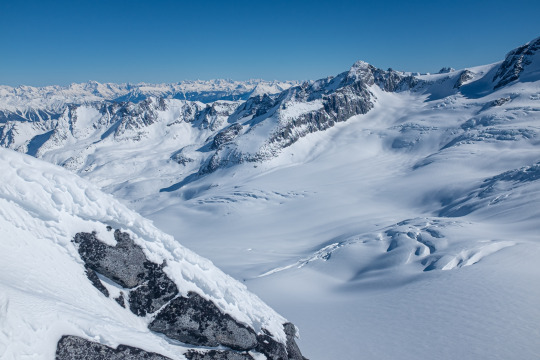
This trip was March 14th to 21st, so it happened very much while the whole world was shutting down. I had hemmed and hawed constantly in the lead up to it, feeling very anxious about whether we should just cancel and whether we’d be able to get back into the US. In the end, I decided to drive instead of fly, to reduce contact with others and still be able to get back to the US should all the flights be canceled. In retrospect, I think it was a pretty risky choice, but I’m also glad I went since “nothing bad happened”. We ended up being the last trip to the hut before they canceled the rest of the season, so there were of course many jokes about how they should just fly us in some food on the helicopter and we’d just stay there to wait out the pandemic, what a dream! (How foolish we were to think this might be over relatively quickly). It was definitely surreal coming back to the hut everyday and sending out InReach messages to learn what had changed in the world while we had been out skiing. I drove from Rodgers Pass to Seattle on March 21st, spending the night at Lita’s (since we had been on the trip together anyways), before making the rest of the drive back to San Francisco the next day and sitting on my couch for a week waiting for my new job to start. That week I stayed home, Tahoe got incredible powder and it was so hard to sit it out, but it was the right thing to do given the circumstances.

The next few months, like most people, I basically stayed home, trying to run for fitness while we cooked a lot, took on new hobbies (gardening for me, sourdough for Leo), and grew our home gym equipment.
Summer into Fall
As summer approached and we learned that the danger of contracting COVID was much less severe outdoors, I finally started to venture outside. My first forays were tagging some OGUL peaks in Tahoe, and I definitely learned I had lost some hiking fitness. But it was great to finally be back in the mountains, tagging random summits with no people around. This also helped get my legs back into hiking shape for what became a great summer.
Our close friends Marco and Daiyi had been in Mammoth since the pandemic began, seeking out more open spaces to be outside during the pandemic. They decided they wanted to make it permanent and asked us early on in the pandemic if we’d want to move in with them in Mammoth. Leo and I initially said no, because so many small towns were begging people to stay away and not bring the virus. But as things changed over the next 3 months, we came around to the idea. It took some persuasion, but I finally convinced Leo we should just go for it. Housing is incredibly difficult to come by in Mammoth, but Daiyi was diligent and able to find a house for us all to rent together, starting July 1st.
Leo and I did not move in until mid-July because of the big thing in Leo’s life: meniscus surgery. It had taken his doctors months to diagnose he had torn his meniscus the previous November, preventing him from running at all or skiing confidently. He had surgery in early June and wanted to stay local in the bay area for his follow up appointments six weeks post-op. Leo was understandably less excited about moving to Mammoth since he would be recovering from surgery and wouldn’t get to recreate as much. I was much more pessimistic (or, what ended up being correct) about the pandemic, and thought we’d still be in Mammoth by the time he was more mobile, and so we moved! We gave up our apartment in San Francisco and went all in on our Mammoth lease.
I had wanted to try living in the mountains ever since we finished our six month van trip in 2017, and we finally found the time to make it happen without any repercussions to our careers. Now that we’ve been here for seven months, we both love it and have no interest in returning to the city anytime soon.
So, living in Mammoth, I removed 13+ hours of driving from every weekend of my life and found myself so much closer to many of the peaks I’d been wanting to climb. Our first weekend in Mammoth, we tackled Dragon Peak out of Onion Valley which ended up being a very fun scramble. This was the first of many “Mammoth to Mammoth” adventures!

When Ariel is dressed in all of your clothes so you think she is you in every picture. :D
Some of the other highlights from my summer season included:
Red Slate Mountain: I’d been saving this to climb via the couloir, but decided to finally just go for it in summer in light of the fatal accident that happened the previous year. This was my first outing with Mica, Daiyi and Marco’s dog, and she killed it! I have to say, getting to watch whatever funny things a dog does on a hike makes it so much more entertaining and joyful. This was another Mammoth to Mammoth one, which is just such a treat to sleep in your own bed and still have a full day in the mountains. It was also the second of many peaks I climbed with Daiyi, and it became such a joy to do these slogs with my roommate that brings her own stoke! Rafee was there too. :) Hi Rafee! And Brice and Sadie joined for the first third, with two dogs as well! The red colors of this area are so pretty – an excellent way to start our new life in Mammoth. Track
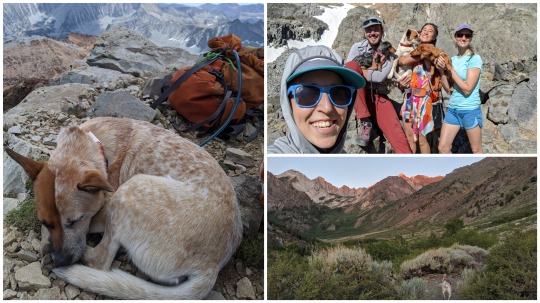
Sleepy dingo on the summit.
Tunnabora Peak and Mount Carillon: These are two fun peaks in the Whitney Zone and just, wow, I was able to do a casual weekend trip to the Whitney Zone! In my previous life, driving all the way to Lone Pine was a big ordeal – something I could only do maybe once or twice a season. And here I was solo on a random Saturday to just climb some peaks. It ended up being a gorgeous day on two fun summits with a swim in the highest named lake in California! Track
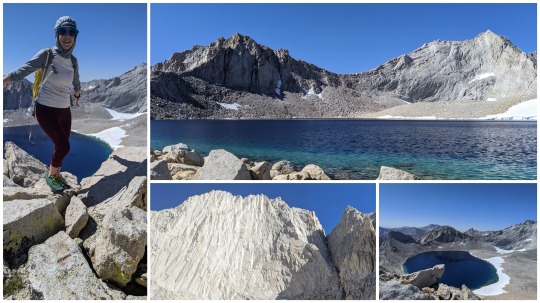
Mount Goethe: This was a fun scramble (albeit with a long approach). The scramble from Alpine Col was really enjoyable with some fun exposure. And I got to do this on a Sunday and not get home at an absurd hour! A good day out with Rafee. Track
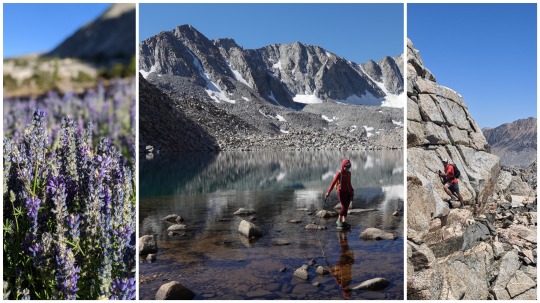
Mount Thompson: Another fun scramble with Rafee. The ridge from Ski Mountaineers Peak to the summit looked pretty nuts and like it would not go, but sure enough there was a way. Also, this was less than 15 mi and 4000 ft. Always a treat to find an SPS I have left that is relatively short! Track
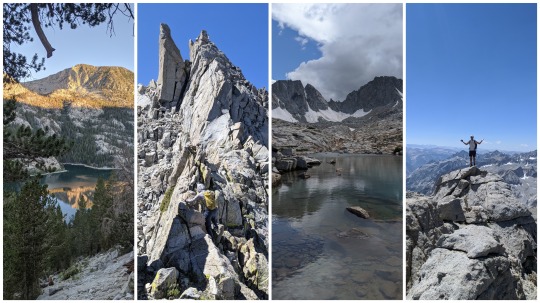
When Rafee doesn’t know what to do with his hands on the summit.
Mount Warren: Honestly, this peak is not very enticing and is really just a talus slog in the summer. But what made it special was it was my first peak just Mica and me! It took a peak that would typically be one you’re just trying to cross off to being pretty entertaining watching the dingo run up and down the talus endlessly. And we found a few snow patches which she loved, which are hilarious to watch her roll around in. It was so exciting to see that she stuck with me and came when I called her. Thanks for the company, Mica! Track

The only thing Mica loves more than playing in a snowpatch is eating a squirrel.
Bloody Mountain: Another peak that isn’t notable in the summer, but it was Leo’s first off trail hike post-knee surgery, and he did it in honor of my 100th SPS! It was nice to finally get back into the mountains with him :) especially for this exciting occasion. Track
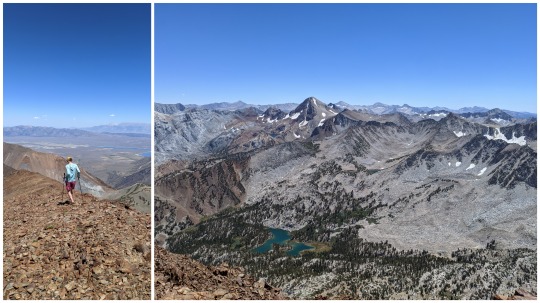
The only time I’ve carried more gear than Leo! Thankfully, he did not get used to it.
Disappointment Peak: Perhaps my biggest individual day of the summer in terms of hours? A year prior, I had finally promised myself 2020 would be the year I join some days of the Sierra Challenge. But then the pandemic happened and I felt less stoked on trying to spend time with new folks. This was the one day I decided to join (largely because I was most excited about the opportunity for this peak). However, due to chance of thunderstorms and my not being Bob Burd speed, we started before the rest of the group and didn’t connect much with them, sadly. Regardless, this was a challenging yet excellent peak. Heading up the snowfield to the ridge was a bit thought provoking since I hadn’t spent time in crampons in months, and the scramble below the ridge had challenging route-finding. It felt really good to be able to cross this one off, one of the harder peaks on the SPS list. Track
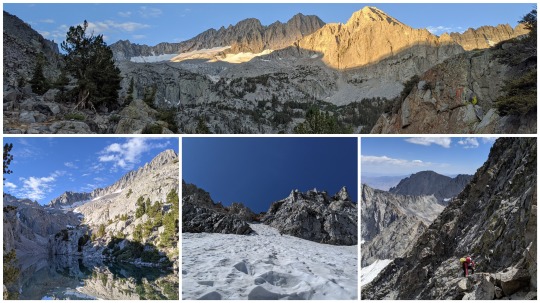
Mount Davis: My biggest self-sandbag of the summer. When you expect a peak to be about 20 mi round trip but it’s actually 27... woops! Daiyi joined me for this peak along with her friend Phil that was visiting. They had planned on a backpacking trip, but canceled due to smoke. I convinced them to join me on this peak in Ansel Adams Wilderness, and they were great sports when it ended up being more than 30% longer than expected with endless talus… Always fun to get to visit Thousand Island Lake though! We had planned to meet Leo (who was building up his on-trail hiking mileage) at Thousand Island and hike back out together, but we were about 5 hours behind him due to my poor planning… Always learning! Track

Such good sports even though I totally sandbagged them!
Labor Day Peaks Extravaganza! Center Peak, Caltech Peak, Mount Ericsson, Mount Stanford: After doing a smattering of peaks over Labor Day weekend the year before, I was excited to do something similar this year – taking the opportunity to get pretty far into the backcountry. Luckily, Daiyi was also interested in a trip like this! The only requirement was that we include Caltech Peak on the list, since Daiyi had attempted it as her first ever backpacking trip with Caltech classmates (though they didn’t end up summiting). We entered over University Pass (my first time up it), taking the wrong chute down the other side and losing a lot of time due to our mistake. From there, we did a carry over of Center Peak, camping at the last lake before Forester Pass. We had also hoped to climb Junction Peak that day and camp on the other side of Forester Pass, but knew that was aggressive. We woke early the next morning, headed over the pass, and did a carryover of Caltech Peak. This was actually a lovely scramble, with interesting route finding down the other side. From there, we headed over to Harrison Pass where we got to drop our packs for the first time. We did the scramble up Mount Ericsson, which was also quite fun and interesting. We headed back to Harrison Pass, where Daiyi opted to sit out the last peak of the day, Mount Stanford. I found this scramble to be spookier and looser than I was expecting and almost bailed, but managed to add this last summit. This brought me to three remote SPS in one day! All the while, smoke had been creeping in from the Castle Fire down in southern SEKI. I got back to the packs maybe an hour before dark, and Daiyi and I descended Harrison Pass to the basin to the north, finding a nice campsite near a lake. Pro tip: there is no longer a trail at Harrison Pass, despite what maps may show, which we learned the hard way. :( We were worried about the smoke, thinking there was a good chance we’d hike out in the morning and cut our trip short. When we woke, the smoke did indeed seem worse, so we called the trip and headed cross country to the north past Deerhorn for many miles until we finally hit the JMT. We learned via InReach on the hike out a new fire (what was actually the enormous Creek Fire) had started the previous day and the smoke at home in Mammoth was insane. When we crested Kearsarge Pass on our hike out, we were hit with an even thicker wall of smoke. It was absurd to see folks having campfires back at the Onion Valley Campground. While the horrible fires cut our trip short, what we did accomplish was beyond fun, and I was so glad we got out on a challenging trip before the forests closed for the next two months. Track 1, Track 2, Track 3
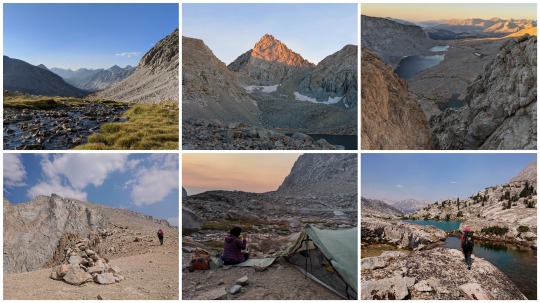
Mount Hitchcock: Once the Creek Fire finally got some snow on it and the forests opened up, there were several good weekends for getting into the high country (albeit very cold!). I again went to the Whitney Zone, this time with Rafee, Sarah, and Peter (who I hadn’t seen all summer!). It felt so good to be back in the Sierra. This peak itself wasn’t a particularly interesting climb, but this area is just so gorgeous that it was still worthwhile. There were a good amount of people taking the trail up Whitney, of course, so it’s always funny when they ask you about your plans to summit when you’re talking about totally different mountains. Track
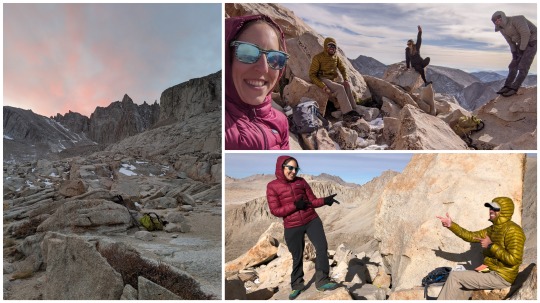
Summit social distancing, lolz.
Mount McAdie: My last real peak of the year, before more substantial snows came (though it was hike-in-your-puffy cold). I was happy to take advantage of Kavya’s tendonitis from climbing, so she was looking to hike! Despite having been in the Whitney Zone not too long before, it was still nice to be back. I though the scramble up McAdie was nice, in a lovely position. I can’t wait to go back for Irvine! Track

Climbing
I didn’t do as much alpine climbing this year because Leo is my main alpine climbing partner and he was healing up from surgery. With the gyms closed, I was still determined though to not let my arms totally atrophy, which meant I climbed outside a lot (well, a lot for me). I led a lot more than I have in past years (again, not saying much, but I’ll take it!), and I’m excited to keep working on it, even though it’s not my primary sport. Going to the local spots in Mammoth in the summer was really nice on weekdays, and then as we moved into fall and winter, Owen’s River Gorge has been a great place to get some mileage in. I don’t hate cragging as much when I just think of it as an alternative to the gym. :D And it’s important to keep climbing so I’m prepared for the climbing goals I’d like to accomplish this year now that Leo is back in action!
Training
With finding myself having far less expenses moving to Mammoth and no longer having a gym membership, I decided to take the plunge and hire a mountain coach via Uphill Athlete in July. It’s hard for me to measure the gains since I haven’t had a full summer season with a lot of training under my belt, but it has been a huge help in keeping me motivated and actually exercising nearly every day. Not to mention that before I could hardly get myself to do strength workouts or stretching, but now, since they’re on the schedule that I’m paying for, I do them. I’m feeling good and motivated, and I’m excited to see the dividends the training will hopefully have this coming summer.
Everything else
Moving to Mammoth has been such a joy, and I am so thankful to be here. I am so thankful that I am employed at all, and that I can work easily from an amazing place like this. I had been wanting to try moving to the mountains for a number of years, and I’m so grateful for this opportunity (even though it did come in such an awful way). 2020 definitely affirmed that life is short and I need to seek out the things I love; it had been so silly to delay all this time. People always ask if we’re here permanently, and I have no clue. I just know that we’re here for now, and it’s the place I want to be most right now. So we’re signing another year-long lease, and we’ll go from there.
What did I check off my list from last year?
Here I’m pulling my list of goals from last year seeing how I fared:
Making more mountain friends – well, there was a pandemic. I get a pass on this one 🙅♀️
Ecuador peaks – I climbed 2/3! I’ll take it ✅
Training for Ecuador, and continue training for the future – hell yeah I did this! ✅
Getting better at skiing – I did this a bit, but the end of the season was cut short due to the pandemic 🤷♀️
Spending some days at the Sierra Challenge – I did one day! Again, pass due to the pandemic. Will need to do at least two days this coming year :) 🤷♀️
Clyde Minaret via the 5.8 50 Classic – Did not do, saving this to do with Leo who was broken 🤷♀️
Lone Pine Peak via the North Ridge – Same as the previous 🤷♀️
Split Mountain (my last CA 14er) – The trailhead was closed due to a fire the previous year, so I let it go 🤷♀️
Boundary Peak – I didn’t do this and have no excuse. Now I live one hour from the trailhead! 🙅♀️
Reaching 100 peaks on the SPS list – I did this and then some. Ended the year at 113 ✅
A potential Orizaba trip over the winter holidays! – Haha, another COVID loss 🤷♀️
….maybe a big wall with Leo – Had been thinking about this in the fall, and then we had the Creek Fire, sigh 🤷♀️
Not a great showing on my goals for the year, but 2020 was about rolling with the punches. Pretty happy with what I got to do instead, all things considered.
Things I’m excited about in 2021
Keep training. Gotta stick with it
Keep getting better at skiing. I live in Mammoth. There are no excuses
An Alaska trip in the summer for some big peaks :)
Clyde Minaret & Lone Pine Peak with Leo. Now his knee is fixed so no excuses
Red Dihedral on the Hulk. This the easiest classic route on the Hulk, and I’d like to give it a go as my big rock climbing goal for the summer. Leo loves this place so much, so I’d like to experience it
Lurking Fear, or a different big wall with Leo. Probably in the fall. Another carry over from 2020
Tower Peak with Leo and his Dad, running a good amount of it! This would be a 35 mi day
30 SPS this year! I turn 30 this year, so 30 SPS is the goal :)
0 notes
Text
Day 17
It was a cow filled day. I really must be cursed. Didn't get much riding in, made it about 30 miles dealing with all the cattle. Saw two riders as I was packing and much later an old man rode by in a neck brace. I waved but I was too far out of his periphery. Got a lot of climbing in though, four climbs actually. Got my usual late start but today was a sparse day. Only passed by one house the whole time. That was it. Filtered water all day and watched the atv riders cruse by. I swear every retired person in Wyoming just rides around on atvs all day. Doesn't sound half bad though, I must admit. First run in with the cows lasted an hour and a half. They wanted to walk down the road and I wanted to ride up. They were nervous and skittish. Eventually they'd admit defeat and go down the side of the mountain into the trees. These were hearty, alpine cattle. They moved through the forest with a thunder of broken branches and snap saplings. There was no pasture here, just Mountainsides and thick pine trees with an occasional alpine valley. As soon as one group would disappear into the woods and I was ready to ride another group would crest the hill to begin a new staring contest. Some of the mamas mooed aggressively and one began to confront me. I rode down the hill out of site. I climbed back up after ten minutes and started again. All told this process repeated itself six or seven times. Later on the last big, big climb I heard an aggressive moo come from the woods. After a moment I looked back and a cow emerges from the trees and begins following me with a trot. I seriously must be cursed. Cow curse. She'd disappear back into the woods and come back out. She chased me like this for a half mile. I was doing everything I possibly could to hold 4mph up this shear gravel road. I began to panic cause I knew I was just starting the climb and already I was exhausted looking over my shoulder every five seconds. I couldn't ride down cause she'd be in the road well writhing bucking distance. I was pinned. Just when I started walking up the hill, it seemed faster, a red truck came plowing down the road. I flagged her down and before I finished asking she'd already agreed. I threw my bike in the back, impressing myself when I picked up my bike to chest height. I hopped in and introduced myself. She got to talking about a mile a minute. I didn't buckle up, her husband had pulled that alarm out as soon as he got the truck. I said thanks, you'd never believe it but that cow was chasing me up this hill. She quickly exclaimed, "I saw her coming after you, I just thought she was in love." I wasn't sure if that was a compliment or an insult. She didn't give me time to think about it as she told me about how even she got stuck behind the cattle cause they're driving em right now, and about the lack of oxygen up here, and how she has to work out to get ready for elk season. She asked if I knew that all of Wyoming was a free range state and that if she ran into a cow she'd owe the rancher. It's funny cause I had just been thinking about that. I told her good to know, I was wondering what would've happened had I got into a knife fight with a cow. She replied, "Well if it's a shiv, shove, scape kinda deal I don't think anyone will mind. We normally say shoot, shove, scape, but I'm guessing you're not carryin' right?" She was used to these roads and we absolutely flew down them. She was late. Her husband already had an elk that needed ice and she was trying to get it there as fast as she could. She told me there was snow in the forecast and gave me her phone to read about it. It was a little hard to believe with how hot it was right now, but not hard to believe for how much I'd already been freezing my ass off at night. She had taken a screenshot of the news. After I knew we were out of dodge, I cut her short and thanked her again and hopped out.
I finished the climb, and enjoyed the decent. I passed the old man in the neck brace while he filtered water. I waved down to the creek bed and he saw me this time and waved back. Not long after, I came across another herd, this time in a valley, blocking the bridge across the creek. I just sat and waited. They weren't budging. I was atop a hill and considered just blasting through. I surveyed the land to see if there was another way around, but I needed to cross this bridge. I spotted a tiny white dot in the landscape maybe 1500 yards out. I barely made out a person moving about. It was a tent. I waved my arms and gestured. If they were hunters they'd know what I was pointing to with the help of a spotting scope. After 20-30 mins the man began to move my way on bike. I joyfully came down the hill knowing between the two of us the cattle would clear without much issue. I really just seem to have an issue while riding solo. It was one of the riders from this morning and the other was with him. Not too long after the old man in the neck brace appeared as well. I had no idea where I was or how far I had ridden but it was clear it was time to end the day here. I talked to the old man. He was Scottish and had a bag come loose while riding and go into his wheel. His face was bruised and scanned pretty badly. He was treated at the hospital in Jackson. He had fractured a couple of discs, but apparently in a spot where it didn't really matter and he got the green light to continue riding so he did. One guy just graduated in mechanical engineering. The other was an outdoor instructor. We set up camp silently among the cow patties and exchanged few words while eating. We were all okay just listening to the wind. We all got to bed nice and early. It's nice having a group to camp with for the night. I put on all my clothes to go to bed. I was nearly sweating for how hot I was wearing all this, but I knew in 6 hours I'd probably be wishing I put on more. Hopefully there's no snow and we don't wake up amongst the cattle.
2 notes
·
View notes
Text
Franconia Ridge Loop
The big day finally came, which is more than I expected. All week long, the forecast looked as though the weekend was going to have some type of rain-with-thunder combo on both days, making this hike unsafe. Friday arrived and suddenly the days looked a bit better. We decided to head up to NH and just see what happened. Even the night before our hike, the forecast sounded as if there may be thunder in the mix. We were looking at a shorter hike of Moosilauke with a later start, that would allow us to avoid it, instead.
Sunday morning arrives and I hear Greg say "no rain just clouds, we're good to go." I actually don't remember his exact words, but that was about the gist of it. I was nice and cozy and sleepy and warm, wrapped up like a cocoon, and this wasn't what I wanted to hear. Combined with the doubts about my fitness level, his proclamation elicited a groan from me. But I got up and got ready.
The Franconia Ridge Loop is a hike that brings you up and across a good portion of Franconia Ridge, made up of a number of mountain summits in Franconia Notch. A traverse of the entire ridge would include Mount Liberty (4459') and more than one car, but you can start and end at the same parking area for a loop that brings you up Little Haystack (4780'), over Lincoln (5089') (and Truman, 5000', which isn't marked on most maps), and finally up Lafayette (5249'), the tallest peak in the Franconia Range and highest mountain outside the Presidential Range.

Franconia Ridge Loop
We got ourselves over to the trailhead and started our hike right around 7:40. Conditions were cloudy and cool, which was great for a hard hike. I was just hoping to have a chance for the fantastic view coming across the ridge which I was denied to me the previous time I did this hike. If the clouds were high enough, or lifted during the hike, it would happen.
We worked our way up Falling Waters Trail, which is the best way to begin this loop. You can start by going up Old Bridle Trail, but you'll reach the AMC Greenleaf Hut when you're about 1/3 done with the hike and most of the way up Lafayette. You may not feel like stopping or need to stop for anything at that point. If you begin with Falling Waters, (which is slightly steeper), you get the hard climb out of the way when you're fresh, and can look forward to resting at the hut after crossing over the peaks.
I used my poles the whole way. For every big step up, I assisted with my arms. We also took a very slow yet steady pace, allowing all other hikers to pass us. Because of this, we did not need to stop for anything other than quick sips of water or to look briefly at something. No real rest stops, just a steady plodding along.
When we emerged out of the trees and onto the top of Little Haystack, the wind was blowing enough for us to put our jackets on. Greg had on long hiking pants but I remained in my shorts. It was damp and foggy, so the wind was cold, but we kept moving along rather than stop for a rest.
Unfortunately, there was no view. The ridge was all clouded up, but I was actually happy to be able to see further than the first time, when visibility seemed to fluctuate between 10 and 30 feet for much of the traverse. We could see ahead for at least 100 feet, and could see the top of the sides of the mountain sloping away into the fog. This was great!!! I remained hopeful that the clouds would lift before we reached Lincoln or Lafayette.
It didn't happen. Once we passed the summit of Lincoln, reality set in and I wondered if we would be given any sort of views at all on this very cloudy grey day. The great news is we were both feeling pretty good and not getting footsore or exhausted. I was definitely feeling better than the hike two years ago.

The summit of Lafayette. Check out that gorgeous view!!
We finally got to Lafayette. I could actually see it coming this time! Unlike last time, when we had lunch right on the summit and had no idea we were on it because we were on the other side of a pile of rocks and couldn't see for $h!t. So I was happy to see it just ahead. We stopped and stood there for a few minutes, snapping a couple pictures and enjoying the idea that the climbing was done. It was too chilly to stay and we felt good enough to continue on to the Greenleaf Hut where we could really enjoy a rest.
As we began our descent on the Greenleaf Trail, the clouds began to give us peeks of the green hills beyond. There for a moment... then disappearing. Then the clouds parted to show larger views. Hikers all around were stopping to watch. Soon, the clouds had all lifted to reveal everything, hanging just above us in a dark grey flat line, as if to say "Here you go! Here's your reward! Don't worry I'm leaving!" The journey to the Greenleaf Hut included many pauses to dig out the phone for pictures, and the mood of all the hikers was noticeably changed.

The clouds begin to thin just enough to show a peek of Cannon Mountain

As we descend Lafayette, the clouds continue to lift, revealing the summit of Lincoln behind us
We rested at Greenleaf Hut for about 40 minutes, enjoying some food (we hadn't stopped to eat much as we hadn't been hungry) and enjoying the real bathroom (I have gotten very comfortable with just going on the side of the trail when no one seems to be around).

Yours truly, very happy to be able to see. Check out the way the clouds are still hanging just above us. (photo courtesy that guy Greg)
After lunch, we picked up Old Bridle Path and began the rest of our long descent. Poles were my best friend, saving my knees and keeping me from getting too tired. They slowed me down to use them so much, but it was worth it. When you leave Greenleaf Hut and begin down Old Bridle Path, you continue along the ridge that spurs out from Lafayette. This section is sometimes referred to as “Agony Ridge”. The hardest part (for me) are the sections of very smooth, slippery-when-dry rock that give you no grip at all and has no good places to plant feet or poles. Fortunately there are not too many sections like this, but there are enough to have slowed us down a fair amount. I don't want to risk hurting myself by falling, since my job is physical and I work for myself. The highlight is that there are some fantastic views looking back at Franconia Ridge as you come through this area.

Looking back at the ridge from Old Bridle Path
The last portion of Old Bridle Trail seems to stretch on for a long time; a dirt path with a lot of rocks to step over, on, and between. But during all this, I was keenly aware of how my feet and knees were only mildly sore, and how my legs were tired but not completely shot. Thank you trekking poles! The next thing we knew, we were emerging back to the parking area. We couldn't believe how much better we both felt in comparison to our first hikes of this trail. I still had a slight spring in my step! We got back to our cottage, got cleaned up, and enjoyed a fantastic large dinner with drinks, followed by ice cream.
The next day my legs were sore, but not painful. I feel good enough two days later to say I look forward to hiking it again at some point. WITH a view! I highly recommend this hike for those who are in condition to do some serious long hiking, and who know how to prepare for hikes above the alpine zone with the possibility of fast changing weather. Terrain is challenging and rocky.

Total elevation gain, about 4000'. Total miles, 8.05. Total time hiking not including lunch break, 8:45.
#hiking#Franconia#franconia ridge#franconia ridge loop#mount lafayette#greenleaf hut#falling waters trail#old bridle path#franconia ridge trail
1 note
·
View note
Text
Encounters
Having gained our momentum on New Zealand’s West Coast, our planned trajectory took us a bit north, in a more inland setting and in search of different types of glaciers. Truth is that Arthur’s Pass proved to be a paradise in terms of fieldwork conditions and during our flights we could capture more details about the conditions of the glaciers.
youtube
These flights – Thanks a lot Fletcher! also gave us a solid idea of what to expect next. Glacier retreat is one thing; we knew and we were expecting this as climate driven glacier shrinking is one of the major motives of Vanishing Glaciers project.
Other encounters though were more or less unexpected.
The Kaka and the Sheep Absorbed in the process of fieldwork and sleeping in beautiful locations and campsites, we never noticed that in many occasions there were eyes on us. Overnight stays in forested campsites saw encounters with the possum and hedgehogs were resting near our tents. As we had not any previous experience with Nea Zealand’s particular fauna, we were soon to find out that the Kaka – these unusual alpine parrots – do not like humans that much...or better said they like more the food that humans munch while hiking and skiing. These local curious visitors are a common feature in Southern Island’s mountain huts and have peculiar habits as attacking the sheep, eating the rubber of car windows and destroying tents in campsites. They were also capable to disturb our overnight infiltrations of molecular dissolved organic matter analyses, but kind enough not to eat the pipes or the filters. After all, they were not a bad company and during many evenings on these remote valleys they were a pleasant encounter. Coming tête-à-tête with them is special encounter.
youtube
If the Kaka disturbed only our experiments and thankfully did not mess with our tents, hordes of sheep turned out to cause traffic jams in several occasions. If you wonder where your Merino wool of your winter base layer is coming, good chances it comes from one of these sheep after their visit to the barber. Rushing to catch a helicopter flight to Cascade Creek we got stack for the first time in the sheep traffic and so did our pilot.
youtube
Climate change and glaciers decay
Despite plentiful information from local glaciologists, the extent of glacier retreat that we were about to encounter had yet to be revealed. In Crow valley, our northernmost selected glacial valley, Crow glacier rests like a king at its head feeding with water and sediment the streams and rivers below. Lateral glaciers below the other summits of the valley are really vanishing or have almost disappeared. Climate change has forced Crow glacier to loose considerably large amounts of ice in a time span of 4 years and apparently is not the only one.

The ice mass wasting and thinning of Crow glacier as captured from the Bird’s Eye View; New Zealand’s legendary glaciologist Trevor Chinn. To the left and right of the Crow glacier, the glaciers are really vanishing.
Moving south along New Zealand’s Main Divide the situation is indifferent. Take for example Brewster glacier in Haast Pass. A long hike in steep tropical forest gave space to a majestic open scenery, worth every big hard step along this steep and moist path full of roots. Brewster glacier is one of New Zealand’s best-monitored glaciers and another victim of the ongoing climate change, which apparently has no borders around the world. In just 6 years the ice collapse and melt out have given birth to new streams, which for us were a great surprise and an even greater asset for studying the microorganisms and bacterial life in these newly formed waterways.

En route to Brewster glacier through a moist trail in a magnificent forest (Photo: © Vincent De Staercke)

The ice loss and retreat of the Brewster glacier has given birth to new waterways and streams. And this is Exciting! (Photos: © Trevor Chinn & Mike Styllas)
If the photographic evidence laid above are too static to convince you, an image stack compiled by glaciologist Brian Anderson of Victoria University, will definitely showcase the way that the infamous Fox glacier terminus and its surrounding environments can degrade within a year.
vimeo
Encounters with the locals - a volunteer joins in
One of the greatest encounters of such expeditions is the local populations. Anna Aichele an ecologist from Dunedin joined us and helped with our fieldwork in the glaciers around Wanaka region. It was a great pleasure to welcome aboard someone that has been living in New Zealand for a long time and studying the Kaka, the forest parrot, behavior as part of her postgraduate studies. More interesting were all the information on several other topics ranging from the genetic origins of the Maoris to broader conservation issues of New Zealand’s wild natural reserves. It is always pleasurable to be joined by local people as they also break the “monotony” of our trio and enrich our trip with more information. Here is her personal point of view:
“Sharing a week as a volunteer with the team of the `Vanishing Glaciers’ project New Zealand Expedition in the area of Wanaka and Haast Pass, has been an amazing experience. This has been my first scientific expedition and, even though I had many doubts before meeting with the team (mainly because I am not an alpinist), it has been absolutely great.
Specially, I enjoyed the first glacier we went for sampling: the Rob Roy glacier near Wanaka. It is a beautiful hike through a deep gorge covered by southern beech forest following the Rob Roy stream which washed its way through the mountain. From time to time a glimpse of the glacier, laying on the top of the mountain, appears showing incredible light and color games contrasted by the dark green of the underlying forest.
Once we arrived at the top of the glacier stream, the monitoring and sampling began. Mike explained me each different parts of the experiments and I began to help Matteo with the sampling, sieving, and preserving of sediments from the stream where the biofilms are deposited. Apart from that, all kind of measurements are taken, such as the pH of the water, organic matter density and CO2 of the atmosphere, to describe the specific environmental characteristics of each glacier-fed streams.
During the second part of the experiment, the down-stream sampling, I focused on Mike’s part of the experiment: the filtering of water for analyses of DNA, Dissolved Organic Matter-DOM and Dissolved Organic Carbon - DOC. The aim of this part was to obtain samples from the microorganisms, which live in the stream water, apart from producing sterile water, which is used in the respiration and production experiments. It is absolutely astonishing how technology has advanced and how many things can be done on site from a competent team!
Many of this processes and techniques were familiar to me from my university time studying ecology, but I never had the opportunity to see how it could be used directly in the field, as in this case for studying biofilms in a glacier stream. Studying biofilms at a glacier, as Mike mentioned, should be seen as a ‘Singapore’ for microorganisms; multiple organisms living in a very reduced and extreme environment, with possible symbiotic and predator relations, fighting for survival.

We were very lucky with the weather during this first hike as we were gifted by a mild and dry day, without continuous sun (the sun in New Zealand is extremely strong, specifically in the alpine areas), therefore no `warming up’ dancing was needed to avoid freezing. Photo: Anna Aichele.
During this journey, I had also time to enjoy the incredible sub-alpine and alpine flora of the Southern Alps. Being at the end of the summer, many plants were covered by flower and it also seems that the cloud forest of the Haast area were displaying their most colorful moss and epiphytes layers for us.

Alpine flowers near Brewster hut. Photo: Anna Aichele
Finally, I have to point out that Mike, Matteo and Vincent, are absolutely exceptional; highly professional in their work and extremely funny and easy going. I hope that they never loose their fabulous sense of humor! Thanks to all of you and to Vanishing Glaciers Project for this amazing experience.”
Anna Aichele
The elders and the glaciers… a long lasting relation
During our visit in the magnificent Baker Hut in Arthur’s Pass area, we had another unexpected but pleasant encounters with Valentin Brouttet; an audacious French kayaking and canyoning guide based in Ardeche River, who showed up after a major storm and with three members of the Canterbury Mountaineering Club. The elders in numbers but much younger in spirit and soul, arrived in the hut to do some volunteering maintenance work. The mix of three different generations (ages of 25, 45 and 65) in this small but cozy hut was one of the highlights of our trip so far, as the elders used to climb these mountains since the 1960’s and have witnessed themselves the great environmental changes of the 20th and 21st centuries. Even more, they acknowledge the future challenges for the next generations in regard to climate change. Once again, we will leave the moving images to highlight this interesting encounter with the local mountaineers and as we head to Mount Cook region for the last stretch of our New Zealand expeditions, we send you our warm regards from New Zealand’s wild backcountry.
youtube
0 notes
Photo

On the Edge: An Interview with Snowboarder Xavier de le Rue
The North Face Journal called the French snowboard mountaineer Xavier de le Rue in Verbier, Switzerland, to talk about his upcoming projects, limitless drive, and how he analyzes dangerous lines.
An athlete with The North Face since 2009, French snowboard mountaineer Xavier de le Rue first won fame as a boardercross competitor. His hard-charging style earned world championships, World Cup titles, and X-Games gold medals as a racer and freerider, but by 2013, De Le Rue assumed he would die in the mountains.

“After watching my footage year after year and realizing ‘I almost got killed there, and there,’ it was like ‘OK, come on,’” he says. “Pushing further and further would’ve been suicidal.” De le Rue, now 37, began selecting his projects more carefully. “Knowing I could lose my life was the best way to feel alive,” he says, “but I decided to pursue my vision of the sport.”
De le Rue has a knack for reinvention. In 2007, he ditched boardercross berms to freeride big mountain faces. That year, “There was a clear moment when it all changed,” he says. “I was filming a video segment near Haines, Alaska, and I jumped a huge cliff that I had never been able to do.” From then on, “I started going full speed and jumping bigger features,” de le Rue says. “I thought, ‘Hey, fuck it; this is the way I ride.’” From 2007 to 2013, he leveled up freeriding with his breakneck descents on near-vertical terrain, and pioneered snowboard mountaineering, scaling alpine routes with ice tools and crampons while his peers rode in helicopters.
Since 2013, de le Rue has invented a drone, expanded his production company, and developed an emergency transponder, which will hit the market soon. And he is still among the most prolific snowboard mountaineers on the planet. “I’ve always wanted to inspire people,” de le Rue says. “That’s what drives me.”

What are your projects this season?
I’m in Switzerland, planning my winter expeditions. I want to traverse the Chugach [mountain range] in Alaska. Alaska is the mecca, so it’s cool to find new locations there.
Last year my wife and I traveled in a camper van for the DIY web-series—I’m continuing it this year. We’re going to Alaska, Japan, and some islands in the Pacific. We’ll meet up with riders in different places, and they’ll show us around. The DIY series is all self-produced and self-shot. It’s the surreal freedom I’ve been dreaming of. In a way, I’ve rediscovered snowboarding.
What does snowboarding mean to you now, compared to five or ten years ago?
When I was young, it was all about charging. Later on, it became a tool to learn about myself and understand life—to explore in a deeper way.
It puts me in extreme situations way beyond my comfort zone, close to death. I have to hold my emotions together, work hard, and know my values and weaknesses—which makes me understand who I am.

How do you approach your big mountain projects?
I always try to imagine the worst case scenario when I analyze lines. The mountain will always trick and surprise you. If you envision the worst, you can react without thinking when bad things happen. I was in a huge avalanche ten years ago, and I’ve become stricter and more paranoid. I rarely allow myself to get stoked, because if I’m slightly freaked out, I stay focused.
How does mountaineering enhance your snowboarding?
I’ve always looked toward the mountains that are inaccessible. I’ve been climbing full-on for many years now. Mountaineering is a tool, it’s a way to explore.
I love it—being on the ridges, navigating tricky passages—when you hike your line, you really feel the mountains. A strong connection builds. Then when you ride, there’s a different feel and you really understand what’s around you.
If I had a choice, snowboard mountaineering is all I’d be doing. I love being outside, away from civilization.
The Himalayas have always made me dream, but I don’t want to go for a month and only ride two lines. The elevation scares me—I hate that I could die because of physiological factors like altitude.

What is the next evolution in snowboard mountaineering?
I’ve never seen anyone mix mountaineering, freestyle, and freeriding, each at a high level. Some people are good at two of those, but not all three.
Jeremy Jones and I decided to become professionals, but there are guys in Chamonix who aren’t famous but ride every day, living the dream, who are crazy good alpinists. Jonathan Charlet, Julien Herry, and Davide Capozzi are also really good.
You’ve ridden dangerous lines since 2013—so you’re not giving up big mountain descents?
I don’t feel any pressure to charge, but if it’s the perfect conditions, I go for it. I just don’t feel like I have something to prove, you know what I mean? I think it’s an evolution—getting older and wiser. I was in progression mode when I was young: I was pushing the limits of big mountain snowboarding, and it was thrilling.

You’re known for riding faster than most big mountain freestyle snowboarders—what’s your secret?
Competing in boardercross perfected my technique. Going fast became natural, so when I started freeriding it was easy. I don’t try to go fast, that’s just my experience and personality.
The first time I competed in a freeride event, people told me I was going way too fast. I tried to slow down for years, and then after jumping that cliff near Haines, Alaska, in 2007, I got the fire.
What’s your dream expedition?
I have some ideas for the Kuril Islands [off the coast of Russia]. I want to go there in a small boat—we’ll see, there’s a lot of ice there. Honestly, it’s hard to find places that can compete with Antarctica. I haven’t found anywhere that beats it, but I’ve found new methods for exploring.
Will you ever hang it all up?
Oh yes, for sure; it’s part of my life plan. I love the DIY film project because I get to go out like a normal person. It feels natural, and at the end of the day, that’s what I love. After this winter, I think I’ll do less and less films. I’ll slowly fade towards having the life I’ve been dreaming of—just surfing, climbing, mountaineering and snowboarding. [TNF]
All images by Tero Repo

#TNF#The North Face#neverstopexploring#Xavier de le Rue#Tero Repo#Snow#snowboarding#mountaineering#Switzerland
22 notes
·
View notes
Text
Hitting A Wall In Zion
[all photos by Matty Van Biene]
[NOTE: 2020 is the tenth year of my blog at Semi-Rad.com, and since I started it, I’ve been fortunate to get to do some pretty wonderful adventures. Throughout this year, I’ll be writing about 12 favorite adventures I’ve had since I started writing about the outdoors, one per month. This is the fifth in the series. The other stories in the series are here.]
The Zion Canyon Shuttle bus driver slowed in the middle of the road on our way back down canyon, the headlights illuminating three guys in their late 20s or early 30s standing on the side of the road in the dark. The driver opened the door and they stepped onto the bus, looking dirty in climbing harnesses, helmets, even knee pads, and some other gear. My then-girlfriend and I, riding the bus back to town after an evening stroll on the Riverside Walk, looked toward the front.
“What route were you on?” the driver asked the three guys.
“Spaceshot,” one of the guys said. “We just fixed the first couple pitches, so we can come back and fire it in the morning.”
It was my second time ever visiting Zion National Park, and I was aware that people climbed the steep red-and-black sandstone walls. I had started trying to learn to climb myself, outdoors, in Phoenix, with mixed results: I was terrified of it, didn’t trust my feet, overgripped everything, and enjoyed it maybe 40 percent of the time, maintaining a state of near-panic the rest of the time. I understood a little bit about how the rope and climbing gear worked, in my five or so times going climbing so far. But on the bus in Zion, I had no idea what these guys were talking about. Or why they were wearing knee pads. And I must have been staring.
“Do you want to ask them for their autograph?” my then-girlfriend asked me. I laughed. She had less than zero interest in rock climbing, and I was just starting to become very excited about it, the beginning of a fixation that would last almost a decade, and would outlast our relationship. If I looked very interested in what those guys were doing, it’s because I was interested. Clueless, but intrigued, I wondered if I’d ever see Zion Canyon from up on one of those walls someday. I would come back to Zion a half-dozen times over the next eight years before it actually happened.
—
In early 2013, a Prescott College student named Ethan Newman wrote to me, explaining that he had picked up a minor in nonfiction writing in hopes of finishing his degree—a process that had a little hiccup in it since he’d left Prescott to live in Springdale, Utah, just outside Zion National Park. He wanted to know if I could provide a little insight into the world of outdoor writing? I said sure, I could tell him what I knew, but I wasn’t convinced I knew very much.
We chatted on the phone a few times, emailed back and forth, and eventually I became an official long-distance mentor for Ethan in an independent study he would title “writing for magazines.” He said the college would pay me a small stipend, and I replied “Maybe instead of payment, you can winch me up Moonlight Buttress sometime this spring.”
I was living in a van at the time, and came through Springdale quite often, having fallen in love with the canyon, and also having befriended Scott and Heidi, the owners of Deep Creek Coffee, who didn’t seem to mind when Hilary and I bought coffees and breakfast sandwiches and then loitered in the coffee shop for another hour or two trying to catch up on emails and write stories. Ethan was a Deep Creek regular (and friend of Scott and Heidi), and it wasn’t long before we met in person. He had a big smile, red hair and a beard, was personable (he worked as a canyoneering guide) and thoughtful in conversation.
A year and a half later, Ethan had gotten some writing published by a few climbing websites, had recorded a Dirtbag Diaries podcast about the time he lived in a cave outside Bishop. We pitched a story about Zion climbing to Climbing magazine, with the idea we’d co-write it—my half from learning to aid climb from Ethan, and Ethan’s half about teaching me, as well as some of the history of aid climbing in Zion. October 2014 found Ethan teaching me to jug a rope in the garage of the house he rented at the western edge of Springdale.
The morning of our first climb, we popped our shoes off, rolled up our pant legs, and waded across an icy-cold but only ankle-deep Virgin River toward the shaded west face of Angels Landing toward the base of the route, Prodigal Sun. I’d walked across the top of the formation many times before on Zion’s most famous hiking route, hanging onto the chains for support. I had wondered where the climbing routes topped out in relation to the Angels Landing hike, and with some luck, now I’d find out. Our plan was: Ethan would lead the hard pitches, I’d lead as many of the easy ones as possible.
On my first lead, I tried to remember everything Ethan had said while I fell into the rhythm of the sequence: eyeball the crack above me, look down at the 30 cams and 25 nuts on the gear sling, pick one, place it in the crack. Yank on it a little bit to make sure it’s solid. Clip one of the two daisy chains attached to my harness to the cam, gently weight it, then transfer all my body weight to it. Bounce up and down to make sure it stays in place, but don’t look at it in case it pops out (much better to have it snap into the top of your helmet than into your eye), bounce, bounce, bounce harder. Clip an etrier—a ladder made of fabric webbing—to the cam, and then step into the first step, then up to the next step, then the next step. When the cam you placed is even with your waist, grab the fifi hook attached to your harness and hook it into the cam so you can lean back and inspect the crack above for your next placement. Repeat process.
If I had told most rock climbers I was headed to Zion to learn to aid climb, I think most of them would say, “Why?” Aid climbing is slow, a lot of work, and definitely isn’t the sexy rock climbing most people think of (shirtless, balletic, athletic, graceful). Aid climbing is more like shoveling gravel for a whole day, an hour or so at a time, with breaks while your partner is leading. Ethan told me not to bring climbing shoes, because we wouldn’t be doing much free climbing, and not to wear new shoes either, because they’d get destroyed when I jugged up the rope behind him. I explained it to my mom as “the way most people climb El Capitan—you climb pulling on the gear, not on handholds.”
A few hundred feet up the wall, looking down at the Virgin River and the road snaking along the floor of the canyon, though, I was pretty convinced it was more rewarding than shoveling gravel. When Ethan led pitches, I sat suspended at belays, my harness digging into my legs and hips. I stared at the deep burnt red sandstone in front of me, looked up to see how much progress Ethan had made, looked over my left shoulder down canyon, up canyon the other way, thousand-foot-high walls in every direction, just hanging out with some birds, noting the occasional gentle breeze.
When it was my turn to lead, I tried to be efficient in my movements, placing each cam or nut as high as I could above my head, then climbing my etriers up to it, stepping as high as I could before placing the next piece. When I stood in the etriers and jugged up the ropes following Ethan, the toes of my shoes scraped the wall. At the hanging belays, my weight was split between my harness and my feet splayed out on the wall. Occasionally I’d pull my feet away and rest with my knees pushing against the wall, just for a few seconds—I could see why the guys I had seen doing Spaceshot back in 2006 had worn knee pads.
Ethan and I switched places a couple times, and the sun made its way across the sky, lighting the canyon walls in deep morning hues, then harsh blown-out midday tones, and then the soft, warm glow of the golden hour. We had hoped to finish the route before sundown, but it was dark when we entered the last pitch, a low-angle chimney full of sand and loose rock to the top of the formation. We found the now-deserted Angels Landing trail and descended, our headlamps lighting the dark path all the way down to the river.
—
We wanted to do one more route, with an additional, probably unnecessary objective: spend the night halfway up on a portaledge. In a few years of climbing, I had done almost everything I’d wanted to: sport climbs, trad climbs, alpine rock routes, ice climbing, snow climbs, and a bit of ski mountaineering. But I had never spent the night on a big wall—and from all my times riding the Zion shuttle bus, I had heard more than one bus driver tell passengers, “Some climbers say they sleep better up there than they do at home.” We picked Lunar Ecstasy, an 1100-foot route on the Moonlight Buttress formation, just to the left of Zion’s most famous climb, for which the buttress is named.
We packed gear into a couple haul bags, ordered a pizza from the Zion Pizza & Noodle Co., and carefully put it into plastic bags, hoping it would survive the first four or five pitches of climbing mostly intact.
It was late morning when we finally got to the base of the route, again crossing the river. Our friend Matt was to join us for the first few pitches to take photos, and then he’d rappel off and come back in the morning to hike to the top, rappel in and shoot photos of us on the route’s upper pitches. I racked up and led the first two pitches, mostly free climbing and then some easy aid climbing to the top of the second pitch. I handed the gear over to Ethan for him to get us to the top of pitch four or five, wherever we’d set up the portaledge for the night. I could rest sort of easy, except I had to lead the final two pitches of the route sometime the next day. And I had found out that the final moves of the route were now missing a bolt, which would make it a little more adventurous for me.
We stopped after pitch 4, setting up the portaledge and eating cold pizza that had retained some of its original shape and most of the original flavor as well. Matt decided he’d go ahead and just stay with us on the portaledge, which was designed to hold two people fairly comfortably, and I guess three people less comfortably. We wedged ourselves in head-to-foot, 500 feet above the canyon floor, and I’ve certainly had better nights of sleep, but I’ve also had worse nights of sleep.
We woke shortly after the sun popped over the eastern rim of the canyon, ate cold breakfast burritos, chugged cans of coffee, and started packing up. Matt rappelled down so he’d have time to run over to the Angels Landing trail, hike up, and rappel down again to shoot photos, and Ethan started up the fifth pitch. I settled in for a long day of belaying, watching the buses putter up and down the road below.
Every once in a while, a bus would slow down in the middle of the road, sometimes even stop, and I was sure the bus driver was pointing out climbers up on the walls above. Probably us, a climber in a blue shirt and orange helmet, and a climber in a red shirt and white helmet. Crawling up the wall. Probably almost none of the passengers knew what route we were on, maybe none of them knew anything about rock climbing, but in Zion, climbers are part of the wildlife, like the elk and bison of Yellowstone. I thought about that bus ride back in 2006, when I was a passenger who didn’t know what Spaceshot was, or what fixing ropes meant, or why one might wear knee pads up here. I just thought it looked cool. And, eight years later, it was cool. It was better than I imagined, sitting at a belay with a few hundred feet of air under me, Ethan methodically snaking his way up a finger-wide crack in a thousand-foot-high wall above me.
We inched our way up, the first three pitches taking longer than I’d hoped, as I kept checking my watch, doing the math of how many hours and minutes of daylight I’d have to lead the final two pitches to the top. Ideally, I’d have four hours, which would be plenty of time. Sometime in the afternoon, it became clear there was a really good chance I’d be doing at least part of it in the dark. Still, I hung onto some hope.
I had found my way into rock climbing through sport climbing in 2005, arguably the climbing discipline with the lowest barrier to entry—aside from bouldering, which only requires shoes, chalk, and a crash pad. All I needed was a pair of climbing shoes, a harness, a belay device and a locking carabiner, some quickdraws, and a rope (or a friend who had some quickdraws and a rope). I learned the mechanics of the safety protocols, then rushed into climbing as hard as I could, without bothering to train or get better before I tackled harder routes. Then I met a friend, Lee, who taught me how to place trad gear, and before long, I had cobbled together a set of cams and nuts, and was finding routes that scared the crap out of me, and even made my way to a few dozen technical routes in the mountains in Colorado, Wyoming, and Arizona, and eventually the Alps. I put together a decent-sized life list of routes I’d climbed, but never got to the point where I was confident and could get through a challenging route without debilitating fear.
In 2012, while climbing on Utah’s Castleton Tower, a young man fell and decked, landing head-first right next to me on the belay ledge at the top of the first pitch, immediately twisting into a seizure before losing consciousness. My friend Chris and I spent the next six hours helping facilitate a rescue. The climber, Peter, made a full recovery, but the image and sickening sound of him hitting the ledge stuck with me. I never dealt with it psychologically. I kept climbing, not admitting that the fire in me had dimmed. I couldn’t imagine not climbing. Lee and I wrote a climbing guidebook, covering trad routes up to 5.8+ in Colorado’s Front Range, and it was fun, but after pulling the crux move while leading the hardest route in the book, I felt relief and exhaustion, not joy.
So Zion was either going to re-light my fire, or be my last big rock adventure for a while. I didn’t know which.
—
Ethan had convinced me to bring a little bluetooth speaker with us, to make the long hours at belays less tedious. The purist in me cringed, not wanting to take music into the cathedral of Zion Canyon. But eventually, I realized no one else above or below us would hear the music, so I played a chunk of The National’s High Violet.
At the top of Pitch 6, Matt yelled down from above us, hanging off his rappel rope and shooting photos. The top was only 400 feet away, but still several hours. Ethan started up Pitch 7, home of a giant flake called The Amoeba that is somehow still attached to the wall but strikes fear in the heart of everyone who climbs past it. Ethan led, having a private, very tense moment as he passed the Amoeba, wondering if he’d be the one to finally dislodge it (and/or the loose blocks of rock resting on top of it) and watch it fly down the wall directly onto me below. Thankfully, it stayed put. Still, when I looked up at the wall above, I found myself ready for it to be over, not jealous that I wasn’t leading the best pitches of the climb.
At the top of Pitch 7, I took the gear from Ethan as the daylight started to wane. I hurried through the next pitch as much as possible, hoping to minimize the amount of climbing I’d have to do by headlamp, knowing it was futile but trying anyway. I started up the final pitch by headlamp, dreading the missing bolt and the idea of trusting my body weight to an inch-long metal hook sitting on a nubbin of sandstone somewhere a hundred feet above me.
The buses had stopped driving up and down the canyon, and our two headlamps were the only visible lights in the canyon, a dark abyss below us. We were completely alone. I worked my way up the wall, up a curving crack and an overhanging arete, leaning backward and clinging to the wall with tired arms. The wall went back to vertical, and the crack petered out. I rounded a corner and couldn’t see Ethan anymore, but could hear voices coming from the bluetooth speaker. I was sweating, searching for gear, working through my fear in a little dome of headlamp light, an ant on the side of this huge wall, and Ethan was enjoying a podcast down there.
Ten feet from the anchor bolts at the top of the route, I found the section where the missing bolt would have vastly improved the safety of the climbing. Alas, it was still gone, just a rounded hole in the sandstone where it used to be. Someone online had said something about “one hook move.” I searched the rock above with my fingers, blindly hoping for a nice lip to hang a hook on. I found something decent, delicately placed the hook over it, clipped an etrier to the hook, and gingerly weighted it. It held. I carefully climbed the steps of the etrier, looking above for another spot for a gear placement. Nothing. I fished through our gear and found the other hook we’d brought, and found another lip, then repeated the process again. I could see the anchor bolts, but it was still at least one more move to them. Another hook placement.
I felt around again, thinking about how far my last cam was beneath me, what it might feel like if this hook placement popped free and I fell 20 feet into the dark before the rope caught me, how much of a bummer it’d be to have to re-climb this section again, and if the pizza place would still be open by the time we got down, and I found a decent crimp for the last hook. I clipped an etrier to it, stood up on it, reached high with my right hand, clipped a quickdraw to one of the anchor bolts at the top of the route, pinched the rope through it, and topped out. I called down to Ethan, he whooped back, and I started hauling our bags up, awash in relief.
We pulled off our harnesses and gear, re-packed the bags much less carefully , shouldered them, and started to hike down the paved trail, 1,400 feet to the canyon floor, back at Ethan’s truck in just over an hour.
Somewhere during that long afternoon of belaying Ethan while he led us up the steep pitches of Lunar Ecstasy, the wall towering over my head gave me pause, and put me in a spot to think a lot about climbing. I had been fortunate to do a lot of things, and climbed several hundred pitches all over the west and a few in Europe, and I had still never gotten that comfortable with it. I had been anxious about climbing since the day I started doing it, and over the past year I’d been having more anxiety than fun. Maybe it was time for a break. I told myself I’d take some time off after our Zion climbs, and I did. More than a year passed before I roped up outside again, and I still haven’t quite gotten back to it with the fire I had in the first years I was climbing. A year and a half later in Spring 2016, Ethan followed his first byline in Climbing by writing the Mountain Profile for Alpinist Issue 53, an extensive feature article that went far beyond anything I would have thought possible when a random college student with hardly any experience emailed me out of the blue three years prior. When I got the issue in the mail, I sat down with it and realized I was more proud of Ethan’s story than any magazine piece I had written myself. I still think I got the better end of the mentorship deal, with Ethan enabling my almost decade-long dream of climbing a big wall in Zion—even as white-knuckle as it had been.
The day after we walked off the top of Lunar Ecstasy and plodded down the trail with our heavy haul bags, I again found myself on the Zion Shuttle bus, taking an easy day in the park with my girlfriend and future wife. As we pulled up to the Big Bend shuttle stop, I looked through one of the roof vents, and spotted a pair of climbers headed up one of the walls. I snapped a quick photo with my phone, because I still thought it looked cool.
—Brendan
Thanks for reading. If you’d like to help keep Semi-Rad going, forward this piece to someone who’d like it, consider making a Patreon contribution, check out the Semi-Rad Shop for t-shirts and other fun stuff, or buy one of my books.
The post Hitting A Wall In Zion appeared first on semi-rad.com.
0 notes
Text
Hitting A Wall In Zion
[all photos by Matty Van Biene]
[NOTE: 2020 is the tenth year of my blog at Semi-Rad.com, and since I started it, I’ve been fortunate to get to do some pretty wonderful adventures. Throughout this year, I’ll be writing about 12 favorite adventures I’ve had since I started writing about the outdoors, one per month. This is the fifth in the series. The other stories in the series are here.]
The Zion Canyon Shuttle bus driver slowed in the middle of the road on our way back down canyon, the headlights illuminating three guys in their late 20s or early 30s standing on the side of the road in the dark. The driver opened the door and they stepped onto the bus, looking dirty in climbing harnesses, helmets, even knee pads, and some other gear. My then-girlfriend and I, riding the bus back to town after an evening stroll on the Riverside Walk, looked toward the front.
“What route were you on?” the driver asked the three guys.
“Spaceshot,” one of the guys said. “We just fixed the first couple pitches, so we can come back and fire it in the morning.”
It was my second time ever visiting Zion National Park, and I was aware that people climbed the steep red-and-black sandstone walls. I had started trying to learn to climb myself, outdoors, in Phoenix, with mixed results: I was terrified of it, didn’t trust my feet, overgripped everything, and enjoyed it maybe 40 percent of the time, maintaining a state of near-panic the rest of the time. I understood a little bit about how the rope and climbing gear worked, in my five or so times going climbing so far. But on the bus in Zion, I had no idea what these guys were talking about. Or why they were wearing knee pads. And I must have been staring.
“Do you want to ask them for their autograph?” my then-girlfriend asked me. I laughed. She had less than zero interest in rock climbing, and I was just starting to become very excited about it, the beginning of a fixation that would last almost a decade, and would outlast our relationship. If I looked very interested in what those guys were doing, it’s because I was interested. Clueless, but intrigued, I wondered if I’d ever see Zion Canyon from up on one of those walls someday. I would come back to Zion a half-dozen times over the next eight years before it actually happened.
—
In early 2013, a Prescott College student named Ethan Newman wrote to me, explaining that he had picked up a minor in nonfiction writing in hopes of finishing his degree—a process that had a little hiccup in it since he’d left Prescott to live in Springdale, Utah, just outside Zion National Park. He wanted to know if I could provide a little insight into the world of outdoor writing? I said sure, I could tell him what I knew, but I wasn’t convinced I knew very much.
We chatted on the phone a few times, emailed back and forth, and eventually I became an official long-distance mentor for Ethan in an independent study he would title “writing for magazines.” He said the college would pay me a small stipend, and I replied “Maybe instead of payment, you can winch me up Moonlight Buttress sometime this spring.”
I was living in a van at the time, and came through Springdale quite often, having fallen in love with the canyon, and also having befriended Scott and Heidi, the owners of Deep Creek Coffee, who didn’t seem to mind when Hilary and I bought coffees and breakfast sandwiches and then loitered in the coffee shop for another hour or two trying to catch up on emails and write stories. Ethan was a Deep Creek regular (and friend of Scott and Heidi), and it wasn’t long before we met in person. He had a big smile, red hair and a beard, was personable (he worked as a canyoneering guide) and thoughtful in conversation.
A year and a half later, Ethan had gotten some writing published by a few climbing websites, had recorded a Dirtbag Diaries podcast about the time he lived in a cave outside Bishop. We pitched a story about Zion climbing to Climbing magazine, with the idea we’d co-write it—my half from learning to aid climb from Ethan, and Ethan’s half about teaching me, as well as some of the history of aid climbing in Zion. October 2014 found Ethan teaching me to jug a rope in the garage of the house he rented at the western edge of Springdale.
The morning of our first climb, we popped our shoes off, rolled up our pant legs, and waded across an icy-cold but only ankle-deep Virgin River toward the shaded west face of Angels Landing toward the base of the route, Prodigal Sun. I’d walked across the top of the formation many times before on Zion’s most famous hiking route, hanging onto the chains for support. I had wondered where the climbing routes topped out in relation to the Angels Landing hike, and with some luck, now I’d find out. Our plan was: Ethan would lead the hard pitches, I’d lead as many of the easy ones as possible.
On my first lead, I tried to remember everything Ethan had said while I fell into the rhythm of the sequence: eyeball the crack above me, look down at the 30 cams and 25 nuts on the gear sling, pick one, place it in the crack. Yank on it a little bit to make sure it’s solid. Clip one of the two daisy chains attached to my harness to the cam, gently weight it, then transfer all my body weight to it. Bounce up and down to make sure it stays in place, but don’t look at it in case it pops out (much better to have it snap into the top of your helmet than into your eye), bounce, bounce, bounce harder. Clip an etrier—a ladder made of fabric webbing—to the cam, and then step into the first step, then up to the next step, then the next step. When the cam you placed is even with your waist, grab the fifi hook attached to your harness and hook it into the cam so you can lean back and inspect the crack above for your next placement. Repeat process.
If I had told most rock climbers I was headed to Zion to learn to aid climb, I think most of them would say, “Why?” Aid climbing is slow, a lot of work, and definitely isn’t the sexy rock climbing most people think of (shirtless, balletic, athletic, graceful). Aid climbing is more like shoveling gravel for a whole day, an hour or so at a time, with breaks while your partner is leading. Ethan told me not to bring climbing shoes, because we wouldn’t be doing much free climbing, and not to wear new shoes either, because they’d get destroyed when I jugged up the rope behind him. I explained it to my mom as “the way most people climb El Capitan—you climb pulling on the gear, not on handholds.”
A few hundred feet up the wall, looking down at the Virgin River and the road snaking along the floor of the canyon, though, I was pretty convinced it was more rewarding than shoveling gravel. When Ethan led pitches, I sat suspended at belays, my harness digging into my legs and hips. I stared at the deep burnt red sandstone in front of me, looked up to see how much progress Ethan had made, looked over my left shoulder down canyon, up canyon the other way, thousand-foot-high walls in every direction, just hanging out with some birds, noting the occasional gentle breeze.
When it was my turn to lead, I tried to be efficient in my movements, placing each cam or nut as high as I could above my head, then climbing my etriers up to it, stepping as high as I could before placing the next piece. When I stood in the etriers and jugged up the ropes following Ethan, the toes of my shoes scraped the wall. At the hanging belays, my weight was split between my harness and my feet splayed out on the wall. Occasionally I’d pull my feet away and rest with my knees pushing against the wall, just for a few seconds—I could see why the guys I had seen doing Spaceshot back in 2006 had worn knee pads.
Ethan and I switched places a couple times, and the sun made its way across the sky, lighting the canyon walls in deep morning hues, then harsh blown-out midday tones, and then the soft, warm glow of the golden hour. We had hoped to finish the route before sundown, but it was dark when we entered the last pitch, a low-angle chimney full of sand and loose rock to the top of the formation. We found the now-deserted Angels Landing trail and descended, our headlamps lighting the dark path all the way down to the river.
—
We wanted to do one more route, with an additional, probably unnecessary objective: spend the night halfway up on a portaledge. In a few years of climbing, I had done almost everything I’d wanted to: sport climbs, trad climbs, alpine rock routes, ice climbing, snow climbs, and a bit of ski mountaineering. But I had never spent the night on a big wall—and from all my times riding the Zion shuttle bus, I had heard more than one bus driver tell passengers, “Some climbers say they sleep better up there than they do at home.” We picked Lunar Ecstasy, an 1100-foot route on the Moonlight Buttress formation, just to the left of Zion’s most famous climb, for which the buttress is named.
We packed gear into a couple haul bags, ordered a pizza from the Zion Pizza & Noodle Co., and carefully put it into plastic bags, hoping it would survive the first four or five pitches of climbing mostly intact.
It was late morning when we finally got to the base of the route, again crossing the river. Our friend Matt was to join us for the first few pitches to take photos, and then he’d rappel off and come back in the morning to hike to the top, rappel in and shoot photos of us on the route’s upper pitches. I racked up and led the first two pitches, mostly free climbing and then some easy aid climbing to the top of the second pitch. I handed the gear over to Ethan for him to get us to the top of pitch four or five, wherever we’d set up the portaledge for the night. I could rest sort of easy, except I had to lead the final two pitches of the route sometime the next day. And I had found out that the final moves of the route were now missing a bolt, which would make it a little more adventurous for me.
We stopped after pitch 4, setting up the portaledge and eating cold pizza that had retained some of its original shape and most of the original flavor as well. Matt decided he’d go ahead and just stay with us on the portaledge, which was designed to hold two people fairly comfortably, and I guess three people less comfortably. We wedged ourselves in head-to-foot, 500 feet above the canyon floor, and I’ve certainly had better nights of sleep, but I’ve also had worse nights of sleep.
We woke shortly after the sun popped over the eastern rim of the canyon, ate cold breakfast burritos, chugged cans of coffee, and started packing up. Matt rappelled down so he’d have time to run over to the Angels Landing trail, hike up, and rappel down again to shoot photos, and Ethan started up the fifth pitch. I settled in for a long day of belaying, watching the buses putter up and down the road below.
Every once in a while, a bus would slow down in the middle of the road, sometimes even stop, and I was sure the bus driver was pointing out climbers up on the walls above. Probably us, a climber in a blue shirt and orange helmet, and a climber in a red shirt and white helmet. Crawling up the wall. Probably almost none of the passengers knew what route we were on, maybe none of them knew anything about rock climbing, but in Zion, climbers are part of the wildlife, like the elk and bison of Yellowstone. I thought about that bus ride back in 2006, when I was a passenger who didn’t know what Spaceshot was, or what fixing ropes meant, or why one might wear knee pads up here. I just thought it looked cool. And, eight years later, it was cool. It was better than I imagined, sitting at a belay with a few hundred feet of air under me, Ethan methodically snaking his way up a finger-wide crack in a thousand-foot-high wall above me.
We inched our way up, the first three pitches taking longer than I’d hoped, as I kept checking my watch, doing the math of how many hours and minutes of daylight I’d have to lead the final two pitches to the top. Ideally, I’d have four hours, which would be plenty of time. Sometime in the afternoon, it became clear there was a really good chance I’d be doing at least part of it in the dark. Still, I hung onto some hope.
I had found my way into rock climbing through sport climbing in 2005, arguably the climbing discipline with the lowest barrier to entry—aside from bouldering, which only requires shoes, chalk, and a crash pad. All I needed was a pair of climbing shoes, a harness, a belay device and a locking carabiner, some quickdraws, and a rope (or a friend who had some quickdraws and a rope). I learned the mechanics of the safety protocols, then rushed into climbing as hard as I could, without bothering to train or get better before I tackled harder routes. Then I met a friend, Lee, who taught me how to place trad gear, and before long, I had cobbled together a set of cams and nuts, and was finding routes that scared the crap out of me, and even made my way to a few dozen technical routes in the mountains in Colorado, Wyoming, and Arizona, and eventually the Alps. I put together a decent-sized life list of routes I’d climbed, but never got to the point where I was confident and could get through a challenging route without debilitating fear.
In 2012, while climbing on Utah’s Castleton Tower, a young man fell and decked, landing head-first right next to me on the belay ledge at the top of the first pitch, immediately twisting into a seizure before losing consciousness. My friend Chris and I spent the next six hours helping facilitate a rescue. The climber, Peter, made a full recovery, but the image and sickening sound of him hitting the ledge stuck with me. I never dealt with it psychologically. I kept climbing, not admitting that the fire in me had dimmed. I couldn’t imagine not climbing. Lee and I wrote a climbing guidebook, covering trad routes up to 5.8+ in Colorado’s Front Range, and it was fun, but after pulling the crux move while leading the hardest route in the book, I felt relief and exhaustion, not joy.
So Zion was either going to re-light my fire, or be my last big rock adventure for a while. I didn’t know which.
—
Ethan had convinced me to bring a little bluetooth speaker with us, to make the long hours at belays less tedious. The purist in me cringed, not wanting to take music into the cathedral of Zion Canyon. But eventually, I realized no one else above or below us would hear the music, so I played a chunk of The National’s High Violet.
At the top of Pitch 6, Matt yelled down from above us, hanging off his rappel rope and shooting photos. The top was only 400 feet away, but still several hours. Ethan started up Pitch 7, home of a giant flake called The Amoeba that is somehow still attached to the wall but strikes fear in the heart of everyone who climbs past it. Ethan led, having a private, very tense moment as he passed the Amoeba, wondering if he’d be the one to finally dislodge it (and/or the loose blocks of rock resting on top of it) and watch it fly down the wall directly onto me below. Thankfully, it stayed put. Still, when I looked up at the wall above, I found myself ready for it to be over, not jealous that I wasn’t leading the best pitches of the climb.
At the top of Pitch 7, I took the gear from Ethan as the daylight started to wane. I hurried through the next pitch as much as possible, hoping to minimize the amount of climbing I’d have to do by headlamp, knowing it was futile but trying anyway. I started up the final pitch by headlamp, dreading the missing bolt and the idea of trusting my body weight to an inch-long metal hook sitting on a nubbin of sandstone somewhere a hundred feet above me.
The buses had stopped driving up and down the canyon, and our two headlamps were the only visible lights in the canyon, a dark abyss below us. We were completely alone. I worked my way up the wall, up a curving crack and an overhanging arete, leaning backward and clinging to the wall with tired arms. The wall went back to vertical, and the crack petered out. I rounded a corner and couldn’t see Ethan anymore, but could hear voices coming from the bluetooth speaker. I was sweating, searching for gear, working through my fear in a little dome of headlamp light, an ant on the side of this huge wall, and Ethan was enjoying a podcast down there.
Ten feet from the anchor bolts at the top of the route, I found the section where the missing bolt would have vastly improved the safety of the climbing. Alas, it was still gone, just a rounded hole in the sandstone where it used to be. Someone online had said something about “one hook move.” I searched the rock above with my fingers, blindly hoping for a nice lip to hang a hook on. I found something decent, delicately placed the hook over it, clipped an etrier to the hook, and gingerly weighted it. It held. I carefully climbed the steps of the etrier, looking above for another spot for a gear placement. Nothing. I fished through our gear and found the other hook we’d brought, and found another lip, then repeated the process again. I could see the anchor bolts, but it was still at least one more move to them. Another hook placement.
I felt around again, thinking about how far my last cam was beneath me, what it might feel like if this hook placement popped free and I fell 20 feet into the dark before the rope caught me, how much of a bummer it’d be to have to re-climb this section again, and if the pizza place would still be open by the time we got down, and I found a decent crimp for the last hook. I clipped an etrier to it, stood up on it, reached high with my right hand, clipped a quickdraw to one of the anchor bolts at the top of the route, pinched the rope through it, and topped out. I called down to Ethan, he whooped back, and I started hauling our bags up, awash in relief.
We pulled off our harnesses and gear, re-packed the bags much less carefully , shouldered them, and started to hike down the paved trail, 1,400 feet to the canyon floor, back at Ethan’s truck in just over an hour.
Somewhere during that long afternoon of belaying Ethan while he led us up the steep pitches of Lunar Ecstasy, the wall towering over my head gave me pause, and put me in a spot to think a lot about climbing. I had been fortunate to do a lot of things, and climbed several hundred pitches all over the west and a few in Europe, and I had still never gotten that comfortable with it. I had been anxious about climbing since the day I started doing it, and over the past year I’d been having more anxiety than fun. Maybe it was time for a break. I told myself I’d take some time off after our Zion climbs, and I did. More than a year passed before I roped up outside again, and I still haven’t quite gotten back to it with the fire I had in the first years I was climbing. A year and a half later in Spring 2016, Ethan followed his first byline in Climbing by writing the Mountain Profile for Alpinist Issue 53, an extensive feature article that went far beyond anything I would have thought possible when a random college student with hardly any experience emailed me out of the blue three years prior. When I got the issue in the mail, I sat down with it and realized I was more proud of Ethan’s story than any magazine piece I had written myself. I still think I got the better end of the mentorship deal, with Ethan enabling my almost decade-long dream of climbing a big wall in Zion—even as white-knuckle as it had been.
The day after we walked off the top of Lunar Ecstasy and plodded down the trail with our heavy haul bags, I again found myself on the Zion Shuttle bus, taking an easy day in the park with my girlfriend and future wife. As we pulled up to the Big Bend shuttle stop, I looked through one of the roof vents, and spotted a pair of climbers headed up one of the walls. I snapped a quick photo with my phone, because I still thought it looked cool.
—Brendan
Thanks for reading. If you’d like to help keep Semi-Rad going, forward this piece to someone who’d like it, consider making a Patreon contribution, check out the Semi-Rad Shop for t-shirts and other fun stuff, or buy one of my books.
The post Hitting A Wall In Zion appeared first on semi-rad.com.
from Explore https://semi-rad.com/2020/05/hitting-a-wall-in-zion/ via http://www.rssmix.com/
0 notes
Text
Dream to Touch the Everest
Touching Everest is my dream!
For years I’ve been inquiring about “how hard is everest base camp trek?” I was too afraid about the risks that occur during the trek. But finally, I’ve got that it’s all about the determination. I was then ready for the trek with full of enthusiasm.
You don't need to have to the summit to feel like you're at the top of the planet. Sherpa villages, Himalayan Mountains, historical monasteries and mighty mountains are among the highlights of this trek to Everest Base Camp. The trek to Everest Base Camp is filled with surprises - not least the fact that, really, it is not just about the mountains. Even the Khumbu region of Nepal (as it's more properly known) would nevertheless be an amazing place to trek.
Sherpa culture, with its Tibetan roots, historical village communities and all-pervading Buddhism, supplies a bonus which many people - focused as they are about becoming to Base Camp - do not anticipate. Because if it is trekking you want, nowhere else on Earth really contrasts. Of the ten highest mountains in the world, eight lie within the borders of Nepal. So once you go trekking, you're walking on paths which have been employed for centuries, throughout villages that have been there for just as long.
The Base Camp trek does not start with enormous peaks and incredible vistas; it starts with deep sea and little farming villages. It also starts with a magnificent flight into Lukla - the closest road is five days' walk away. Perhaps because of this the Khumbu is a fascinating mix of the old and the new. And we witnessed both on the walk up to Namche Bazaar, the principal village of the region. At 3,450m, Namche supplied the ideal chance to both acclimatize to the thin atmosphere and produce a leisurely exploration of the Sherpa heartland.
We walked through a maze of stonewalled fields dotted with narrow paths and squat homes. Each building was immaculately kept, a sign of the civic pride that's so evident wherever you look in the Khumbu. Girls worked hard from the fields against a backdrop of snowy peaks. The monsoon was finished and they have been turning the dirt for another harvest of potatoes. A tiny, stooped old woman, obviously not up to the harder job of tilling, was walking around picking up great steaming heaps of yak dung and rolling them carefully into cannonballs before placing them in a basket on her back.
Just behind her, the wall of a hut was coated with splats of these dung balls, adhered thinly to the stone to catch the morning sunshine. They were dried to use as fuel rather than wood. In each was a neat palm print.
When Sir Ed first climbed Everest in 1953, he like everybody else who comes here - was overwhelmed with the generosity and spirit of the Sherpa people. He wanted to do something for those with his newfound fame to raise capital. When he asked them what they wanted, he obtained a normal Sherpa response: they desired hospitals, schools and bridges. With a bit of healthcare, education and transport they could look after themselves, thank you very much. And they have the little field hospital in Khunde. Hillary's job has meant that life expectancy at the Khumbu is now ten years longer than in the rest of Nepal.
We walked into the next village, Khumjung. From the time we turned into the darkened interior of the gompa (temple) there, it was getting chilly. There was a ceremony going on.
On their laps were the early prayer-scrolls that they had been working their way through. The light was dim in the afternoon, the air dry and cold.
By the time I got out a twenty-rupee note to leave as an offering, it didn't seem so absurd to be revealed a yeti skull. This is the Himalaya, the abode of the gods. Its spirituality is characterized by its own people, and by now I had been getting to know our Nepali trek staff.
Up here, folks were closer to paradise - 4,000m closer. There was a quote from Voltaire on a monastery wall:"It is no more surprising to be born twice as it is to be born once." Clearly Voltaire needed a bit of Sherpa in him.
Dosed up on philosophy, we trekked through peerless mountain scenery, tramping ever upwards. It was breath-taking and fascinating in equal measure - but I figure when you are among the world's highest mountains which shouldn't be a surprise.
What was a surprise was learning that, on this Base Camp trek, Everest Base camp was not the primary aim. After all, why would you trek for a week to look at a campsite on a boulder-field?
The best aim was a 'little' hill above base camp called Kala Pattar. It stands in 5,550m.
"Bed-tea, sir," The smiling face of Sudip woke up me and he handed me a hot cup. It was dim - 5.30am.
Setting off at first light, we trudged along at a snail's speed. Up here, there's roughly half of the amount of air there's at sea level. After the very long journey from the mountains, we were filthy, sunburned, chapped and tired.
The owner informed us she had only overheard a radio message from a US trip on Everest itself: 14 people were standing on the top of the world at that very minute. Resuming my uphill struggle, I imagined I could see them. If they can do that, I could climb Kala Pattar.
Step by tiny step, I cut closer to the summit, Sudip pacing behind me as though this was a Sunday stroll. For him it probably was, but for me it felt as though I was breathing through a vacuum-cleaner together with the power turned on. Every time I stopped, it took two full minutes of recovery before I remembered to look at the view.
"This is without a shadow of doubt the best view I've ever seen in my entire lifetime," gasped Ian, an expert Alpine climber. He had been sitting at Kala Pattar's summit when I got there, looking around in wonder.
An icy wind was blowing off. I sat alongside the summit prayer-flag and drank the view. And there is not any old mountain - among the greatest on the planet. Ice blinded me. The sky above was a darker blue than I had ever seen it. Above everything towered Everest, its plume flying as its head poked up into the jet-stream winds.
If it felt just like that to climb Kala Pattar, I could not start to comprehend what it should feel like Everest itself. I looked up at the summit of the highest mountain. I switched to Sudip that had been standing next to me.
"Would you like to be up there now, Sudip?" I inquired.
He shook his head. "Not today; really windy, very cold."
I looked up in the plume and idea about this. He had been right. Down here down here at 5,550m - was high enough.
0 notes